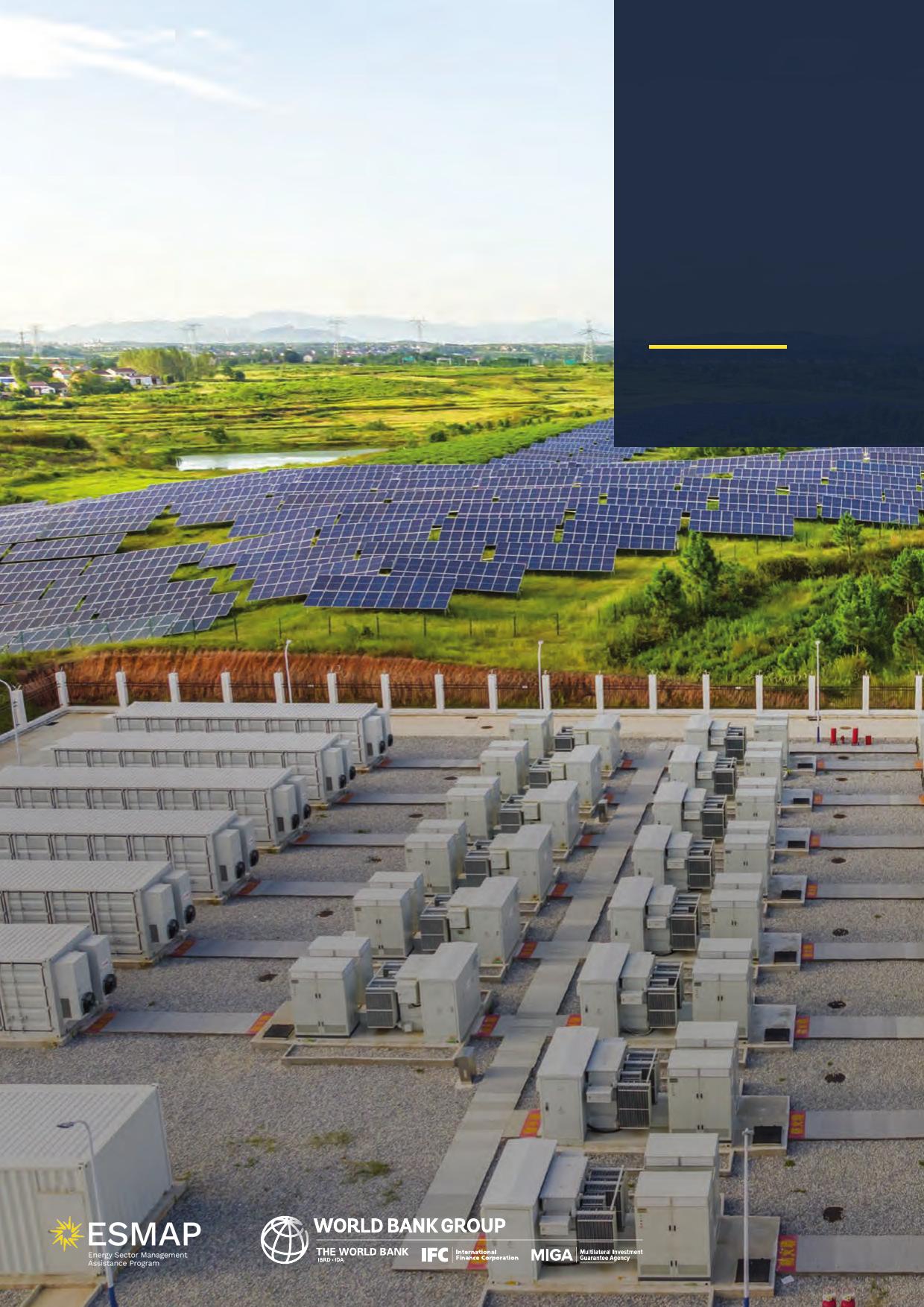PublicDisclosureAuthorizedPublicDisclosureAuthorizedPublicDisclosureAuthorizedPublicDisclosureAuthorizedREPORTUNLOCKINGTHEENERGYTRANSITIONGuidelinesforPlanningSolar-Plus-StorageProjectsFLAGSHIPREPORTUNLOCKINGTHEENERGYTRANSITIONGuidelinesforPlanningSolar-Plus-StorageProjectsAmitJainTalalKanaanLuizMaurerABOUTESMAPTheEnergySectorManagementAssistanceProgram(ESMAP)isapartnershipbetweentheWorldBankandover20partnerstohelplow-andmiddle-incomecountriesreducepovertyandboostgrowththroughsustainableenergysolutions.ESMAP’sanalyticalandadvisoryservicesarefullyintegratedwithintheWorldBank’scountryfinancingandpolicydialogueintheenergysector.ThroughtheWorldBankGroup(WBG),ESMAPworkstoacceleratetheenergytransitionrequiredtoachieveSustainableDevelopmentGoal7(SDG7)toensureaccesstoaffordable,reliable,sustainable,andmodernenergyforall.IthelpstoshapeWBGstrategiesandprogramstoachievetheWBGClimateChangeActionPlantargets.Learnmoreat:https://esmap.org©October2023InternationalBankforReconstructionandDevelopment/TheWorldBank1818HStreetNW,Washington,DC20433Telephone:202-473-1000;Internet:www.worldbank.orgThisworkisaproductoftheWorldBankGroup,withcontributionsgivenbythestaffandconsultantslistedintheacknowledgments.Thefindings,interpretations,andconclusionsexpressedinthisworkdonotnecessarilyreflecttheviewsoftheWorldBank,itsBoardofExecutiveDirectors,orthegovernmentstheyrepresent.TheWorldBankdoesnotguaranteetheaccuracyofthedataincludedinthiswork.Theboundaries,colors,denominations,andotherinformationshownonanymapinthisworkdonotimplyanyjudgmentonthepartoftheWorldBankconcerningthelegalstatusofanyterritoryortheendorsementoracceptanceofsuchboundaries.NothinghereinshallconstituteorbeconsideredtobealimitationuponorwaiveroftheprivilegesandimmunitiesofTheWorldBank,allofwhicharespecificallyreserved.RightsandPermissionsThisworkisavailableundertheCreativeCommonsAttribution3.0IGOlicense(CCBY3.0IGO)http://creativecommons.org/licenses/by/3.0/igo.UndertheCreativeCommonsAttributionlicense,youarefreetocopy,distribute,transmit,andadaptthiswork,includingforcommercialpurposes,underthefollowingconditions:Attribution—Pleasecitetheworkasfollows:EnergySectorManagementAssistanceProgram.2023.UnlockingtheEnergyTransition:GuidelinesforPlanningSolar-Plus-StorageProjects.ESMAPPaper.Washington,DC:WorldBank.License:CreativeCommonsAttributionCCBY3.0IGOTranslations—Ifyoucreateatranslationofthiswork,pleaseaddthefollowingdisclaimeralongwiththeattribution:ThistranslationwasnotcreatedbyTheWorldBankandshouldnotbeconsideredanofficialWorldBanktranslation.TheWorldBankshallnotbeliableforanycontentorerrorinthistranslation.Adaptations—Ifyoucreateanadaptationofthiswork,pleaseaddthefollowingdisclaimeralongwiththeattribution:ThisisanadaptationofanoriginalworkbyTheWorldBank.ViewsandopinionsexpressedintheadaptationarethesoleresponsibilityoftheauthororauthorsoftheadaptationandarenotendorsedbyTheWorldBank.Third-PartyContent—TheWorldBankdoesnotnecessarilyowneachcomponentofthecontentcontainedwithinthework.TheWorldBankthereforedoesnotwarrantthattheuseofanythirdparty-ownedindividualcomponentorpartcontainedintheworkwillnotinfringeontherightsofthosethirdparties.Theriskofclaimsresultingfromsuchinfringementrestssolelywithyou.Ifyouwishtore-useacomponentofthework,itisyourresponsibilitytodeterminewhetherpermissionisneededforthatre-useandtoobtainpermissionfromthecopyrightowner.Examplesofcomponentscaninclude,butarenotlimitedto,tables,figures,orimages.AllqueriesonrightsandlicensesshouldbeaddressedtoWorldBankPublications,TheWorldBankGroup,1818HStreetNW,Washington,DC20433,USA;e-mail:pubrights@worldbank.org.ProductionCredits—ProductionEditorHeatherAustinDesignerCircleGraphics,Inc.FrontCover©FeiYang/Moment/GettyImagesAllimagesremainthesolepropertyoftheirsourceandmaynotbeusedforanypurposewithoutwrittenpermissionfromthesource.ContentsAbbreviationsvAcknowledgmentsviForewordviiKeyFindingsixExecutiveSummaryxiAboutthisReportxviii1.TheTransitionfromThermaltoSolar-Plus-StorageProjects1TheTrendTowardHybridization1ComparingThermalwithSolar-Plus-Storage2LimitationsandChallenges42.IntroductiontoSolar-Plus-StorageProjects9ValueStackServices9PublicandPrivateAssetOwnershipModels10PricingModels11PotentialinSub-SaharanAfrica12PotentialinSmallIslandDevelopingStates123.TheFour-PhasePlanningFramework17Phase1:OverallSystemPlanning18Phase2:ProjectDefinitionandInitialAssessment22Phase3:AssessmentofBusinessModelOptions24Phase4:SelectionandImplementationofaBusinessModel404.Procurement55AuctionTypesbyBusinessModel56TheMechanicsofAuctionDesign585.Conclusions63References65AppendixA.AdvantagesandDisadvantagesofSelectedBusinessModels68AppendixB.TermSheetTemplate73AppendixC.PowerPurchaseAgreementTemplate78AppendixD.ComplementaryKnowledgeResources79UNLOCKINGTHEENERGYTRANSITIONiiiListofFigures,Tables,andBoxesFiguresFigure3.1:TheFourPhasesofPlanningSolar-Plus-StorageProjects17Figure3.2:DecisionTreeforSelectingaBusinessModel41TablesTable3.1:FeaturesofBusinessModelsUsedinSolar-Plus-StorageProjectContracts25Table3.2:ExamplesofProjectsthatAdoptedTwo-PartContracts26Table3.3:ExamplesofProjectsinHawai’ithatAdoptedaSingle-CapacityContract28Table3.4:ExamplesofProjectsthatAdoptedaBlendedEnergyContract29Table3.5:ExamplesofProjectsthatAdoptedTime-DifferentiatedRates35Table4.1:AuctionTypeandPrimarySelectionCriteria,byBusinessModel56Table4.2:SelectedOutcomesofCompetitiveProcurement,byBusinessModel59TableB.1:TermSheetTemplate74BoxesBox1.1:SouthAfrica’sHybridPowerProcurement5Box2.1:Maldives’TransitionfromThermaltoSolar-Plus-StorageProjects13Box3.1:E�xampleofaTwo-PartContract:Nevada’sNVEnergyBoulderSolarandStorageProject30Box3.2:E�xampleofaSingle-CapacityContract:TheMauiElectricRenewableDispatchableGenerationPowerPurchaseAgreement31Box3.3:ContainerizedRenewableLeaseSolutionswithConcessionContracting32Box3.4:E�xampleofaBendedEnergyContract:Hawai’i’sLawaiSolarandEnergyStorageProject33Box3.5:BurkinaFaso’sSolar-Plus-StorageProjectBusinessModelApproach34Box3.6:E�xampleofaBlendedEnergyContractwithTime-DifferentiatedRates:TheSolarEnergyCompanyofIndia’sPeakPowerSupplyPowerPurchaseAgreement36Box3.7:E�xampleofaBlendedEnergyContractwith24/7FirmPowerSupply:TheSolarEnergyCompanyofIndia39Box3.8:S�electingaBusinessModelforaSolar-Plus-StorageProjectinMaldives44Box3.9:I�nternationalFinancialReportingStandards1648ivCONTENTSAbbreviationsACalternatingcurrentASPIREAcceleratingSustainablePrivateInvestmentinRenewableEnergyBESSbatteryenergystoragesystem(s)CSPconcentratedsolarpowerDCdirectcurrentEPCengineering,procurement,andconstructionESMAPEnergySectorManagementAssistanceProgramESSenergystoragesystem(s)FiTfeed-intariffGWgigawatt(s)GWhgigawatthour(s)IFCInternationalFinanceCorporationIFRSInternationalFinancialReportingStandardsIPPindependentpowerproducerkWhkilowatthour(s)kWpkilowattpeakLDESlongdurationenergystorageMWmegawatt(s)MWhmegawatthour(s)MWpmegawatt(s)peakO&MoperationandmaintenancePPApowerpurchaseagreementPVphotovoltaicRMI4PRiskMitigationIndependentPowerProducerProcurementProgrammeRTCround-the-clockSCADASupervisoryControlandDataAcquisitionSIDSSmallIslandDevelopingStatesSRMISustainableRenewablesRiskMitigationInitiativeTWterawatt(s)VREvariablerenewableenergyAllcurrencyisinUnitedStatesdollars(US$,USD),unlessotherwiseindicated.UNLOCKINGTHEENERGYTRANSITIONvAcknowledgmentsThisreportwaspreparedbytheWorldBank’sEnergyStorageProgram,undertheEnergySectorManagementAssistanceProgram(ESMAP),togetherwiththeInternationalFinanceCorporation(IFC)andtheMultilateralInvestmentGuaranteeAgency(MIGA).DemetriosPapathanasiou,WorldBankGlobalDirectorEnergyandExtractives,andGabrielaElizondoAzuela,ESMAPPracticeManager,supervisedthepreparationofthereport.TheWorldBankteamcomprisedAmitJain,TalalKanaan,LuizMaurer,andChandrasekarGovindarajalu.IFC’steamincludedPeterMockel,DonPurka,andDurrehTabassum.RandelJohnsonandKeyurJigyasu,ofAcelerexInc.,providedextensiveinputsandresearchthatinformedthereport.Internalpeerreviewswereconductedatvariousstagesofthereportpreparation.TheteamisgratefultothepeerreviewersSabineCornieti,ZuzanaDobrotokva,ManiKhurana,ManuelMillan,MitsunoriMotohashi,andFredericVerdol.TheteamalsoappreciatesthecontributionsofIFCcolleaguesMahamIftikharWarraich,AndresGarciaNovel,andGuidoAgostinelliandMIGAcolleaguesJessicaEricksonStieflerandMarcusS.Williams.ThereportbenefitedfrominsightsprovidedbyAnilVijayachandran(ACWAPower),PraveerSinha(TATAPower),AjayMathur(InternationalSolarAlliance),JuliaSouders(LongDurationEnergyStorageCouncil),FrankWouters(RelianceIndustries),andAnadiJauhari(EmergingEnergy&EnvironmentInvestmentGroup).Itwasinformedbyvaluablediscussionswithprivatesectorentities,powerutilities,andgovernmentstakeholders.Thedraftreportwasdiscussedatvariousinternationalforums,includingtheG20,CleanEnergyMinisterial(CEM)meetingsinPittsburgh,andtheWorldBank’sAnnualMeetinginMarrakeshinOctober2023.viACKNOWLEDGMENTSForeword“Andwhatdowedowhenthesundoesn’tshine,andthewinddoesn’tblow?”Thishasbeentherecurring,mainconcern,ofourcolleaguesatenergyministriesandelectricityutilitiesaroundtheworld,whenwediscussthefactthatsolarandwindgeneratorscanprovidethecheapestkWhinmostpowersystems.Thisfundamentalquestionhasbeenholdingbacktheexpansionofcleanenergy.Asaresult,toomanycountriesarestillexposedtovulnerabilitiesassociatedwithfossilfuelsforelectricitygeneration.Butthermal‘dispatchable’powergenerationoftenresultsinveryexpensiveelectricity,lockingmanyoftheworld’spoorestcountriesintoaviciouscycleofpowersectordeficitsthatpreventinvestments,andheavysubsidiesthatleadtofiscalstressandfurtherindebtedness.Withthisreport,theWorldBankbeginstoaddresstheanxietiesof‘intermittent’solarandwind.Weintroduceacompleteframeworkthatoutlineshowmodernbatteryenergystoragesystemscanbeeffectivelydeployedandalleviatethevariabilityofrenewables.Moreover,thepaperisaccompaniedbyaPowerPurchaseAgreementtemplatethatcanserveasapracticaltooltobringprivatesectorinvestmentsinthepowersector–goingbeyondsolar,orwindparks,withvariableoutput.TheWorldBankestimatesthattechnologicaldevelopments,andtheexpansionofmanufacturing,havemadesolarpanelscombinedwithbatterystoragedirectlycompetitivewiththermalgenerationformanylocationsaroundtheworld.Thisapproachcanreducefossilfuelsdependencyinthepowersector,provideaffordableelectricity,andatthesametimereduceharmfulglobalandlocalemissions.BuildingonourglobalexperienceattheWorldBank,andwithinvaluablesupportfromourEnergySectorManagementAssistanceProgram(ESMAP),thisreportbringstogetherourknowledge,thinking,andexperience,onbusinessmodelsformodernenergystoragesystems.Wehopethatitwillbehelpfultoourenergysectorcolleaguesaroundtheworldintheireffortstoacceleratecleanenergyinvestmentsandmanagecosts.Goingforward,wewillworkwithourglobalknowledgepartnerstopreparetailoredtrainingprograms(batteryenergystoragesystemsacademies),wherewewillelaborateonhowtousethisreportandtheaccompanyingPowerPurchaseAgreement,tohelpaddresstheneedsofspecificcountriesandelectricitysystems.Weacknowledgethatthisisanareawheretechnologyismovingfast,costsaredynamic,andwherethereisrelativelylimitedknowledgeandexperience.So,thisisnotourfinalwordonthesubject,butratherabeginning.WeplantofurtheradvanceourunderstandingUNLOCKINGTHEENERGYTRANSITIONviiandupdatethecontentinthecomingmonthsandyears.Wewelcomecommentsandsuggestionsthatcanfurtherimproveouranswerstowhatdowecandotokeepthelightsonwhenthewindisnotblowing,andthesunisnotshining–withoutburningfuels.DemetriosPapathanasiou,GlobalDirectorfortheEnergyandExtractivesGlobalPractice,WorldBankMarcusS.Williams,GlobalHeadandSectorManagerforEnergy&ExtractiveIndustries,MultilateralInvestmentGuaranteeAgencyNamrataThapar,GlobalDirector(Acting)forEnergyandMining,InternationalFinanceCorporationviiiFOREWORDKeyFindings•Manydevelopingcountriesareexposedtovulnerabilitiesassociatedwithenergyimports,volatileprices,andfueldependency.Fossilfuel-basedthermalgeneratorshavedeepenedthefiscalcrisisinmanycountries,leadingthemintodebtdistresswhileperpetuatingaviciouscycleofpowersectorpovertytraps.•Deployingsolarandintegratingitwithenergystorageisaviable,cost-competitivealternativethathasthepotentialtoreducethedependencyonthermalgeneration,especiallywhenleveragingprivateinvestments.Solar-plus-storageprojectsshareseveraltechnicalandcommercialfeaturescommonlyassociatedwiththermalgenerationsuchasdispatchability,firmness(i.e.,constantavailability)ofsupply,capacitypaymentmechanisms,amongothers.•ThisreportdistillstheglobalexperienceoftheWorldBankandotherplayerswithprojectsthatcombinesolarenergygenerationwithenergystoragesystemsandprovidesaframeworkforplanningandexecutingthem.Theproposedprojectplanningtoolsaimtostreamlinetheadoptionofvariousbusinessmodelsforutility-scalesolar-plus-storageprojects,especiallyincountrieswherefueldependencyisdraininglimitedpublicresourcesanddeepeningthesovereigndebtcrisis.•Thereportoutlinesthreebusinessmodelsforsolar-plus-storagepowerpurchaseagreements(PPAs):atwo-partcontractforcapacityandenergy,acapacitycontract,andablendedcontract.Casestudiesillustrateeachbusinessmodelandidentifychallengesandopportunities.Theriskallocationandtechnicalconfigurationrequirementsoftheoff-takerandsystemoperatorinformstheselectionoftheappropriatemodel.•Severaldevelopingcountrieshaveusedthetwo-partcontract,whilethesuitabilityofthebusinessmodeldependsonthelocalcontext.Thetwo-partcontractmodelcanbeespeciallysuitableinsettingswhereelectricitymarketsdonotexist,dependenceonfuelforgenerationishigh,andonlypartialfirmnessanddispatchabilityisneeded.MostSub-SaharanAfricaandSmallIslandDevelopingStatesmeettheseconditions.Thechoiceofthebusinessmodeldependsondifferentvariablesassociationwiththelocalcontextofandapplication.•Afour-phaseguidedframeworkisproposedforplanningsolar-plus-storageprojects.Theframeworkcoversseveralrequirements,fromconductingthepreparatorystudiesonthelong-termleast-costplans,grid-integration,anddemandforecasts,toselectingandadaptingthesuitablebusinessmodelbasedonthecontextualrequirements,andfinallyimplementingtheprojectthroughcompetitiveprocurementmethods.Theselectionoftherelevantmodelisfacilitatedbyadecision-tree.TheframeworkiscomplementedbyaPPAandtermsheettemplate,whichcanbeadaptedbasedonthebusinessmodelanduse-caseapplied.AsamplePPAandtermsheetforaUNLOCKINGTHEENERGYTRANSITIONixtwo-partcontractisprovided.Withthehelpoftechnicalandtransactionadvisors,itcanbeadaptedtomeettherequirementsofspecificprojects.•Thereport’sready-to-useplanningframework,thedecision-makingtree,samplebusinessmodels,andthePPAtemplateaimtostreamlinetheadoptionofsolar-plus-storageprojectsthatleverageprivateinvestmentsincountrieswherefuel-dependencyisputtingstressonlimitedpublicresources.Solar-plus-storagecontractualmodalitiesareatanearlierstagethansolar-onlyPPAs.Thebusinessmodelsoutlinedinthisreportarethereforelikelytocontinuetoevolve.Practitionersanddecisionmakersareadvisedtoengagerelevanttechnicalandtransactionadvisorswhocanprovidethenecessarytechnical,legal,andcommercialguidanceonplanningandimplementationofsolar-plus-storagepowerprojects.Thetermhybridgeneration(orhybridprojects)referstoabroadsetoftechnicalconfigurationscombiningdifferentpowersources,includingfossil-basedgeneration,variousrenewableenergysources(windand/orsolar),andstorage.Thisreportfocusesprimarilyonthesolar-plus-storagesegmentofhybridprojects,specificallyonsolarphotovoltaicsystemsandbatteryenergystoragesystems(BESS).ThetermsstorageandBESSareusedinterchangeablyinthisreport.xKEYFINDINGSExecutiveSummaryManydevelopingcountriesfacevulnerabilitiesassociatedwithenergyimports,volatileenergyprices,andfueldependency.Expensivefuel-basedthermalgeneratorshavecontributedtofiscalcrisesinmanycountries,pushingthemintopowersectordebttraps.Theintegrationofrenewableenergywithenergystoragesystemsisacost-competitiveoptionthatcanenhancetheflexibilityofthegridwhileprovidingseveralbenefits,includingdispatchability,firmsupply,andancillaryservices.Thishasthepotentialtoreducedependencyonfuel-basedthermalgeneration,especiallywhenitleveragesprivateinvestmentunderalong-termpowerpurchaseagreement(PPA)withindependentpowerproducers(IPPs).Whilestillrepresentingasmallshareofthemarket,thenumberofrenewableenergyprojectsthatareintegratedwithabatteryenergystoragesystem,especiallysolar-plus-storageprojects,isgrowingrapidly.Thisreportseekstohelpdevelopingcountriesplanandimplementsuchprojectsasintegralcomponentsoftheirrenewableenergyprograms,therebyunlockingprivatecapitalandreducingdependenceonpublicfinance.Thereportfocusesprimarilyonutility-scalesolar-plus-storage,whetherthroughthecasestudiesorthebusinessmodelsproposed.ChallengesFacingSolar-Plus-StorageProjectsTransitioningfromthermaltosolar-plus-storageprojectsischallenging.Theseprojectsaremorecomplexthantraditionalenergyprojectsbecausetheyintegratedifferenttechnologies,eachwithitsownoperationalparameters,maintenanceneeds,andperformancecharacteristics.Solar-plus-storageprojectscanbedesignedinvariousways,dependingonthecharacteristicsoftheproductsandservicestobedelivered,thepreferencefordispatchabilityversusenergyfirmness,andtheallocationofriskbetweenbuyers(theutility,gridoperators,orthegovernmententity)andsellers(developersorIPPs).Thevarietyofoptionsresultsindifferentbusinessmodels,PPAsstructure,andprocurementmechanisms;itaddscomplexitytoprojectdesignanditstechnicalconfiguration;anditmakesitchallengingforstakeholdersandutilitiesindevelopingcountriestomakedecisionswithoutexpertguidance.Giventhecomplexitiesoftheseprojectsandtheneedtoattractprivatefinancing,itisimportanttodevelopacomprehensiveframeworkforstructuringandplanningsuccessfuloperations.Thisreportattemptstodojustthat.Thetrendtowardstorage,includingsolar-plus-storage,isgainingmomentum.Energystorageenjoyedanotherrecordin2022,adding16gigawatts(GW)/35gigawatthoursUNLOCKINGTHEENERGYTRANSITIONxi(GWh)ofcapacity,up68percentfrom2021.Bytheendof2030,globalcumulativeenergystoragecapacitywillreach508GW/1,432GWh,accordingtoprojectionsbyBloomberg.Astheseprojectscontinuetoevolveandgainmomentum,regulationsandpoliciesareneededtosupportsolar-plus-storageadoption.Regulatoryconstraintsinmanycountrieslimitrevenuestreams,makingitdifficulttojustifythehighupfrontcostsofstorage.However,theneedforrobustcommercialstructuresandupdatedregulationsandpoliciestosupportgrowthisbecomingincreasinglyapparent.TheFour-PhaseFrameworkThisreportpresentsafour-phaseframeworkforplanningsolar-plus-storageprojects(FigureES.1).FIGUREES.1TheFourPhasesofPlanningSolar-Plus-StorageProjectsPhase1Conductplanninganalysisandstudies:PLANNINGDemandandneedsassessmentOverallSystemLeast-costplanningandVREintregrationstudiesSTRATEGYPlanningInterpretingoutputsofplanninganalysisandstudies:IMPLEMENTATIONPhase2Potentialofsolar-plus-storageaspartofanoverallgenerationcapacitymixandinjectionpointsProjectDefinition&InitialDefinetheproject:AssessmentType,location,size,aswellasuse-casesandrequirementsPhase3Assessprojectrequirements:DispatchabilityorfirmnessrequirementsAssessmentofControlrequirementsandneedfortime-variantuseofBusinessModelenergyOptionsConsiderbusinessmodeloptions:Phase4Twopartcontract,singlecapacitycontract,blendedenergycontractSelectionandImplementationofAssesstheadvantagesanddisadvantagesofbusinessmodelsBusinessModelConsidervariationsofblendedenergycontractswith:Time-differentiatedratesand24/7firmpowersupplyDeterminemostsuitablebusinessmodelbasedonthedecisiontreeConsideradditionalfactorsforselectingthebusinessmodelIdentifyhybridizationrisksPrepareatermsheet,usingtheguidedtermsheettemplatePrepareandimplementaprocurmentstrategyDevelopandImplementSolar-Plus-StorageProjectPowerPurchaseAgreementxiiEXECUTIVESUMMARYThefirstphasefocusesonoverallsystemplanning.Itincludestechnicalplans,suchasleast-costplanningandrenewableenergyintegrationstudies,thathelpacountrydetermineitspotentialforsolar-plus-storageaspartofitsfutureenergyandgridneeds.Thesecondphasedefinestheprojectbasedonadetailedanalysisofthecountry’spowersystemneedsandexpansionplans.Thisphasecharacterizesusecases,thesizingoftheproject,andthesystemrequirementsintermsofdispatchabilityandenergyfirmness.Thethirdphaseidentifiesbusinessmodelsthatmeetproject-specificrequirementsandhighlightsdifferencesamongthemthroughexamples.Structuringbankablesolar-plus-storageprojectsiskeytofinancingcleanenergyprojectsandensuringtheirlong-termviability.Thechoiceofmodeldependsonthedesiredriskallocationandtechnicalconfigurationrequirementsoftheoff-takerandsystemoperator.Thereportdescribesthreemainbusinessmodels(outlinedinTableES.1):(1)atwo-partcontractthatchargesanenergypaymentbasedonenergyusedandacapacitypayment;(2)asinglecapacitycontractthatchargesbasedonajointsolarandstoragecapacity;and(3)ablendedcontract,whichincludesseveralvariations.Itidentifiesthechallengesandopportunitiesassociatedwitheachmodelandprovidescasestudiesforeach.Italsoidentifiesprocurementoptionsthatspurcompetition,leadingtobetterserviceandlowerrates.Thefourthphaseprovidesadecisiontreetohelppractitionersevaluatethetrade-offsinvolvedinselectingabusinessmodel(FigureES.2).Duringthisphase,projectdesignersneedtoidentifyandallocatetherisksassociatedwiththeproject.UNLOCKINGTHEENERGYTRANSITIONxiiiTABLEES.1ThreeBusinessModelsforSolar-Plus-StorageProjectsFEATURESCONTRACTTYPETWO-PARTCONTRACTSINGLE-CAPACITYBLENDEDENERGYCONTRACT(SOLARPV-PLUS-STORAGE)CONTRACTAstateutilityoracentralpro-InvolvedEntitiesAstateutility,likelythegridAstateutility,likelythegridcurementagency,reassigningoperatoroperatorcontractstoutilitiesRenewableEnergyandSinglecontract,twotypesofSinglecontract,singlefixedSinglecontract,singlefixedStorageRemunerationpayment:paymentbasedonavailablepaymentbasedonenergycapacity($/MW/month)produced($/MWh);noexplicit•PaymentforPVisforenergycapacitypaymentaproduced($/MWh)•Paymentforstorageisforcapacitymadeavailable($/MW/month)VariationsN/AN/A•Simpleblended•Time-differentiatedrates(peakandoff-peak)•24/7firmpowersupplyEmphasisDispatchabilityDispatchabilityFirmnessDispatchDecisionMakerBuyerBuyerSellerorsystemoperatorOperationandMaintenanceSeparateO&MentitySeparateO&MentitySeparateO&MentityorthesellerSuitabilityofStorageHighHighLow,asthesellerhascontrolServicesofthestorageassetsRiskAllocation:ResourceOnsellerOnbuyerOnsellerVariabilityRiskAllocation:CurtailmentOnbuyerOnbuyerMoreonbuyerRiskAllocation:MarketOnbuyerOnbuyerOnbuyerVariabilityCommercialandTechnicalVeryhighHighLowforcommercialcharacter-SimilaritiestoThermal-istics;somesimilaritiesbasedGenerationPPAsontechnicalspecificationsofthesolar-plus-storageprojectProcurement/AwardCriteriaTwoproducts,simultaneousOneproduct,awardbasedon•Blendedsimpleand24×7:auctionawardpossiblybasedonlowest$/MWOneproductawardbasedlevelizedcostofelectricity(LCOE)onlowest$/MWh•Time-differentiated:Twoproducts,simultaneousauction,averagepeak/offpeakpriceaThispricingassumesthatallresourcevariability,fuelcostsvolatilityandmarketriskshavebeentrans-ferredfromthesellertothebuyer.Powerpurchaseagreements(PPAs)inotherjurisdictionsmayhavemorenuancedpricingstructureswherebysomeofrisksremainwiththebuyer,andafixedplusvariablepaymentstructureisadvisable.xivEXECUTIVESUMMARYFIGUREES.2DecisionTreeforSelectingaBusinessModelInitialAssessmentNoQ1.IsfirmorYesquasi-firmBuyerrequirespoweraPPAwillspecifythedispatchabilitywithenergyprofilingandmaximumcontrolofrequirement?thecontractualthehybridprojectlevelsofreliabilityassetsQ2.DoesNoQ3.DoesbuyerbucyoenrtrreoqluofireYesrequiretimeItisasinglepriceperbasedfirmVRE?MWhfortheenergypower?generated(orNodeemed)bytheVRETheprojectandBESS,irrespectiveYesrequiresfirmofthetimeofproductionpoweratcertaintimesQ4.Doesbuyerrequirepowersupplyduringpeakperiod?Time-of-useTheprojectYesrtoatmeiostiavpapteliethdeNogauvaairlaabnitleiteysoftheenergypowersupplythatavailabilityforisobligatedunderspecifichoursthecontracttoofadaysuchprovideforaaspeakperiodcertaindurationTwo-partSingleBlendedTime-24/7FirmContractCapacityEnergyDifferentiatedPowerSupplyContractContractRatesAdditionalConsiderationsUNLOCKINGTHEENERGYTRANSITIONxvTheTermSheetandPowerPurchaseAgreementTemplatesToprovideamoregranularillustration,oneofthebusinessmodelsthereporthighlightsisthetwo-partcontractmodel.ItprovidesatermsheetandaPPAtemplateforthisbusinessmodelwithguidanceforuseandimplementation.Thetermsheettemplatedelineatestherights,obligations,andexpectationsofallparties,therebyreducingambiguityandpotentialdisputesandfacilitatingdiscussionswithpotentialinvestors.Itisparticularlyimportantgiventhenascentstageofmanysolar-plus-storageprojectfinancingstructures.ThePPAtemplatedescribeskeyclausesthatshouldbeincludedinaPPAunderonetypeofbusinessmodel.Itisdesignedasastartingpoint,notadocumentthatshouldbeusedasis.AllPPAswillneedtobecustomized,withthehelpofexpertlegaladvisors.ThePotentialofSolar-Plus-StorageProjectstoFacilitateTransformationalChangeSolar-plus-storageprojectshavethepotentialtorevolutionizetheenergylandscapebyreducingdependencyonimportedfossilfuelsandenhancingenergysecurity,particularlyinSmallIslandDevelopingStatesandSub-SaharanAfrica.Withincreasedenergysystemresilienceandthemobilizationofprivateinvestment,solar-plus-storagethroughacompetitivelyprocuredIPPmodelcanfreeuppublicresourcestoberedeployedforotheressentialservicesanddevelopmentinitiatives,supportingeconomicstabilityandgrowth.xviEXECUTIVESUMMARYAboutthisReportPurposeofthisReportEnergystorageisakeycomponentinthetransitionfromthermaltorenewableenergy-basedpowersystems.Itallowsexcesselectricitygeneratedfromvariablerenewableenergy,suchassolarandwind,tobestoredforuseduringperiodsofhighdemandorlowsunlight,increasingthereliabilityandavailabilityofrenewableenergy.Byreducingrelianceonfossilfuels,ahybridproject—asystemthatcombinesrenewableenergywithanenergystoragesystem—facilitatesthetransitiontoacleaner,morestable,andmorecost-competitiveenergysystem.Thisreportprovidesaguidingframeworkforplanningandimplementingutility-scalesolar-plus-storageprojectswhileleveragingprivateinvestments.Theframeworkincludesfourphases,whichcoverthe(1)identificationandplanningofaproject,(2)selectionofabusinessmodelfrompre-setconfigurations,(3)adaptationofthemodel,and(4)useofaPPAtemplateinacompetitiveprocurementprocess.Thereportaimstostreamlinetheadoptionanddeploymentofprivatelyownedsolar-plus-storageprojects,especiallyincountrieswhererelianceonthermalgenerationisdeepeningtheirvulnerabilityanddeficits,andlimitedpublicresourcesaredrainedinaviciouscycleoffueldependency.Thereportalsoprovidesprocurementoptionsthatcanleadtocompetitionandoptimaltariffs.StructureofthisReportThisreportisstructuredasfollows:•Chapter1presentstherationaleforthetransitionfromthermaltorenewableenergyprojectscombinedwithenergystorage.Ithighlightshowspecificallysolar-plus-storageprojectscanhelptodecarbonizepowersystems.•Chapter2introducesthebusiness-as-usualscenarioofpubliclyownedsolar-plus-storageprojectsandtheglobaltrendtowardIPPsownedprojects.•Chapter3presentsafour-phaseframework,consistingofoverallsystemplanningandguidelinesforselectingabusinessmodel,understandingtheadvantagesanddisadvantagesoftheselectedmodel,andpreparingatermsheetandPPA.•Chapter4providesguidelinesforthecompetitiveprocurementofasolar-plus-storageproject.•Chapter5discussestheguidelinesandconclusionsofthereport.•AppendixApresentsacomprehensivelistoftheadvantagesanddisadvantagesofeachofthethreebusinessmodelsandtheirvariations.xviiiABOUTTHISREPORT•AppendixBprovidesatemplatetermsheetforatwo-partcontractbusinessmodel.Itprovidesguidanceonhowtostructurethetermsheettoensurethatallnecessarycomponentsareincludedandproperlyaddressed.•AppendixCprovidesalinktoaPPAtemplatedevelopedforthetwo-partcontractbusinessmodelconsideredinthisreport.•AppendixDprovidesadditionaldetailsoncomplementaryknowledgeresourcesfromtheEnergySectorManagementAssistanceProgram(ESMAP)tofacilitatetheenergytransition,especiallyresourcesonscalinguprenewablesandenergystorage.ThisreportbuildsonseveralotherWorldBankpublications,includingScalingUptoPhaseDown:FinancingEnergyTransitionsinthePowerSector(WorldBank2023b),theSustainableRenewablesRiskMitigationInitiative(SRMI)framework’sASurePathtoSustainableSolar,Wind,andGeothermal(WorldBank2022),DeployingStorageforPowerSystemsinDevelopingCountries:PolicyandRegulatoryConsiderations(ESMAP2020),andGuidelinestoImplementBatteryEnergyStorageSystemsunderPublic-PrivatePartnershipStructure(Gamarraetal.2023).AnnexDprovidesdetailsontheseresources.Endnote1.T�hetermhybridgeneration(orhybridproject)referstoabroadsetoftechnicalconfigurationscombiningdifferentpowersources,includingfossil-basedgeneration,variousrenewableenergysources(windand/orsolar),andstorage.Thisreportfocusesonthesolar-plus-storagesegmentofhybridprojects,specificallyonbatteryenergysystems(BESS).ThetermsstorageandBESSareusedinterchangeably.UNLOCKINGTHEENERGYTRANSITIONxixONETHETRANSITIONFROMTHERMALTOSOLAR-PLUS-STORAGEPROJECTSAwaveofchangeissweepingacrosstheenergysector,drivenbytheneedforcleaner,decarbonized,andmoreefficientenergygenerationandconsumption.Thisshiftfromthermaltosolar-plus-storageprojectsrepresentsatransformativephaseintheglobalenergyparadigm.Itreflectsnotjusttheemergenceofnewtechnologybutasocietalshift.Changeisbringingmodernsourcesofpowertopreviouslyunservedpopulationsandhelpingcountriesmeettheirclimatetargets.Electricitydemandindevelopingcountriesisrising;demandinthesecountriesisexpectedtogrowmorerapidlythananywhereelseinthenext20years.By2040,electricitywillsupply31percentoftheworld’sultimateenergyneeds,mostlybyreplacingfossilfuelsinbuildings,industries,andtransport(IEA2022).Enhancedelectrification,thewidespreaduseofrenewables,andincreasedenergyefficiencymeasuresarethethreemaincomponentsfordecarbonizingthepowersector.Eachfacesuniquechallenges.1Thepotentialofsolar-plus-storageprojectscanaddressseveralofthechallenges.Transitioningdirectlyfromthermaltorenewableenergypresentschallenges,particularlyinregionswithsmallandweakpower(grid)systems.Renewableenergyresourcesareclimateneutral,sustainable,andproducenogreenhousegasesduringoperation,buttheiroutputisvariable,makingitdifficulttoensureastableandreliablepowersupply.Solar-plus-storagecanofferamoreviablesolution.Theyallowexcesspowergeneratedduringperiodsofhighoutputofrenewableenergytobestoredforusewhenrenewableenergyoutputislow.Theabilitytostoresomeofthepowergeneratedenhancesthedispatchabilityandfirmnessofpowergenerators,enablingthemtosupplypowerondemandwhileprovidingamorereliableandstablepowersupply.Thischapterexaminesthehybridizationtrend,comparesthermalandsolar-plus-storagegenerationprojects,explorestheadoptionandeconomicviabilityofsolar-plus-storageindevelopingcountries,aswellasthechallengesembeddedinthetransitionfromthermaltorenewableenergyprojects.TheTrendTowardHybridizationThetrendtowardhybridizationwithsolar-plus-storageisgainingmomentumglobally.Accordingtothe2023BloombergEnergyStorageMarketOutlook,energystorageenjoyedanotherrecordyearin2022,adding16gigawatts(GW)/35gigawatthours(GWh)ofcapacity,up68percentfrom2021.Bloombergprojectsthatbytheendof2030,globalcumulativeenergystoragecapacitywillreach508GW/1,432GWh.ItestimatesthatenergystorageinstallationinChinaalonewillreach175GW/404GWhin2030,up66percentcomparedtothepreviousestimate.HybridprojectsarealsogainingmomentumintheUnitedStates.Itisestimatedthataround42percent(285GW)ofallUNLOCKINGTHEENERGYTRANSITION1solarPVand8percentofallwindininterconnectionqueuesareproposedashybridprojectscombinedwithstorage.Solar-plus-storagecurrentlydominatesthehybriddevelopmentpipeline.(Bolinger,Gorman,etal.2022).InMorocco,theNoorMideltproject,commissionedin2019,providesdispatchableconcentratedsolarpower(CSP)forfivehoursaftersunsetforpeakhours,showcasingthepotentialofhybridprojectsinbalancinggriddemand(MASEN,2022).Theprojectachievedanimpressivetariffof$71/MWh,demonstratingthecostcompetitivenessofhybridrenewables-plus-storageprojects.Indiahasalsomadestridesinadoptinghybridprojects.A2020projectprovided600MWoffirmpowerforpeakhoursfor6hoursandanother300MWoffirmpowerfor11hours,withoff-peakpoweratafixedprice(SECI2022b).Anotherinitiative,theRound-the-Clock(RTC)IIIproject,tenderedin2022,added2.25GW,withrequirementofmaintaining90percentavailability,demonstratingthecosteffectivenessandreliabilityofhybridrenewables-basedprojects.India’s2023–24budgetprovidesfundingfor4GWhofgrid-scalebatteries(IndianMinistryofNewandRenewableEnergy2023).In2021,SouthAfricatenderedabout2GWoftechnologyagnostic,emergencycapacity,undertheRiskMitigationIPPProcurementProgram(RMI4P)tobe100percentdispatchablebetween5:00a.m.and9:30p.m.Ofthisamount,about1.2GWcamefromnaturalgasgenerationcapacityand0.8GWfromhybridprojects(RepublicofSouthAfrica2022).Theseexamplesrevealtheglobaltrendtowardhybridprojects,drivenbytheirpotentialforimprovedgridstability,costcompetitiveness,andenhancedutilizationofrenewableenergyresources.Astechnologycontinuestoadvance,andregulatoryframeworksevolvetobettersupportthesesystems,hybridprojects,particularlysolar-plus-storagewillplayanincreasinglycentralroleglobally.ComparingThermalwithSolar-Plus-StorageFossilfuel-basedthermalprojectsmayhavelowercapitalcoststhansolar-plus-storageprojects.Thermalgenerationissupposedtoprovidepredictableandstableenergyoutput,withrelativelyhighdispatchabilityandresponsivenesstodemand.Stationarythermalplantsinmanycountrieshavebeenpoorlymaintained,reducingthefunctionallyavailablecapacityforthesystemoperator.Frequentbreakdownsandpoorperformance,coupledwithveryhighcosts(especiallyfordiesel-andheavyfueloil-basedgeneration)andassociatedpricevolatility,resultedinenergyvulnerabilitiesinmanycountries.Thisrelianceonexpensivedieselandheavyfueloilsplacesastrainonthesecountries’publicfinances,increasingtheirdeficits.Addressingthedrawbacksofthermalgeneration,solarphotovoltaic(PV)pairedwithstorageispotentiallyasuperioroption.Eventhoughthecapitalcostsoftheseprojectsarehigher,theiroperationalcostsaremuchlower—withnodependenceonfuelimports.Theshifttosolar-plus-storageprojectscanfreeuppublicresourcesfor2THETRANSITIONFROMTHERMALTOSOLAR-PLUS-STORAGEPROJECTSotheressentialservicesanddevelopmentinitiatives,increasingeconomicstabilityandgrowth,especiallywhendevelopedthroughacompetitiveIPP-ownedmodelbasedonlong-termPPAs.Solar-plus-storageprojectsoffersmoreflexibilitytothesystemoperator,becauseitcanprovidearangeofancillaryservices.Theyallowsolargenerationtobeoptimizedtodischargepowertothegridduringperiodsofpeakemissionsintensity,reducingtheneedforfossilfuel-basedenergysourcesandsupportingbroaderdecarbonizationefforts.Theseprojectscanalsofacilitategridbalancing,byleveragingflexiblecapacityforsystem-leveloptimizationevenwhenitisnotneededforload-matchingrequirements.Thisapproachenablesmoreeffectivedecarbonizationoftheelectricitygridandhelpssupportthetransitiontoalowcarbonfuture.Solar-plus-storageprojectsalsohaveseveralothertechnicaladvantagesoverthermalplants.Unlikethermalgenerators,theyoperatewithoutanyminimumloadrequirements,enhancingtheiroperationalflexibility.Unlikethermalgenerators,whichconstantlyburnfueltostaysynchronized,solar-plus-storageprojectsmaintaingridsynchronizationevenwhennotactivelygeneratingpower.Thisdifferenceresultsinsubstantialfuelsavingsandreducesenvironmentalimpact.Solar-plus-storageprojectshavequickstartuptimes,enablingthemtopromptlyrespondtodemandandfrequencyfluctuationswithoutburningfuel.Theseprojectsalsomaintainconsistentefficiencyatalloutputlevels.Solar-plus-storageprojectsalsoaddressthephenomenonknownastheduckcurve.Inpowergridswithhighlevelsofinstalledsolarcapacity,largeimbalancescanoccurbetweenelectricitysupplyanddemandthatresultinadropinnetdemandduringmiddayhours,whensolargenerationishigh,followedbyasharpincreaseindemandasthesunsetsandsolargenerationdecreases.Batterystorageinsolar-plus-storageprojectscanhelpmitigatetheduckcurvebystoringexcesssolarenergygeneratedduringthedayandthendischargingitduringeveningpeak-demandperiods.Doingsoallowsutilitiestobetterbalanceelectricitysupplyanddemand,reducingtheneedforothersourcesofelectricity,suchasfossilfuels.Storagecanalsoprovideotherancillaryservicestothegrid,suchasfrequencyregulationandvoltagecontrol,whichcanimprovethestabilityandreliabilityoftheelectricgrid.Alloftheseadvantagesmakesolar-plus-storageprojectsacompellingalternativeforcountriesseekingtotransitionawayfromthermal-basedpowersystems.CompetitivenessofSolar-Plus-StoragewithThermalGenerationInmanycountriesthatimportfuelforelectricitygeneration,tariffscanbeveryhigh,becauseofimportcosts,inefficiencyofgeneration,andassociatedchallenges.Suchenergyexpendituresoftendrainpublicfundingandraisethecostsofmanygoodsandservices.Forexample,electricitytariffsinmanyPacificIslandcountriesrangefrom$0.20/kWh(Fiji)to$0.50/kWh(VanuatuandtheCookIslands).IntheCaribbeanIslands,tariffsare$0.20/kWhinBelizeandSt.Lucia,around$0.40/kWhinCaymanIslands,andabout$0.60/kWhinBermuda.Similarly,inmanySub-SaharanAfricancountries,fuel-basedthermalgenerationisoneofthemainsourcesofelectricity;tariffstherearecomparabletothoseintheislandUNLOCKINGTHEENERGYTRANSITION3countriesinthePacificandCaribbean(IslamandAlMamum2017).Inbothcategories,solar-plus-storageprojectsarealreadyverycostcompetitiveandcanmeetthetechnicaloperationalrequirementsandcommercialfeaturescommonlyofferedbyfuel-basedthermalgeneration.TheHawai’i’sBarbersPointsolar-plus-storageprojectwasawardedaPPAwithatariffof$0.112/kWh,underasingle-capacitycontractmodelthatwouldintegrate15MWpofsolarwithfour-hoursofstoragecapacityat15MW/60MWh.However,theprojectisbeingrevisedduetofinancialandtechnicalchallenges,andanewbiddingprocessmaybeinitiated.InMorocco,theNoorMideltproject,whichcombinessolarPVwithCSPandfive-hourthermalstorage,achieveda$0.07/kWhtariff,underablendedcontract.InIndia,SolarEnergyCorporationofIndia(SECI)PeakPowerSupplyprocurementforrenewables-plus-storageprojectawardedtwocontractsthatpermittheintegrationofrenewables(solarorwind)withstoragecapacityforfirmpower.Thefirstcontractawarded900MWtoGreenko,atatariffof$0.086/kWhforpeakperiodand$0.04/kWhforoff-peakperiod.Thesecondcontractawarded300MWtoRenewPower,atatariffof$0.096/kWhpeakperiodand$0.04/kWhoff-peakperiod.LimitationsandChallengesSolar-plus-storageprojectshavethepotentialtoreducecarbonemissionsandrelianceonfossilfuelsinmanycountries.Butcompletelyreplacingbaseloadthermalpowergeneration(withmaximumpenetration)throughsolar-plus-storageisnotalwayspracticaloreconomicallyviable,especiallyintheshorttomediumterm.However,inmanycontextswherecountriesdependonfuel-basedthermalgeneration,solar-plus-storagehasalreadybecomecheaperthanothersources,offeringthesameflexibilityandreliabilityinthepowersystem.Oneofthedisadvantagesofsolar-plus-storageprojectsisthatinordertomaximizethedisplacementofthermalpowergeneration,theymustbeoversizedtocompensateforvariationsinresourceavailability.Addingsolarandstoragecapacityincreasestheinitialcostofasystem.Oversizingalsopresentsoperationalchallenges.Duringperiodsofhighsolarproductionandlowdemand,theexcessgeneratedpowercanexceedthestoragecapacityofthefacility,necessitatingcurtailmentofthePVoutput.Thiswasteofpotentialenergyisinefficientanddecreasesthereturnoninvestmentofthesystem.Thelifecycleofthestoragecanalsobealimitingfactor.Overtime,batteriesdegrade.Replacingorupgradingthemaddstotheoperatingcostsofthesystem;failingtodosocanjeopardizetheconsistencyofthepowersupply.Thesolutioniseithertoreplacethemoraugmentthem,toensurethatstorageavailabilitycontinuestobewithinanacceptable4THETRANSITIONFROMTHERMALTOSOLAR-PLUS-STORAGEPROJECTSrange,asdefinedintheoriginalagreementwhilemeetingthetechnicalrequirementsoftheoperator.SouthAfrica’sRiskMitigationIndependentPowerProducerProcurementProgramme(RMI4P)illustratesthechallengesofimplementingsolar-plus-storageprojectstoprovideenergywithveryhighlevelsofenergygenerationfirmness(i.e.,thecontrollableandreliableabilitytoproduceelectricityandmeetcustomerrequirementsatanypointintime)toreplacebaseloadgeneration(Box1.1).BOX1.1SOUTHAFRICA’SHYBRIDPOWERPROCUREMENTSouthAfricaisincriticalneedofnewpowergenerationcapacitytoclosethesupplygap(projectedtoreachabout6GWin2024),improvetheinvestmentclimatethroughreliablepower,andimplementitsplanstodecommissioncoal.Toaddressthesechallenges,thegovernmentorganizedatechnology-agnosticprocurementprocessviaauctions.TheRiskMitigationIndependentPowerProducerProcurementProgramme(RMI4P)auctioned2GWofcapacity.Bidsweresubmittedfor5,000MW,demonstratinginterestintheprogram.Winningpricesintheauctionrangedfrom$89/MWhto$115/MWh,averaging$97/MWh.Therequestforproposalwasdesignedtomeetflexibledispatch.Powerplantsneededtobe100percentdispatchablebetween5:00a.m.and9.30p.m.Runcontractedcapacitywassetfor16.5hoursadayfor15consecutivedays,withinterruptionsofnomorethan12hours.Biddersconsideredthisreliabilityrunrequirementverystrict,particularlybecausethestoragecouldnotchargefromthegridatnight.MostofthewinningbidswereorganizedashybridprojectscombiningPV,wind,andstorage,withadieselgeneratorbackuptomeetthestrictreliabilityrequirements.Onlyonedeveloper(Scatec)blendedrenewableenergywithstorage,whichalsomadeiteligibleforclimateconcessionalfinance.Thereliabilityrunrequirementisthecriticalfactordeterminingthesizingofrenewableenergyandstoragecapacity.Whenhighlevelsofdispatchabilityarenecessaryusingonlycleanenergysources,suchasrenewableenergyandastorage,generationandstorageassetsmustbeoversized,resultinginalesscompetitivePPA.(continues)UNLOCKINGTHEENERGYTRANSITION5BOX1.1(Continued)Toachieve150MWofdispatchablecapacitytomeetSouthAfrica’sstandards,Scatecwillhavetoinstall540MWofPVcapacityand225MW/1,140MWhofbatterystoragecapacity,atatotalcapitalexpenseof$962million(Scatec2022).Scatecresultedinoneofthehighesttariffs,calculatedat$115/MWh,asitdidnotincludeanythermalgenerationtomeetreliabilityrequirements,relyingcompletelyonsolarpowerplusstorage.TheRMIP4caseillustratesthechallengesandhighcostsofreplacingbaseloadgeneration(inthiscasecoalplants)withrenewables-onlysources,particularlyifhighlevelsofreliabilityarerequiredfromeveryindividualPPAratherthanaggregatedatthegridlevel.Itiscrucialtodetermineappropriatereliabilitycriteriainsuchtenders,astypicallythermalplantshaveareliabilityrequirementof85percentwhereasRMI4Pprogramhadmuchhigherrequirements.Sources:ADB2021;Scatec2022;RepublicofSouthAfrica2022(https://www.ipp-rm.co.za/).Note:TheawardcriteriaandthepayoutfortheRMI4PprograminSouthAfricaaremorecomplexthanatypicalauctionforatimedifferentiatedPPA,inwhichbiddersprovideblendedenergypricesforpeakandoff-peakhours($/MWh).ForRMI4P,prices(tariffs)areusedtoselectandawardthewinningbiddersanddeterminethemonthlypayout.Theyarecalculatedbytheauctioneer,basedontechnicalandeconomicparametersinformedbythebidders.Theevaluationpriceisaweightedaverageofthecalculatedelectricitytariff(ET)(95percent)andtheancillaryservicestariff(AT)(5percent).TheETconsidersseveralcostcomponents,includingenergy,fuelcosts(ifapplicable),capitalrecoveryforthedependablecapacity(50percentfornon-dispatchableand100percentfordispatchablegenerationsources),andcapitalrecoverycostsofmandatoryancillaryservices.Theeconomicassumptionsprovidedbythebidderswerecomparedwithdomesticandinternationalbenchmarksandadjustedasneeded.TheETiscalculatedbasedon70percentand100percentloadfactors;thetwofiguresareaveragedtocalculatethefinalevaluationprice.Oncethetariffiscalculated,biddersaregiventheoptiontosubmitabestandfinaloffer.Thetotalpaymentinabillingperiodincludescostrecoveryforcapacity,fixedandvariableoperationsandmaintenance(O&M),commercialenergypayment,start-upcosts,carbontaxes,andancillaryservicecost,whicharecalculatedbasedoneconomicassumptionsprovidedbythebidders.Evaluationpricesandtariffsarecalculatedseparatelyforeachtechnology.Themethodologyusedtodeterminepricesbearssomeresemblancetoatraditionalcost-plusschemebutintroducespricecompetition.Barrierstoutilitiesimplementingsolar-plus-storageprojectsincludethecomplexitiesofoperationalcontrol,thelackofautomatedinfrastructureforSupervisoryControlandDataAcquisition(SCADA)systems,andthelimitedtechnicalcapacityofthesystemoperator.Toworkaroundthesechallenges,solar-plus-storageprojectscouldbedesignedtoprovideautonomousservicesthatdonotrelyonlocalmeasurementsofmeteredrealpower,reactivepower,voltage,andfrequency.Technically,suchpowerplantscanfunction6THETRANSITIONFROMTHERMALTOSOLAR-PLUS-STORAGEPROJECTSeffectivelywithoutrequiringsupplementaryinputsfromthesystemoperator.Inconjunctionwithautonomouscontrol,theutilitycanprovidepowerschedules,voltagesetpoints,orcurtailmentsignalstofinetunethedispatchofsolar-plus-storageprojects.Theprimaryadvantageofautonomouscontrolsforsolar-plus-storageprojectsliesintheircapabilitytoprovideserviceswithoutcomplexutilitysoftwareandcommunicationsystemstocontroltheresources.Thebestapproachisablendofautonomouscontrolandutility-providedcontrolsignals.Thesechallengescanbeconstraining,butthepotentialbenefitsofsolar-plus-storageprojectsaresignificant.Theprocessoftransitionmaybegradualandrequireovercomingbarriers.Itwillneedsupportivepolicyandregulatoryframeworks,capacitybuilding,andinnovativefinancingmechanisms.Withtherightstrategy,thesechallengescanbeaddressed,especiallywhenconsideringadequatetechnicalconfigurationsthatareconsistentwiththecontrolandoperationalcapabilitiesoftheutilitywhilemeetingthegrid’srequirementsforreliabilityandflexibility.Itisimportanttoapproachtheenergytransitionwithabalanced,multifacetedstrategy.Thermalpowergenerationmaystillhavearoletoplay,particularlyinprovidingbaseloadpowerandensuringthestabilityofthegrid.Thegoalshouldbetofindtheoptimalmixofenergyresourcesthatbestmeetstheneedsandcontextualconditionsofeachregionandcountry.Endnote1.�Enhancedelectrificationistheprocessofexpandingtheuseofelectricityacrosssectorstoreducerelianceonfossilfuels,formobility,heating,orotherapplications.UNLOCKINGTHEENERGYTRANSITION7TWOINTRODUCTIONTOSOLAR-PLUS-STORAGEPROJECTSValueStackServicesTheeconomicviabilityofsolar-plus-storageprojectsdependsonvariousfactors,includingtechnologycosts,operationalcharacteristics,andregulatoryframeworks.Overthepastdecade,thecostsofPVpanelshavedecreasedsignificantly.Storagecostsfollowedasimilartrajectory,whichwasinterruptedbytheCOVIDcrisisandsupplydisruption.Itisexpectedthatstoragecostswillcontinuetodecline,thankstoeconomiesofscale,reducingoverallcostsandmakingsolar-plus-storageprojectsmorecompetitive.Solar-plus-storageprojectsofferseveralbenefitsoverstandalonesolarpowerprojectsthatcansignificantlyaffectthetechnicalandeconomicfeasibilityofaproject:•Energyshifting:Energyshiftinginvolvesstoringexcesssolarenergygeneratedduringthedayandusingitduringperiodsofhighenergydemand(pricearbitrage).Duringtimesofpeaksolargeneration,theexcessenergycanbestoredinbatteriesinsteadofbeingcurtailedforlateruse.Itcanthenbedispatchedwhendemandforelectricityishigh,suchasintheeveninghours.Energyshiftingcanmaximizetheuseofrenewableswhilecontributingtogridstabilityandresilience,makingrenewablesavaluablealternativetofossil-basedgeneration.Energyshiftingisconsideredtheprimaryusecaseofenergystorage,representing54percentofglobaldeploymentsin2022(BloombergNEF2023).•Commercialandresidentialuse:ByintegratingsolarPVwithstoragesystems,businessesandhomeownerscangeneraterenewableenergyon-site,reducingtheirrelianceonthegridanddecreasingelectricityexpenses.Excessenergygeneratedduringlowdemandperiodscanbestoredandusedduringpeakhours,reducingelectricitybillsandavoidingpeakdemandcharges.Inadditiontothebenefitofshiftingpowerusefrompeakdemandcharges,solar-plus-storagesystemscanprovidebackuppowerduringpoweroutages.Solar-plus-storagesystemsincommercialandresidentialsettingsprovidecostsavings,energyindependence,andenhancedresilience,makingthemvaluablesolutionsforbusinessesandhomeownersseekingsustainableandreliableenergysolutions.Commercialandresidentialusecasesaccountedfor28percentofglobaldeploymentsin2022(BloombergNEF2023).•Ancillaryservices:Solar-plus-storageprojectscanprovidemorethanjustelectricitygeneration.Theycanalsosupplygridsupportservices,suchasfrequencyregulation,voltagecontrol,andspinningreserves.Theadditionofstoragegreatlyenhancesthesecapabilities,byallowingforgreatercontroloverpoweroutput.Theabilitytoprovidetheseservicestotheutilityoroperatorcanpotentiallygenerateadditionalrevenuestreamsfortheproject,increasingitseconomicviability.Evenifnoelectricitymarketexistswhereancillaryservicesarepricedandmonetized,asinthecaseinmanydevelopingcountries,suchservicescanstillbeutilizedasoperationalfunctionsofthesolar-plus-storageassets.Thecostpermegawatthourofaddingfour-hourbatterystoragetoautility-scalesolarrenewableprojectis$5to$20perMWh,dependingonthebattery-to-PVcapacityratio,accordingtoareportbytheLawrenceBerkeleyNationalLaboratory(Bolingeretal.2022).Ancillaryservicesaccountedfor13percentofglobaldeploymentsin2022(BloombergNEF2023).UNLOCKINGTHEENERGYTRANSITION9•Deferralofupgradestotransmissionanddistribution:Solar-plus-storageprojectscanreducethecostsofupgradingthegrid.Solarcombinedwithstoragecansmoothfluctuationscommoninsolar-onlyplants.Thisconsistentpoweroutputcanreducetheneedforcertaingridupgrades.Projectdeveloperscanreduceprojectcostsbyconsolidatingsolarplusstorageassetsatthesitebysharingequipmentandreducinginterconnectionandintegrationissues.Placingsolarpowerandstoragetogetherattheutilityscalecouldresultinupto8percentcostsavings,accordingtoastudybytheNationalRenewableEnergyLaboratory(Denholmetal.2019).PublicandPrivateAssetOwnershipModelsTherenewableenergysectorhasseensignificantgrowthandtransformationoverthepastdecade.Thisevolutionisreflectednotonlyinthetechnologyandenergysourcesusedbutalsointhefinancialmodelsandcontractstructuresadoptedtofacilitatethisgrowth.Therehasbeenagradualshiftfromthepubliclyownedmodeldeployedthroughturnkeyengineering,procurement,andconstruction(EPC)contractsintheearlydaysofthesolartransition,totheincreasinglypopularIPP-ownedmodelthatleveragesprivateinvestments.Themobilizationofprivateinvestmentscanhavedifferentvariationsinthecontextofstorage-onlyandsolar-plus-storagegeneration.TheinitialtransitiontostoragewasbasedonapubliclyownedEPCmodel.UnderaturnkeyEPCcontract,asinglecontractorisresponsiblefortheEPCoftheenergyproject.Thismodelgainedpopularitybecauseofitssimplicityandthecentralizedcontrolitofferedutilities,whichwascriticalintheearlystagesofthesolartransition.Recently,therehasbeenaslowshifttowardtheIPPmodel,whichallowsprivatecapitaltobeunlocked,therebyleadingtogreatereconomicefficiencyandbetteruseofresources.Forstorage-onlydeploymentsinmanydevelopingcountries,thecaseforhavingtheassetspubliclyownedandoperatedcontinuestobestrong,mainlyduetothelackofdevelopedelectricitymarkets,wherestorageservicescanbemonetizedincompetitivesettings.Businessmodelsforprivatesectorownedstorage-onlysolutionswheregridservicesareofferedrequiresfurtherdevelopmentforthemtobecomeattractive.Withtheincreasingpenetrationofrenewablesandthedecentralizationofenergysystems,manyutilitiesaretransitioningfrombeingprimarilyelectricitysuppliersowninggenerationassets,tomanagingenergynetworksandbalancingsupplyanddemand.Thisshiftfreesthemtofocusontheirnewroles,leavingtheoperationofelectricitygenerationtoIPPs.Thismodelalsopromotescompetition,innovation,andefficiency,asmultipleindependententitiesareinvolved.Twocategoriesofsolar-plus-storageprojectscanbedistinguished:(a)solar-plus-storageprojectsthatareplannedasacombinedsystemand(b)storage-onlyprojectsthatarecoupledwithexistingsolarenergyplants.Hybridenergygenerationcantakemanyforms.Itcanincludethermalwithrenewableenergy(withoutstorage)orsolarPVandwindhybridgeneration,tonameonlytwo10IntroductiontoSolar-Plus-StorageProjectsexamples.Inthisreport,hybridrefersprimarilyutility-scalesolar-plus-storageprojects.Storage-onlyprojectsinvolvetheinstallationofastoragewithoutanewgenerationsource;thestorageisusedtostoreexcesselectricityfromexistingrenewableenergy.Storage-onlyprojectsareoftenusedtoimprovethestabilityandflexibilityofthegrid,especiallyinareaswhereasignificantamountofrenewableenergyisalreadybeinggenerated.ThechoicebetweenanIPP-ledmodelandanEPCmodeldependsonavarietyoffactors.AnIPP-ledmodelmaybemoreviableandfeasibleinscenariosinwhichthegovernmentortheutilitylacksthenecessarycapitalortechnicalexpertisetoimplementtheproject.TheattractivenessoftheIPPmodeltranscendsthetraditionalboundsofcapitalandexpertise,however,makingitanappealingchoiceforcountriesatdifferentstagesofeconomicdevelopment.ThestrategicallocationofpublicresourcestoareaswhereprivatesectorcontributionislimitedornonexistentcancreateacompellingcaseforanIPP-ledmodel,notonlyindevelopingcountriesbutinhigh-incomecountries,aswell.AnIPPbringsnotonlyinvestmentbutalsotechnicalknow-howandexperienceinmanagingprojects.IPP-ledmodelsalsoharnesstheefficienciesoftheprivatesector.ThemarketcompetitioninherentinIPP-ledmodelsencouragesthepursuitofcost-effectivesolutionsandoperationalefficiencies,potentiallyreducingthecostofenergy.TheframeworkproposedinthisreportfocusesprimarilyonIPP-ledmodelsforsolar-plus-storageprojects.PricingModelsAstheenergysectorevolves,thecomplexityandsophisticationofpricingstructuresmustkeeppace.Inaneraofhybridsolar-plus-storageprojects,pricingmodelsmustaccuratelyreflectthedistinctandmultifacetedvaluethesesystemsprovide.Projectsprovidetwokindsofservices:energyservicesandcapacityservices.Energyservicesarepricedintermsofenergygeneration($/MWh).Thispricingmodelisbasedontheactualamountofenergyproduced,providinganintuitiveandstraightforwardpricingmechanism.Thismodelhasworkedwellforconventionalpowersystems,inwhichenergyproductionisrelativelyconstantandpredictable.Solar-plus-storageprojectsalsoofferadditionalvaluethroughcapacityservices—thesystem’sabilitytomaintainenergyavailabilityandrapidlyrespondtoloadchanges,ensuringgridstabilityandreliability.Theseservicesaretypicallypricedintermsofcapacity($/MW/month).Thecapacityservicespricingmodelrecognizesthevalueofavailablepowercapacity.Thetransitiontosolar-plus-storageprojectsrequiresapricingmodelthatvaluesbothenergyandcapacityservices.Thiscombinedpricingmodelprovidesacomprehensiveapproachtovaluingtheservicessolar-plus-storageprojectsprovide.ThedifferentbusinessmodelsoutlinedinthereportprovidearangeofpossibilitiesforhowtheenergyandcapacityservicesareremuneratedinanIPP-ownedsolar-plus-storageproject.UNLOCKINGTHEENERGYTRANSITION11PotentialinSub-SaharanAfricaSub-SaharanAfricahasmanydifferentenergylandscapes,dictatedbyacomplexmixofgeographic,socioeconomic,andpoliticalfactors.Somecountriesintheregionhavesubstantialfossilfuelresources;othersrelyheavilyontraditionalbiomassorareprogressivelycapitalizingtheirabundantrenewableenergypotential.Acriticalissueconfrontingmanyofthesecountriesistheirrisingdependencyonimportedfuel,especiallyheavyfueloil,forpowergeneration.Thevolatilityofglobalfuelmarketsandtheshort-termnatureofcontractsoftenleadtohighelectricitytariffs.Solar-plus-storageprojectscouldhelpthesecountriestapintotheirimmensepotentialforrenewableenergygeneration,particularlysolarPV.Implementingsolar-plus-storageprojectsischallenginginSub-SaharanAfrica,whereenergyinfrastructureisoftenweak,andtheregulatoryandfinancialenvironmentsareuncertainorcomplex.InmanySub-SaharanAfricancountries,thepolicyandregulatoryframeworkmaynotbeconducivetothedeploymentofsolar-plus-storageprojects.Issuesincludealackofclearguidelinesforgridinterconnectionofsolar-plus-storageprojects,uncertainorunfavorabletariffstructures,andbarrierstoprivatesectorparticipationintheenergysector.Inaddition,thetechnicalexpertiserequiredtodesign,install,andmaintainthesesolar-plus-storageprojectsmaynotbereadilyavailable.Thislackoflocalcapacitycanleadtorelianceonforeignexpertsandcompanies,increasingcostsandpotentiallyleadingtosystemsthatarenotoptimallydesignedforlocalconditions.Acomprehensivepolicyandregulatoryframeworkonoverallplanningmayberequired.PotentialinSmallIslandDevelopingStatesSmallislanddevelopingstates(SIDS)possessuniqueenergylandscapes,shapedlargelybytheirgeographicalcharacteristicsandsize.Theyoftenhavesmall-scalepowersystemsandhighdependenceonimportedfossilfuelsforelectricitygeneration,whichcreatessignificantchallengesandvulnerabilities.MostSIDShavehighsolarirradiance,makingthemidealfortheintegrationofrenewableenergysystems.Solar-plus-storageprojectshavethepotentialtorevolutionizetheenergylandscapeinSIDS.Thesesystemscanharnessrenewableresourcesandofferastable,reliable,andmoresustainablesolutiontotheenergyneedsofSIDS.Solar-plus-storageprojectsreducetheseislands’dependencyonimportedfossilfuelsandenhancetheirenergysecurity.SomeSIDSencountermanyofthechallengesfacedinSub-SaharanAfrica.AsinAfrica,thepotentialforsolar-plus-storageprojectsinSIDSishigh.12IntroductiontoSolar-Plus-StorageProjectsMaldivesishighlyreliantonimportedfuelsforelectricitygeneration.Thisdependenceresultsinhighelectricitypricesandsupplydisruptions,hamperingeconomicdevelopmentandaffectingthequalityoflife(Box2.1).Toaddresstheproblem,thegovernmenthassetambitioustargetsforrenewableenergydeploymentandaimstoachievenet-zeroemissionsby2030.Giventhecountry’stropicalclimate,abundantsunlight,andscatteredislands,solarpowergenerationcoupledwithenergystoragesystemspresentsacompellingopportunity.BOX2.1MALDIVES’TRANSITIONFROMTHERMALTOSOLAR-PLUS-STORAGEPROJECTSMaldivesconsistsofnearly1,200coralislandsintheIndianOcean.Withapopulationofabouthalfamillionpeople,thecountryhashighhumandevelopmentindicatorsandisatoptourismdestination.Itisalsohighlydependentonfuelimportsandthreatenedbyrisingsealevels.Itstransitiontorenewableenergybeganin2012,withtheScalingupRenewableEnergyProgram(SREP)ClimateInvestmentPlan(CIP).TheCIPidentifiedkeyinterventions,suchasscalinguprenewableenergyinGreaterMaleandtheOuterIslandsandsupportingcapacitybuilding.TheprojectledtothedevelopmentoftheWorldBank-fundedAcceleratingSustainablePrivateInvestmentinRenewableEnergy(ASPIRE)andAcceleratingRenewableEnergyIntegrationandSustainableEnergy(ARISE)projects,whichwillestablish53.5MWofsolarcapacityand50MWhofbatterystorage,reducingthecountry’simportbillby$30millionayear.Tosupportthetransitiontorenewableenergy,Maldivesisimplementingsolar-plus-storageprojects.ItwillbuildthreesolarPVarrayswithacombinedcapacityof36MWanda40MWhstoragetoimprovetheintegrationofsolarPVintothenationalgrid.Byofferingramping,spinningreserves,andfrequencyresponsethatadherestotheutilitySCADAdispatchsignal,thestorageaimstoenhancetheintegrationofsolarPVintothecountry’selectricalgrid.Toreducecurtailmentandensureseamlessintegrationofrenewableenergyintothesystem,Maldiveschoseone-hourstorageunitstoavoidPVcurtailmentinsteadofdischargingthebatteriesduringpeakhourstoreducepeakdemand(peak-shaving).Sources:WorldBank2023;MaldivesEnergyAuthority2019;ESMAP2019.UNLOCKINGTHEENERGYTRANSITION13TheMaldivesisanexcellenttestcasefordemonstratingthefeasibilityandbenefitsoftransitioningfromthermalgenerationtosolar-plus-storageprojectsinSIDS.Successfulimplementationofsolar-plus-storageprojectstherecouldserveasablueprintforotherSIDSfacingsimilarenergychallenges,offeringvaluablelessonsonthepracticalitiesofsuchatransition.14IntroductiontoSolar-Plus-StorageProjectsTHREETHEFOUR-PHASEPLANNINGFRAMEWORKSolar-plus-storageprojectsaremorecomplexthantraditionalrenewableenergyprojects.Theyinvolveintegratingdifferenttechnologies,eachwithitsownoperationalparametersandfunctions,performancecharacteristics,andmaintenanceneeds.Giventhecomplexitiesoftheseprojectsandtheneedforprivatefinancing,itisimportanttohaveacomprehensiveplanningframework.Thischapterpresentsafour-phaseframeworkforstructuringandplanningsolar-plus-storageprojects(Figure3.1).Itprovidesguidelinesfordeterminingandselectingtheappropriatebusinessmodelbasedwithafocusonprivatelyfinancedmodality(IPP-ownedprojects).Theframeworkisalignedwiththethree-phaseapproachpresentedintheRenewableEnergyDeploymentGuidelinesforprivatelyfinancedsustainablerenewableenergyprojectspreparedundertheSustainableRenewablesRiskMitigationInitiative(SRMI)(WorldBank2022).Theframework’sprimaryobjectiveistohelppractitionersstreamlinetheadoptionanddeploymentofsolar-plus-storageschemesindevelopingcountries,whileleveragingprivateinvestment.Theframeworkmaybeapplicableforplanningotherformsofhybridprojects,althoughcertainadaptationswouldberequired.FIGURE3.1TheFourPhasesofPlanningSolar-Plus-StorageProjectsPhase1Conductplanninganalysisandstudies:PLANNINGDemandandneedsassessmentOverallSystemLeast-costplanningandVREintregrationstudiesSTRATEGYPlanningInterpretingoutputsofplanninganalysisandstudies:IMPLEMENTATIONPhase2Potentialofsolar-plus-storageaspartofanoverallgenerationcapacitymixandinjectionpointsProjectDefinition&InitialDefinetheproject:AssessmentType,location,size,aswellasuse-casesandrequirementsPhase3Assessprojectrequirements:DispatchabilityorfirmnessrequirementsAssessmentofControlrequirementsandneedfortime-variantuseofBusinessModelenergyOptionsConsiderbusinessmodeloptions:Phase4Twopartcontract,singlecapacitycontract,blendedenergycontractSelectionandImplementationofAssesstheadvantagesanddisadvantagesofbusinessmodelsBusinessModelConsidervariationsofblendedenergycontractswith:Time-differentiatedratesand24/7firmpowersupplyDeterminemostsuitablebusinessmodelbasedonthedecisiontreeConsideradditionalfactorsforselectingthebusinessmodelIdentifyhybridizationrisksPrepareatermsheet,usingtheguidedtermsheettemplatePrepareandimplementaprocurmentstrategyDevelopandImplementSolar-Plus-StorageProjectPowerPurchaseAgreementUNLOCKINGTHEENERGYTRANSITION17Inthefirstphase,correspondingtotheSRMIplanningphase,technicalplans,suchasleast-costplanningandrenewableenergyintegrationstudies,arepreparedtodeterminethepotentialforsolar-plus-storagesystemsasapartofthecountry’sfutureenergyneeds.Inthesecondphase,correspondingtotheSRMIstrategyphase,thesolar-plus-storageprojectsaredefined,withaninitialassessmentbasedontheclearcharacterizationofusecases,thesizingoftheproject,andthesystemrequirementsintermsofdispatchabilityandenergyfirmness.Thethirdphase,alsocorrespondingtotheSRMIstrategyphase,identifiesbusinessmodelsthatmeettheproject-specificrequirementsandexaminesthedifferencesamongthemthroughexamples.Inthefourthphase,correspondingtotheSRMIimplementationphase,abusinessmodelisselected,atermsheetisprepared,andaprocurementstrategyisdevelopedandimplemented.Phase1:OverallSystemPlanningTheoverallsystemplanningphasereflectstheguidelinesprovidedintheWorldBank’sSRMIframework.Theinitialphasefocusesonpreparationstudiesandtechnicalplans,suchasdemandandneedsassessment,least-costcapacityplanning,andrenewableenergyintegrationstudies.Thepurposeofthisphaseistoevaluateanddeterminethepotentialforsolar-plus-storageaspartofthepowersystemplans.Thesestudiesalsoinformtechnicalandeconomicviability,optimallocationandsizing,andassociatedgridupgradesneededforintegration.Whilesuchstudieswouldbenecessaryforacomprehensiveviewofthepowersystemwhenplanningsolar-plus-storageprojects,itispossibletohavecombinedstreamlinedanalysisfortechno-economicfeasibility,whichcanbecompletedinashortertimeframe.Severalconsiderationsgenerallyguidetheformulationofthesestudies,includingthefollowing:•Whatistheprojectedpowerdemand,basedondifferentscenarios,andwhatgenerationcapacitywillberequiredtomeetthem?•Howwoulddevelopmentoflarge-scalerenewableenergyfacilityaffectnetdemandandthepotentialforasolar-plus-storageproject?•Whatarethelimitsofthelarge-scalerenewableenergypenetration,andwhatrolecanstorageplayinitsflexibility?•Whatgridanddispatchreinforcementsareneeded,andwhendotheyneedtobemade?Effectivepowerdevelopmentplanningprovidesgovernmentswithownershipoverpolicyimplementationandlimitstherisksofbilateralnegotiationswithprivatedevelopers.Acomprehensivesetofplanningstudieshelpspolicymakersselectthebeststrategiesandprojectsandbuildthenecessarytransmissioninfrastructureinanticipationoffuturegenerationprojects.FromtheperspectiveofIPPs,thesestudieslowertheperceivedrisksofprojectcancellationsortogridintegrationissuesleadingtopowercurtailments.18TheFour-PhasePlanningFrameworkDe-riskingtheinfrastructuredevelopmentprocessthroughinformedstudiesalsoreducesthecostofcapital,leadingtomoreeconomicallyviableinvestmentsandprojects.Thefollowingisabriefoverviewofthekeystudiesrequiredunderthisphase.DemandandNeedsAssessmentThemajorobjectiveofpowerdevelopmentplanningistooutlinetheapproachesformeetingexistingandfutureloaddemand.Itishighlydependentonforecasteddemand.Themainparametersofademandassessmentincludethefollowing:•Socioeconomictrends,suchaspopulationandeconomicactivityforecasts(growthrates,sectoraldynamics,etc.)andthelocationsofgrid-connectedandoff-gridareas•Electricityneedsfordomesticandproductiveusesandtimehorizonsforforecasts•ThegeographicaldistributionofdemandgrowthandcurrentloadingforsubstationsatdistributionandtransmissionnetworksAssessmentsneedtoaddressthedemandexpectedfromnewconnectionstothegrid,reflectingelectrificationplansthatprovidetimelinesfornewconnectionsandtheirassociateddemand.Itisimportanttoconsiderhowdemandmightbeaffectedbyincreasedenergyefficiency,demandresponse,theinstallationofdecentralizedrooftopPVsystems,andtheaccelerateddeploymentofelectricvehicles.Improvementsinenergyefficiencycanaffectthevolumeofelectricityneededbysinglecustomersandalteroverallsystemdemand.Significantscale-upofrooftopPVproductioncanleadtoasignificantdropinnetloadduringmidday(whensolargenerationishigh),followedbyasteepincreaseintheevening(whensolargenerationdiminishesanddemandpeaks).Suchapatternisreferredtoastheduckcurve.Itiscrucialtoplanseparatelyforbothenergyrequirementsusingrenewableenergyandpeakcapacityrequirementsusingstorage.Least-CostCapacityPlanningOncedemandforecastsarederived,thenextstepistodeterminehowbesttomeetdemand.Determiningtheoptimalgenerationsolutionrequiresdevelopingleast-costexpansionplansforoff-gridandgrid-connectedareas.Inordertomatchgrid-connecteddemandandpowersupply,twointertwinedplansneedtobepreparedbythegovernmentand/orthestateutility:(1)aleast-costgenerationplanthatdeterminesacost-optimizedelectricitymixthatcanmeetdemandatanytimeand(2)aleast-costtransmissionplan.Thesecapacityexpansionmodelssimulateinvestmentingenerationandtransmissioncapacitygivenassumptionsaboutfutureelectricitydemand,fuelprices,technologycostandperformance,andpolicyandregulations.ThevariationinhourlyandmonthlyrenewableenergyresourceavailabilitycanbeanalyzedtooptimizetheUNLOCKINGTHEENERGYTRANSITION19valueofelectricityinjectiontothegrid,giventhehourlyloadintheelectricalgridnetofrenewableenergygenerationandthetypeofotherpowerplants.Inputsintothesetwoplansincludethefollowing:•Agridflexibilityanalysisthatwilldeterminewheretherenewableenergywillbeconnectedtothegridandhowmuchofitcanbeintegratedintothegridgivenitscurrentconfiguration•Ademandforecastthatreflectstheobjectivessetintheelectrificationplan•Alistofcommittedandexistinggenerationprojects•Anassessmentofdomesticsolar,wind,andotherrenewableresourcepotentials,plusenergystoragepotentialaspartofthenationalenergygenerationcapacity(andESSfortransmissionanddistributioncapacity)Inspecificscenarios,acountrymayadoptastrategicapproachtoundertakeasolar-plus-storageprojectbyincorporatingde-riskingmeasures.Thesemeasurescouldinvolvevariousfinancialincentives,suchasviabilitygapfinancingandotherinstrumentsaimedatencouragingprivatesectorinvestmentsandfacilitatingtheproject’ssuccessfulimplementation.Evenatatimewhenasolar-plus-storageprojectmaynotbetheleastcostbasedonconventionalmodelingfunctions,itsstrategicdeploymentforrenewableenergytargetsandoptimizingrenewableenergypenetrationmayrequiretheaforementionedstrategicapproach.Suchanapproachwouldberelevantwhenconsideringnationallydeterminedcontributions(NDCs),climatefinancingassociatedwithrenewableenergy,andlimitsassociatedwithcarbonemissions.GridFlexibilityAnalysisTwokeyanalysesfordetermininggridflexibilityaresimulatingdispatchcapabilitiesandrenewableenergyintegrationstudies.SimulatingDispatchCapabilitiesEvaluatingtheflexibilityofagridrequiresassessmentofitstechnicalconstraints.Doesit,forexample,lackacentralizeddata,automatedcontrol,anddispatchsystem(e.g.,aSCADAsystem)?Doesithaveautomaticgenerationcontroloratypeofgenerationthatbyitsnatureisnothighlyreactive?Itisalsoimportanttointegratecommercialconstraints,suchastake-or-payPPAs,gridcoderequirementsforhowmuchsupportageneratormustprovidethegrid,andkeyperformanceindicatorsforutility-ownedgenerators,allofwhichcaninhibitthesmoothintegrationofrenewableenergy.RenewableEnergyIntegrationStudiesPowerflowstudiesandstabilityassessmentsareconductedandtheirresultsassessedaspartoftheeconomicanalysisconductedfortheleast-costexpansionplanthatlooksatthe20TheFour-PhasePlanningFrameworkfollowingrequirements,amongothers:thesolarPVandstoragecapacitythatcanbeaccommodatedwhileguaranteeinggridstabilityandthereliabilityofpower,consideringstoragecapacity,reserveneeds,andrampingreserverequirements.Theoutputoftheleast-costcapacityplanningandgridflexibilitywillhelpquantifythepotentialofsolar-plus-storagesystemsasapartofoverallsystemneeds.Consideringtheregionalizeddemandforecastdeveloped,andtheleast-costpowersystemplanningperformedwithgridflexibilityandrenewableenergyintegrationanalysis,itisimportanttodeterminetheoptimalpositiononthegridforthesolar-plus-storageprojects.High-LevelLocationalStudyOncethepreliminarycapacityofasolar-plus-storageprojecthasbeendetermined,itisimportanttoidentifytheoptimalinjectionpointsintothegridandwhatpowerplantscandotosupportit.Thelocationalstudyallowsmulticriteriaanalysisofrenewableenergyresources(e.g.,solarirradiationforsolargeneration);landavailability;thecapacitiesofexistinggridinfrastructure(e.g.,lines,substations)forpowerevacuation;theproximityofdemandcenterstosupply;andsocialacceptability.Theseresultsinformtransmissionanddistributionplans,identifyingplaceswherethegridinfrastructureneedstobeupgraded.Definingcleargridserviceruleshelpscoverseveralrisks,forbothgridoperatorsandIPPs.Updatingthenationalgridcodewithinternationalbestpracticeforinterconnectingsolar-and-storagewillensurethatgridmanagementwillbeaseasyandinexpensiveaspossible.Attheendoftheplanningstage,governmentswillknowwherebesttolocateprojectsandwhatinvestmentsareneededtoimprovetheirgridintegrationcapacity.Thegovernmentmaywishtosetupcommoninfrastructure(e.g.,solarandwindparks)toreducethetimeandcostrisksoflandacquisitionandinterconnectionapprovalbyprivatedevelopers.Formoredetailedmedium-orlong-termplanningandpreparationofsolar-plus-storageprojects,practitionersmayadopttheWorldBank’sSRMIframework.StreamlinedTechno-economicFeasibilityAnalysisInsomecontextswherethereisrelativelylowpenetrationofrenewablesandhighdependencyonimportedfuelsforelectricitygeneration,acceleratingastreamlinedapproachforsolar-plus-storageprojectsmaybepossible.Inparallel,atechnical-economicstudy—pre-feasibilityformultiplesitesandfeasibilityforshort-listedsites—canbeperformed.Thecoreelementsrequiredforthestudyinclude:(a)grid-integrationanalysistoordertoidentifytheimmediategrid-upgraderequirementsforoptimalintegrationoftheassetand(b)renewableenergyresourceanalysis.Atechno-economicanalysiswouldinformthedevelopmentofthecompetitivetenderandauctionUNLOCKINGTHEENERGYTRANSITION21documentation,andbuildprivatesectorconfidenceregardingparticipation.Astreamlinedandexpeditedapproachcouldbuildontheguidelinesandframeworkproposedinthisreport,facilitatingtheadoptionofrelevantbusinessmodels(e.g.,two-partcontract)togetherwithadaptationofthekeydocuments(i.e.,thePPAandthetermsheet).Phase2:ProjectDefinitionandInitialAssessmentThesecondphaselaysthegroundworkforselectingthebusinessmodelofasolar-plus-storageproject.Theprojectdefinitionandinitialassessment,whichbuildsonandcomplementstheplanningphase,aimstodeterminethefollowing:•Theintendedusecasesforboththesolarandthestorageassets•Thelocationoftheprojectandthesizingofthesolarandstorageassets1•Whethertheprojectwillbepartofalargersolar-plus-storageprojectTheinitialassessmentaddressestwokeyaspectsthatdifferentiatebusinessmodelsforsolar-plus-storageprojects—theneedfordispatchabilityversusfirmnessandtherequirementoffullorpartialcontroloverthesolarPVasset.Theneedfordispatchabilityorfirmnessdeterminesthebuyer’sgridrequirementforasolar-plus-storageproject.Theneedforfullorpartialcontrolevaluatesthelevelofoperationalcontrolthebuyerrequiresoverthesolar-plus-storagepowerplant,basedontheexistingtechnicalcapacitiesfortheutilityandgridoperator.WhatisthePriority:DispatchabilityorFirmness?Dispatchabilityreflectstheprerogativeabilityoftheutility/systemoperatorto:•Havesomecontroloverthestorageuse(cycles,depth)inordertooptimizethelimitedresourcebase(whereexistingresources,includingreserves,arenotenoughtokeepthelightson)andreducethevariablecostsofdieselgeneration•Haveamplecontroloverandflexibilityofthestoragetodispatchforusecases(peakshift,reducedload-shedding,provisionofancillaryservices,andsoforth)•Havemaximumcontrolofthesolar-plus-storageassets,toprovideafullrangeofservices,includingtheservicesdescribedaboveaswellasvoltagecontrolandreactivepowerproductionbyunderschedulingsolarPVproductionFirmnessreflectstheprerogativeabilityoftheutility/systemoperatorto:•Havefirmorquasi-firmenergyprovidedbytheseller,basedonanagreedenergyprofilingandwithacertainlevelofavailability(daily,monthly,yearly)222TheFour-PhasePlanningFramework•Holdthesellerresponsibleforsizing,locating,andselectingtechnologiesandoperatingthesystem•Accepthavinglesscontrol(dispatchability)ofthesystem,whereasthesellermustfulfillitscontractualobligationsbutnotnecessarilyprovideancillaryservicesupondemand(exceptfortheonesspecifiedbythegridcode)andcanchoosetomonetizetheancillaryservicesinothermarketsIntheabsenceofthenecessaryautomatedcontrolinfrastructureandSCADAtodispatchthestorageassets,itisnotpossibletomanageadispatchablesystem.However,thesolar-plus-storageprojectdispatchedbythesellercanofferquasi-firmorfirmcapacitysolutionstothebuyer.Partial,Full,orNoControl?Threetypesofcontrolarepossibleforthebuyerinasolar-plus-storageproject:fullcontrol,partialcontrol,andnocontrol.Ifthebuyerneedsmorecontrol,thePPAshouldprovidemoredispatchability.Ifthepowersystemneedsmorefirmness,thebuyerwillhavelesscontroloverhowtheassetsaredispatched.Fullcontrolmeansthatthebuyerhascompletecontroloverthedispatchrightsofbothassets.3Theentirerenewableenergyplusstorageportfolioisofferedtothebuyer,whomakesdecisionsabouthowandwhentousethestorage,whichwillprovideramping,spinningreserve,andfrequencyresponseservicesbyfollowingtheutilitySCADAdispatchsignal.Thebuyeralsohasfullcontrolovertherenewableenergyasset.Althoughtheresourcesareconsiderednon-dispatchable,thebuyercanstillmakedecisionsaboutwhenandhowmuchtounderscheduletherenewableenergytoprovidesomeancillaryservices,suchasvoltagecontrol.Partialcontrolmeansthatthebuyerhascontrolonlyoverthedispatchrightsofthestorage.Thebuyercancontrolthestoragewithinitstechnicallimits,withadailycyclinglimitsetforthintheagreement.Renewableenergyisusuallycontrolledbytheseller.However,thesellerhasnoobligationtofirmupenergy.Nocontrolmeansthatthebuyerdoesnotcontroltheassetsforthedeliveryofenergy,butthesellerhasobligationstopreparethesystem,dispatchtheassets,anddelivertheenergytothebuyerpertherequirementsintheagreement.Nocontrolbythebuyerusuallyleadstomorefirmnessoverthedispatchabilityrequirementbythebuyer;thereadinessofthesystemtodeliverfirmcapacityisusuallytheseller’sresponsibility.4Determiningthelevelofcontrolpossibleandrequired,basedonthetechnicalcapacitiesoftheutilityandthegridoperator,informsthepossibilitiesarounddispatchabilityandfirmnessfortheproject—andbyextensionthebusinessmodelforthesolar-plus-storageproject.UNLOCKINGTHEENERGYTRANSITION23Phase3:AssessmentofBusinessModelOptionsAftertheproject’stechnicalconfigurationandrequirementsaredetermined,basedonbuyerneedsandthelocalcontext,thentheappropriatebusinessmodelisselected.Themodelspresentedinthischaptercoveravarietyofcasestudies,basedonasurveyofprojectsandinterviewsconductedwithcompaniesandstakeholdersindifferentcountries.5Thelistisnotexhaustive;futureprojectsorcompaniescouldusedifferentmodelsorvariationsofthemodelspresented.Everycountryhasitsownsetofneedsandrequirements;themostsuitablebusinessmodelmayvaryevenwithinasinglecountry.Themodel’ssuitabilitymodelisinformedbythefollowingquestions:•Whichentitiesareinvolved,andhowarerisksallocatedamongthem?•Whatserviceobligationsareimposed(andonwhom)?•Whoownstheassets(generation,transmission,anddistribution)?•Howaretheassetscontrolled,andwhatarethecapacitiesoftheutilityandgridoperator?•Howispricinghandledandpaymentsmade?Table3.1comparesthethreebusinessmodels.Thefollowingsectionsgiveanoverviewofthethreemainbusinessmodelsanddiscusstheirpotentialadvantagesanddisadvantages.Examplesareprovidedfordeploymentindifferentcountries,inadditiontoin-depthcasestudiesthatoutlinethemainfeaturesofappliedbusinessmodels.Two-PartContract(SolarandStorage)Thetwo-partcontractensuresthatboththeenergyandcapacitycomponentsofasolar-plus-storageprojectareappropriatelypricedandcompensatedfor.OnepartofthecontractisfortheoutputofasolarPVplantinagivenperiod.Thesecondisforthestoragecapacitymadeavailableinamonth.Inatwo-partcontractmodel,specificserviceobligationsareimposedondifferententities.ThesellerownsandensurestheprovisionofelectricityfromthesolarPVsystemandtheavailabilityofthestoragecapacity.Thebuyer(typicallyastateutilityorgridoperator)entersintoanagreementtopurchasetheenergyandaccessthestoragecapacitywithoutowningtheassets.ThesolarPVplantisremuneratedbasedontheenergyitproduces.6Afixedmonthlypaymentpermegawattismadeforthestoragecapacity,adjustedforunavailabilityifnecessary.Compensatingthestoragethroughacapacitypaymentrecognizesthevalueofitsstoragecapabilities,whichprovideflexibilityandstabilitytothegrid,enablingthebuyertomanageenergydemandmoreefficiently.Forexample,a10MWstoragewithacapacitypaymentof$9,000/MW/yearwithamaximumofonecycleperdaywouldreceiveafixed(unadjusted)paymentof$90,000/year($9,00010),or$7,500/month($9,00010/12),iffullyavailable.Bothpartsofthecontractarepartofasinglecontractsignedbytheseller.Solariscompensatedonaperkilowatthour(kWh)basis.24TheFour-PhasePlanningFrameworkTABLE3.1FeaturesofBusinessModelsUsedinSolar-Plus-StorageProjectContractsFEATURESCONTRACTTYPEInvolvedEntitiesTWO-PARTCONTRACTSINGLE-CAPACITYBLENDEDENERGY(SOLAR-PLUS-STORAGE)CONTRACTCONTRACTAstateutility,likelythegridAstateutility,likelythegridAstateutilityoracentraloperatoroperatorprocurementagency,reassigningcontractstoutilitiesRenewableEnergyandSinglecontract,twotypesofSinglecontract,singlefixedSinglecontract,singlefixedStorageRemunerationpayment:paymentbasedonavailablepaymentbasedonenergycapacity($/MW/month)produced($/MWh);noexplicit•PaymentforPVisforenergycapacitypaymentaproduced($/MWh)•Paymentforstorageisforcapacitymadeavailable($/MW/month)VariationsN/AN/A•Simpleblended•Time-differentiatedrates(peakandoff-peak)•24/7firmpowersupplyEmphasisDispatchabilityDispatchabilityFirmnessDispatchDecisionmakerBuyerBuyerSellerorsystemoperatorOperationandMaintenanceSeparateO&MentitySeparateO&MentitySeparateO&MentityorthesellerSuitabilityofStorageHighHighLow,asthesellerhascontrolServicesofthestorageassetsRiskAllocation:ResourceOnsellerOnbuyerOnsellerVariabilityRiskAllocation:CurtailmentOnbuyerOnbuyerMoreonbuyerRiskAllocation:MarketOnbuyerOnbuyerOnbuyerVariabilityCommercialandTechnicalVeryhighHighLowforcommercialSimilaritiestoThermal-characteristics;someGenerationPPAssimilaritiesbasedontechnicalspecificationsofthesolar-plus-storageprojectProcurement/AwardCriteriaTwoproducts,simultaneousOneproduct,awardbasedon•Blendedsimpleand24x7:auctionawardpossiblybasedonlowest$/MWOneproductawardbasedlevelizedcostofelectricity(LCOE)onlowest$/MWh•Time-differentiated:Twoproducts,simultaneousauction,averagepeak/offpeakpriceNote:AppendixAprovidesacomprehensivelistoftheadvantagesanddisadvantagesofeachmodel.n.a.=Notapplicable.aThispricingassumesthatallresourcevariability,fuelcostsvolatilityandmarketriskshavebeentrans-ferredfromthesellertothebuyer.PPAsinotherjurisdictionsmayhavemorenuancedpricingstructureswherebysomeofrisksremainwiththebuyer,andafixedplusvariablepaymentstructureisadvisable.UNLOCKINGTHEENERGYTRANSITION25Theoperationandmaintenance(O&M)oftheseassetsaregenerallyhandledbyaseparateentity,ensuringoptimalperformanceandavailabilityinaccordancewiththecontract.Thebuyer,however,retainstheauthoritytomakedispatchdecisions,determiningwhenandhowtoutilizetheenergyfromthePVsystemandthecapacityfromthestorage.Inatwo-partcontractmodel,thesellertypicallybearsthevariabilityriskassociatedwiththesolarresource,includingfluctuationsinPVenergyproduction.Iftheresourceoutputislowerthanexpected,thesellerabsorbstheassociatedrisk.Thebuyerassumestheriskofcurtailment,whichmeansitisresponsibleformanagingandmitigatingtheriskofreducingenergyoutputbecauseofgridlimitationsorotherfactors.Theadvantagesofatwo-partcontractincludethefollowing:•Theprivatesectorowns,develops,andfinancesboththePVandstorageassets.•Thebuyer(utilityorgridoperator)hastheflexibilitytodispatchthestoragetomeetvariousrequirements,suchaspeak-shaving,mitigationofPVcurtailment,andreductionofload-shedding.•Themodelissuitableforprovidingancillaryserviceswithstorage,suchasfrequencyregulation,voltageregulation,reserves,andamongotherservices.•Asmanyimportantrisks,suchasresourcevolatility,curtailment,andmarketrisk,remainwiththebuyer,theprojectcanbehighlyde-riskedfortheprivatesector,enhancingitsbankability.Thisfeatureisimportantinanascentindustry,wherefinanciersarestillgettingacquaintedwithstorageasanewassetclass.Thedisadvantagesofatwo-partcontractincludethefollowing:•Sellersarenotobligatedtofirmuptheenergydelivered.Thebuyermustdosowithitsownportfolioorresources,suchasplants,contracts,andreserves.•Themodelmaynotbeabletoattractfundsearmarkedforfinancingstorageonly.•CompetitiveprocurementisslightlymorecomplicatedthaninatraditionalsolarPVPPA,becausetheawardseeksthelowestcostsolutionfortwosimultaneousproductsopenedforbiddingintheauction—energyforthePVandcapacityforthestorage.Severalcountrieshaveadoptedtwo-partcontracts,inordertoimproverenewableenergyintegration,increaserenewableenergypenetration,andenhancegridstability(Table3.2andBox3.1).AprojectinSouthAndaman,India,forexample,bothsmoothsvariableTABLE3.2ExamplesofProjectsthatAdoptedTwo-PartContractsPROJECTLOCATIONSYSTEMSIZEBoulderSolarandStorageNevada,UnitedStatesSOLARPVSTORAGEAmbatolampySolarParkwithStorageAmbatolampy,Madagascar128MW58MW/232MWhSouthAndamanSolarandStorageSouthAndaman,India40MW5MW/5MWh20MW16MW/8MWh26TheFour-PhasePlanningFrameworkgenerationandregulatesthefrequency(frequencyresponse)toimprovethestabilityofthegrid(renewableenergyrampcontrol).Single-CapacityContractAsingle-capacitycontractmodelcombinessolarPVandstorageinasinglecontractandremuneratesbothassetsbasedonthecapacitythecombinedsystemmakesavailabletothebuyer.Thesellerhasthesoleobligationtoprovidethespecificenergycapacityagreeduponinthecontract.Thebuyerreliesonthesellertoensuretheavailabilityofthecontractedcapacity.Thismodelresemblesatollingagreementusedinthermalgeneration,wherethesellerownstheassetsandreceivesfuelfromthebuyerforprocessing.Inasingle-capacitycontractmodel,thesellerownstheassets,whileaseparateentityisresponsiblefortheO&Mfunctions,basedonthecontractedcapacitytothebuyeronbehalfoftheseller.Thebuyer’sroleistoreceivethecontractedcapacityandutilizeitwithinthegridsystemordistributeittoendconsumers.ThesizingofthestoragecapacityinrelationtothesolarPVassetvaries,aspertheexamplesoutlinedinTable3.2.Thebasicpaymentismadeonacostpermegawattpermonth($/MW/month)basis.Thecapacitypaymentensuresthattheassetownersreceiveafixedpaymentwhetherornottheassetsarecalledupontoprovideelectricity.Therefore,inasingle-capacitycontractmodel,thebuyertypicallyassumesthekeyrisksassociatedwithresourcevariability,curtailment,andmarketfluctuations.7Theadvantagesofsingle-capacitycontractincludethefollowing:•Themodelallowsbuyers(utilitiesorgridoperators)tojointlyoptimizeassetstoprovideenergyandancillaryservices.Itismorelikelytocapturethe“valuestack’’ofstorageserviceswithPV,becauseofthehighcontrolcapability.•RemunerationbasedonafixedpaymentforthecapacityofPVandstorageshiftsmuchoftheriskfromthesellertothebuyer.•Themodelgivesfullcontrolofsolar-plus-storageassetstothebuyerwhilemitigatingthefinancialriskassociatedwithcurtailmentfortheseller.8Thedisadvantagesofasingle-capacitycontractincludethefollowing:•Themodelisrelativelynew.Experiencewithitisthereforelimited.•Buyersandregulatorsmayfeeluncomfortablewiththisunusualriskallocationprofileandformofremuneration.Inaratecase,itmaybedifficulttojustifytoregulatorsthatthemodeliscosteffectiveandmaximizesbenefitstoend-users.•Themodelrequiressecureanduninterruptedcommunicationbetweenthedispatcherandtheassetstofullyutilizetheirdispatchabilityremotely.SeveralprojectsinHawai’ihaveadoptedsingle-capacitycontracts(Table3.3andBox3.2).Thiskindofcontractcanbeoptimalinsomeislandgridsthathavelimitedresourcestogenerateelectricityandcannotbeconnectedtoaneighboringgrid.Box3.3representsanunconventionalexampleofsingle-capacitycontractforaspecial-usedeployment.UNLOCKINGTHEENERGYTRANSITION27TABLE3.3ExamplesofProjectsinHawai’ithatAdoptedaSingle-CapacityContractPROJECTSYSTEMSIZEKamaoleRenewableDispatchableGenerationProjectSOLARPVSTORAGEKahanaRenewableDispatchableGenerationProject40MW40MW/160MWhBarbersPointRenewableDispatchableGenerationProject20MW20MW/80MWh15MW15MW/60MWhSource:Hawai’ianElectric2023.BlendedEnergyContractTheblendedenergycontractmodelconsistsofasingleagreementinwhichthebuyer(typicallyastateutilityorcentralprocurementagency)entersintoacontractwiththesellerforblendedenergy.ThisarrangementgenerallyencompassesbothsolarPVandstorage,althoughitcanalsoinvolveaportfoliowithadditionalnonrenewableenergyassets.Theselleriscompensatedbasedontheenergygenerated($/MWh),withoutanyexplicitcapacitypayment.9If,forexample,asolarPVplantproduces12.5MWhinaparticularday,ofwhich2MWharestoredand10MWhareprovideddirectly,thebuyerpaysthesellerfor12MWhperday.Theremunerationrateisagreeduponinthecontract.Thetimeoftheenergydeliverydoesnotchangetheenergyrate.ThesellerortheindependentassetoperatorisresponsibleforO&M.Theadvantagesofblendedenergycontractincludethefollowing:•Themodelislesscomplexthanothermodels,withsinglepricingonacostpermegawatthour($/MWh)basis.Thesellerpairsrenewableenergyassetswithstoragebuttradesfirmorquasi-firmpoweronanenergy-only(MWh)basis.•Thesellerhasmorecontrolovertheoperationofthestorageandmakesdispatchdecisionstoensurethatthefirmorquasi-firmcontractedamountsaredelivered.Thesellerhasmoreautonomytomakedecentralizeddecisions,includingislanding,leadingtoamoreresilientsystem.10•Severalsourcesofpowergenerationandstorageareabletobeblendedintoasinglecontract.Thedisadvantagesofblendedenergycontractincludethefollowing:•Thebuyerhaslessflexibilitytomanagestorageassets,whichisnotadvisableinsmallorweaksystemswithlimitedreserves.•Therearemoreriskstosellerstocomplywithcontractualobligationstodelivertheagreeduponloadprofile.Insmallergrids,orincaseofspotmarketabsence,28TheFour-PhasePlanningFrameworkthesellerwillhavefeweroptionstocombineresources/contractstomeetitscontractualobligations.•Projectsaremorecomplexforsellerstomanagebecausesellersassumesomeofthevolatilityrisksandmakedecisionsontheoptimizeduseoftheassets.Severalprojectshaveadoptedablendedenergycontract(Table3.4andBox3.4).Asingle-pricingblendedenergycontractgivesthebuyerlessflexibilitytomanageassets;itisthesellerwhomakesdispatchdecisionstoensurethatthefirmorquasi-firmcontractedamountsaredelivered.Suchcontractswillnotworkwellwithapplicationssuchasshiftingsolargenerationtosupplypeakdemand,unlessspecificdispatchhoursareprovidedandagreeduponbetweenstakeholders.BurkinaFaso’sleast-costgenerationplanhasthedualobjectiveoffacilitatinggreaterPVpenetrationwhilereducingtheneedfornewdieselorheavyfueloilplants.TheWorldBankisworkingwiththegovernmentofBurkinaFasotodeploy300MWpsolarPVpairedwith100MW/300MWhofstorageacrosstwosites.ThestoragesizingwasdefinedbasedonafinancialanalysisrequiringtheoverallblendedPPAtarifftobelowerthanimportsfromCôted’Ivoire($0.10/kWh).Withthatpricetarget,thetwoprojectsweresizedat300MWofPVand100MWofstoragewithathree-hourduration.Theproject’stechnicalstructureisdesignedsothatthestorageischargedonlyfromsolarPVduringthedaytime.Theintendedprimaryoperationalfunctionofthestorageistoshiftsolarenergygenerationtothetimeofdaywhendemandishighest.Thestoragewouldalsoprovidesome(modest)smoothingofPVproduction,giventhesizingofthebattery.Theoverallgoalistomaximizetheutilizationofrenewableenergysourcesandreducedependenceonnonrenewableenergysources.Box3.5providesmoredetailsontheplannedsolar-plus-storagePPAapproachinBurkinaFaso,whichreflectsthetime-differentiatedvariationofthebusinessmodel.TABLE3.4ExamplesofProjectsthatAdoptedaBlendedEnergyContractPROJECTLOCATIONSYSTEMSIZEGolomotiSolar-Plus-StorageProjectMalawiSOLARPVSTORAGELawaiSolar-Plus-StorageProjectKauaiIsland,Hawai’i28.5MW5MW/10MWhFloatingSolar-Plus-StorageProjectAndaman,India28MW20MW/100MWh4MW2MW/1MWhSource:SECI2020;Hawai’ianElectric2023.UNLOCKINGTHEENERGYTRANSITION29BOX3.1EXAMPLEOFATWO-PARTCONTRACT:NEVADA’SNVENERGYBOULDERSOLARANDSTORAGEPROJECTContext:TheBouldersolarplusenergystorageprojectisoneofthreeprojectsNVEnergyplanstobuildinsouthernNevada,toproduceatotalof478MWofsolarPVand338MWofenergystorage.NVEnergyachievedtheambitious1,000MWstoragetargetsetbytheutilityandtheregulatorinNevada.Itplanstostorelow-costsolarenergyduringthedayanddeliverittoitscustomersduringtheevening,bringingNVEnergyclosertomeetingitslong-termgoalofservingcustomerswith100percentrenewableenergy.BusinessModel:Thebuyerpaysfortheproduct,capacityrights,andrenewableenergybenefitsonallenergyduringthetermofthecontract.Ittakesdeliveryofthenetenergy,includinganyexcessenergy,dischargingenergyatthedeliverypoint.Theproductrateisappliedtonetenergyfromthegeneratingfacility(exceptstorage);storageispaidforatthestoragerateappliedtothecontractcapacity.Thestoragefacilityismandatedtomaintainacertainlevelofavailabilityforamonthduringpeakhours.Thesupplierpaysthebuyerreplacementcostsandpenaltiesincaseofshortfall.Thebuyerreservestherighttoadjustcharginganddischargingnoticesonareal-timebasis.SystemSize:Theprojectincludes128MWofsolarPVand58MW/232MWhoflithium-ionstorage.Thedurationofstoragedependsontheusecases.Loadshiftingtypicallyrequiresfourhoursofstorage.Smoothingoutintra-dayPVvariationsandtheprovisionofancillaryservicesrequiresasmallerstoragecapacity,rangingfrom0.5to2hours.Therefore,fourhoursofstorageisenoughtomeetmostofthesystemrequirements.Tariff:Theappliedproductrateis$22.45/MWh,includingnetenergy,capacityrights,renewableenergycredits,andbenefits.Thestoragecapacityrateis$6,800/MW/month.SalientPoints:Thetwo-partcontractPPAappliedbyNVEnergyissimple.Renewableenergyresourcesandstoragefacilitiesarechargedseparatelybasedontheirtechnicalcharacteristics.Thesellercansellalloftherenewableenergygeneratedandispaidfortheavailabilityofstoragecapacity.30TheFour-PhasePlanningFrameworkBOX3.2EXAMPLEOFASINGLE-CAPACITYCONTRACT:THEMAUIELECTRICRENEWABLEDISPATCHABLEGENERATIONPOWERPURCHASEAGREEMENTContext:ThisPPAisbasedonarenewabledispatchablegenerationcontractingmechanism,whichallowsforbetterutilizationandintegrationoftheproject’srenewableresourceswhilemitigatingthefinancialriskassociatedwithcurtailmentforsellers.ThePPAwasintroducedasanimprovementovertheenergy-onlycompensationmechanism,whichlimitedtheabilitytouseresourcesforgridservicesandhinderedgrowthinrenewableenergyopportunities.Thefullydispatchable(single-capacity)PPAmodelprovidedtheflexibilityrequiredtoincreaserenewablepenetrationandcontrolovertheplannedgridwith100percentrenewablesby2045.BusinessModel:ThePPAgivesthebuyerdispatchrightsovertherenewableenergyfacilities(bothsolarPVgenerationandenergystorage).Inexchange,thesellerreceivesafixedmonthlypayment(lump-sumpayment),whichissubjecttoadjustmentbasedontheavailabilityandperformanceofthefacility.Thetargetavailabilityis95percent,subjecttopenaltiesfornonperformance.SystemSize:MauiexecutedseveralprojectswiththesamePPA.OneistheKamaoleRenewableDispatchableGenerationproject,with40MWsolarPVand40MW/160MWhstorage.Tariff:Thesellerispaidalump-sumpaymentforthebuyer’srighttodispatch,subjecttoagreedperformancemetricsandavailability.Thelump-sumpaymentisadjustedbasedontheunitprice.Ifthesellerfailstoachieveoneormoreoftheperformancemetrics,itmustpayaliquidateddamageamount.SalientPoints:ThePPAgivesthebuyerfulldispatchrightsoverthefacility,allowingittoadjustitsoperationbasedongridrequirements.Thisrightisessentialforanislandgridcommittedtoincreasingtheuseofrenewables.Thesellerispaidafixedlump-sumpaymentforthesedispatchrights,reducingtherisksofoperatingunderlossforgridservices.Source:Hawai’ianElectric2023.UNLOCKINGTHEENERGYTRANSITION31BOX3.3CONTAINERIZEDRENEWABLELEASESOLUTIONSWITHCONCESSIONCONTRACTINGSeveralutilitiesandothercommercialandindustrialusersinSub-SaharanAfricahaverolledoutcontainerizedrenewablesolutions.ModularmobileredeployablesolarPVplusbatterystorageunitsallowutilitiestoquicklyincreasepowergenerationcapacityatacompetitivetariffthroughasimplestandardizedleaseagreementthatallowsthemtoharnessmodularsolarPVtechnologywithoutthecomplexconcession/PPA-basedcontractingmechanismthatisthenorminIPPprocurement.Thesesolutionsprovidequickaccesstocompetitivelypricedrenewableenergywhilepavingthewayforfutureprivatesectorinvestmentandwell-structured,large-scale,competitiveprocurementprograms.Leasetermsincludethefollowing:•leaseperiodofthreetofiveyears,withanoptionfortheutilitytoextendforanadditionalterm(atreducedtariffs)•mobilizationofequipmentsubjecttopaymentofmobilizationanddemobilizationfeebyutilityandissuanceofletterofcreditcovering12monthsofpayment•plantperformanceparameters,includingguaranteedavailabilityforPVandbatterycomponents,performanceratio(subjecttoseasonaladjustmentandannualdegradation),PVplantyield(kWh/kWp),andexpectedpowerproduction(MWh)basedonaP50curveguaranteedbythelessor(P50indicatesthatthereisa50percentprobabilitythatactualproductionwillbeequaltoorexceedthepredictedsolaryield).•monthlyrentalpaymentspaidbythelessee(theoff-taker)basedonavailablecapacity(perMW),tobeadjusteddownwardiflessthantheguaranteedamountofelectricityismadeavailable.Thestraightforwardleaseagreementmeansthatnegotiationsandprojectawardscanbefinalizedwithinthreetofourmonths.Installationofthepreassembledmodules,whicharetransportedinstandardizedcontainers,canbecompletedwithinfourtosixmonths.Subjecttolandavailabilityandpermits,fulldeployment—fromthestartofnegotiationstotheinitialproductionofelectricity—canbeachievedwithinninemonths,includingaprovisionforcontingencies.32TheFour-PhasePlanningFrameworkBOX3.4EXAMPLEOFABLENDEDENERGYCONTRACT:HAWAI’I’SLAWAISOLARANDENERGYSTORAGEPROJECTContext:TheLawaiSolarandEnergyStorageProjectdeliversroughly11percentofKauai’spower,increasingtheHawai’ianisland’sshareofrenewablepowertomorethan50percent.Theprojectclaimstobetheworld’slargestsolar-plus-storageplanttoprovidecapacityduringpeakhours(referredtoasapeakerplant).ItisbackedbypowerproducerAESCorporationandthenot-for-profitKauaiIslandUtilityCooperative(KIUC).Theprojectuses28MWofsolarPVtochargethe100MWhLi-ionbattery,whichsuppliessustainedpowertothegridforfivehours.BusinessModel:Tariffsarepaidonthesupplyofnetenergyatthedeliverypointcorrespondingtothecontractedcapacity.Ashortfallinexpectedannualenergyoutputiscompensatedattheapplicableenergytariff.Excessgenerationispaidbasedonafixedpre-definedtariff.Thesellerhasdispatchrightstothestorage.SystemSize:Theprojectconsistsofa28MWsolarPVanda20MW/100MWhfive-hourdurationenergystoragesystem.Tariff:Underthe25-yearPPA,KIUCwillpurchasepowerfromthefacilityat$0.11/kWh.SalientPoints:AblendedPPAissimplertounderstandandmanagebetweenstakeholderscomparedtootherPPAsbecausepaymentisbasedpurelyontheMWhproducedandcontractsawardedbasedonthelowestpriceperMWh.BOX3.5BURKINAFASO’SSOLAR-PLUS-STORAGEPROJECTBUSINESSMODELAPPROACHBurkinaFasoisconsideringcombiningsolarPVandstorageintoasingleblendedPPAwithtime-differentiatedrates,providingincentivesfortheIPPtoshiftelectricityproductiontothe4-hourpeakperiod(7:00–11:00pm.);themainperiodofenergydeliveryis12hours(7:00am–7:00pm),foratotalof16operationalhours.Twositesof300MWpofsolarPVwith100MW/300MWhofstorageareplannedtobetenderedinaphasedapproach.ThebuyerisnotmeanttohaveanycontroloverthePVorstorageassets.Thesellerwouldmakealldispatchandchargingdecisions,inaccordancewiththeparameterssetinthePPA.Energyprovisionisautonomouslydeliveredbecauseitdoesnotnecessarilyrequireamarketoranysignalfromtheutility.Theprovisionofancillaryservicestothesystem,suchasfrequencyregulation,operatingreserves,orvoltagestabilization,arenotincludedaspartofthescopeofthePPA.Remunerationfortheenergyproducedfromthesolar-plus-storageprojectisbasedonthetotalMWhdeliveredtothegrid.Elaborateoperationalruleshavebeenproposeddefiningtheconditionsunderwhichthesellerhasanobligationtodeliver.Theyinclude(a)theyearlygenerationtobedispatchedduringtheevening,(b)thestorageminimumcapacitylevel,(c)thenumberofdaysthePVplantisnotavailable,and(d)thenumberofdaysthestorageisnotavailable.Penaltieswouldbeimposedfornon-deliveryofenergyduringdesignatedpeakhours,whichentailssomerisksforthesellers.Theprojectisunderdevelopment.Thetenderisscheduledtotakeplacebetween2023and2024.34TheFour-PhasePlanningFrameworkVariation1:Time-DifferentiatedRatesLikethestandardblendedenergycontract,thetime-differentiatedmodelcombinessolarPVandstorageoraportfolioofassetsintoasinglecontractremuneratedona$/MWhbasis.However,thepriceofenergyandthevolumeofenergyvariesbytimeblock.Thecontractedproducttypicallyinvolvesenergywithaprofilethatdifferentiatesbetweenpeakandoff-peakprices.Theadvantagesofablendedenergycontractwithtime-differentiatedratesincludethefollowing:•Pricingcanbedifferentiatedbasedonwhentheelectricityisused.Differentpricesareappliedforpeakandoff-peakpowerdeliveryorinaccordancewithdifferenttimeblocksbasedontheneedsofthebuyer.•Thebuyer’srequirementsaremeetmoreeffectively,inaccordancewithactualdemandandload,allowingformoreefficientmanagementofenergyresources,asthesystemcanrespondtochangesindemandandsupplyinrealtimeandadjusttheoutputaccordingly.•Themostexpensive(andpolluting)thermalgeneratorsaredispatchedtomeetpeakloadonly.Thedisadvantagesofblendedenergycontractwithtime-differentiatedratesincludethefollowing:•ThebuyerhaslessflexibilitytooperatesolarPVandstorageassetsthaninothermodels.IthaslimitedcontroltospecifyPVandstoragesizesandstorageduration.•Theprocurementprocessismorecomplexthaninothermodels,asitentailsmorethanoneproductviaauctions(e.g.,peak,valley,off-peak).Theselectionprocessmustreflecttheoptimalcombinationofpricesandquantitiesamongmultiplebidders.•Theresourcevolatilityandseller’sobligationstodeliverfixedquantitiesincertaintimeblocksmakecontractualobligationsmorerigidandmoredifficulttosatisfy,subjectingthesellertocontractualpenalties.Severalprojectshaveadoptedablendedenergycontractwithtime-differentiatedrates(Table3.5andBox3.6).TABLE3.5ExamplesofProjectsthatAdoptedTime-DifferentiatedRatesPROJECTLOCATIONSYSTEMSIZERiskMitigationIPPProcurementProgram(RMI4P)Multiplesites,SouthAfricaAbout2GWSolarEnergyCompanyofIndia(SECI)PeakPowerSupplyPPAMultiplesites,India1,200MWfirmpowerNoorMideltSolar(PVandCSP)PowerProjectMidelt,Morocco800MWCSP–PVCSP=concentratedsolarpower;PV=photovoltaics(solar)UNLOCKINGTHEENERGYTRANSITION35BOX3.6EXAMPLEOFABLENDEDENERGYCONTRACTWITHTIME-DIFFERENTIATEDRATES:THESOLARENERGYCOMPANYOFINDIA’SPEAKPOWERSUPPLYPOWERPURCHASEAGREEMENTContext:Increasedelectrificationandreducedload-sheddingbydistributioncompaniesinIndiahaveresultedinasteepincreaseinpeakenergydemand,whichcompaniesmeetatsignificantlyhigherthanaveragecosts.UnderthisPPA,astoragechargesduringoff-peakhoursandsuppliespowerduringpeakhoursatahigherpeaktariff.Thenetdifferencebetweenpeakandoff-peaktariffsiscriticaltotheproject’scommercialviability.BusinessModel:Tariffsarepaidonsupplyatthedeliverypointofenergycorrespondingtothecontractedcapacity.Thepowerprocuredisallocatedonaproratabasis;thesellerhasdispatchrights.Onshortfallofenergyduringpeakandoff-periods,thedevelopermustpaycompensationattheapplicableenergytariffs.Excessgenerationispaidbasedonafixed75percentoftheoff-peaktariff.SystemSize:Thesystemprovides1,200MWofrenewableenergyplusstorage,withguaranteedpeakpowersupplyforsixhoursaday(themorningpeak[7:00–9:00a.m.]andtheeveningpeak[6:00–10:00p.m.]).Tariff:Greenkowon900MWwithpumpedhydrostorageatthepeaktariffofRe6.12/kWh($0.0765/kWh);ReNewPowerwon300MWwiththestorageatpeaktariffsofRe6.85/kWh($0.0856/kWh).Forbothcompanies,theoff-peaktariffwasfixedatRe2.88/kWh($0.0360/kWh).SalientPoints:Atime-differentiatedPPAresolvestheissuesofmismatchbetweendemandandsolarPVgenerationpeaks.Suchsolar-plus-storageprojectscanreplacethermalgenerators,servingaspeakers.Source:SECI2022b.36TheFour-PhasePlanningFrameworkInMay2019,Moroccoauctionedtheworld’sfirstadvancedsolar-plus-storagecombiningconcentratedsolarpower(CSP)andPV.The800MWCSP-PVNoorMideltplantisdesignedtoprovidedispatchablesolarenergyduringthedayanduntilfivehoursaftersunsetforarecordlowtariffatpeakhoursofDH0.68/kWh($71/MWh)(MASEN2022).Inablendedenergycontractwithtime-differentiatedrates,thesizingoftherenewableenergyandstoragecombinationmustbecalibratedtosatisfyspecificdemandrequirementswithindesignatedtimeframes.Inthe800MWNoormodelinMorocco,therequirementis11hours(MASEN2022).InIndia,itisdividedintotwoseparatepeakperiodswithacumulativedurationofsixhours(InstituteforEnergyEconomicsandFinancialAnalysisandJMKResearch&Analytics2020).SouthAfricaadoptedavariationoftheblendedenergycontractundertheRMI4Pprogramwithtime-differentiatedratestoprocureemergencycapacityofabout2GWtoaddressthedemandandsupplygapandavoidrollingblackouts.Therequestforproposal(RFP)requiredapowerplantwith100percentdispatchabilitybetween5:00a.m.and9:30p.m.,withacontractcapacityof50to450MW.Ninebidderswereannouncedin2021,totaling1,996MW.TheScatecprojects(3×50MW)weretheonlyprojectsrelyingexclusivelyonrenewableenergy.Scatechadtooversizethesolar(3×180MW)andthestorage(3×75MW/380MWh).ThebidtariffforRMI4P(atthetimeofthebid)rangedfrom$89.1/MWhto$115/MWh.ThethreeScatecprojectswerethefirstprojectstoreachfinancialcloseinJuly2022.Otherbiddersusedthermalgeneratorsasaback-uptoavoidtheriskofnon-delivery.Allowingthesellertoofferaportfolioofassets,asSouthAfrica’sRMI4Pprogramdoes,canpartiallymitigatetheriskofnon-delivery.Diversifyingtheassetswithintheportfoliocanreducetherisksassociatedwithdelaysorunderperformanceofrenewableenergy.Thisapproachprovidesareliable,cheaper,andconsistentenergysupplythatmeetsunpredictableenergyneedsandenhancesoverallresiliencyoftheenergysystem.Variation2:24/7FirmPowerSupplyThe24/7firmpowersupplymodelcombinessolarPV,astoragesystem,and,insomecases,othernonrenewableenergyassetstoprovidehigherlevelsoffirmnesstothebuyer.SuchPPAsaretypicallyenergy-onlycontractsremuneratedbasedonmegawatthoursdelivered.Althoughthenamesuggests24hoursaday,7daysaweek,thesecontractsdonotnecessarilyprovidecontinuoussupply.Thephrasemeansthattheproductbeingcontractedistheenergythatisavailablewithahighleveloffirmness(e.g.,70–80%).Theconceptof24/7isrelatedtothesellers’abilitytodeliverreliablepower,usingaportfoliooftechnology-agnosticassets,suchasrenewableenergyresources,storage,thermalplants.ItisnotaproxyforthecontentofgreenenergyinthePPA.UNLOCKINGTHEENERGYTRANSITION37In2022,theLongDurationEnergyStorage(LDES)CouncilreleasedaninnovativestudyproposinganewmethodologytoassessthecarbondioxidecontentofcorporatePPA,inwhichacorporationistheoff-taker.ThisconceptcanalsobeappliedtoPPAsinwhichtheoff-takerisautilitycompanyorthegridoperator.LDESandMcKinsey(2022)proposeacategorizationofPPAsbasedontheactuallevelofcleanenergyproduced.Thismetricwouldmeasurethedegreeof“greenfirmness.”Theconceptcalculatesthematchingofdemandand“green”supplyonaverygranularbasis(hourlyandinthesameelectriczone).11Theadvantagesofablendedenergycontractwith24/7firmpowersupplyincludethefollowing:•Thereisahighlevelofenergyfirmness,whichdependsonsystemrequirements.Inremoteareasnotorpoorlyservedbytheutility,forexample,requirementsmaybeveryhigh(upto100%);inlargesystemswithabundantreserves,systemssometimesprovidejust70to80percentofrequirements.Anotherexampleisminigridsthatarecompletelyisolatedfromthemaingridandsupplyasmall,localizedgroupofcustomerswithadistributionnetwork,whichisdifferentformtheuse-caseofthisbusinessmodelvariation.•Thesellerhasdiscretiontocombineavarietyofassetsandcontracts,optimizingresourcesinthegridandfosteringcreativitytoprovideenergyatthelowestpossibleprice.•Themodelcancontributetothedeeperdecarbonizationofthegridsystem.TypicalrenewableenergycorporatePPAsleadtoonly30to40percentdecarbonization.Ablendofresourcesandlong-termenergystorageiskeytocompetingwithanddisplacingfossilfuel-baseloadgeneration(althoughachieving100%greenPPAsisexponentiallymorecostly,asreportedbyLDESandMcKinsey).Thedisadvantagesofablendedenergycontractwith24/7firmpowersupplyincludethefollowing:•Thesellerassumesmostoftheriskofdeliveringahighlevelofenergyfirmness.Thisriskcanbemitigated,ifthesellerhasaccesstoacombinationofassets/contractsthatcanbeblended.•Themodelmayrequireaddingnonrenewableenergysources,suchascomplementarythermalgeneration,tomeetthelevelofenergyfirmnessagreedto,reducingthegreennessofthePPA.ThePPAmaybetradedinalargepowersystem,wherethegridoperatordecideswhichpowerplantshavetobedispatched(ornot),exposingsellerstodispatchrisk.Tomitigatethisrisk,marketrulesmustcompensatethePPA’sunderlyingassetswhentheplantisnotdispatchedbecauseoftransmissionconstraints(constrained-offoperation).Asanexample,Indiaadoptedablendedenergycontractwith24/7firmpowersupplytomeettheround-the-clock(RTC)baseloadrequirementwithouttheneedforexternalbalancing(Box3.7).38TheFour-PhasePlanningFrameworkBOX3.7EXAMPLEOFABLENDEDENERGYCONTRACTWITH24/7FIRMPOWERSUPPLY:THESOLARENERGYCOMPANYOFINDIAContext:SolarEnergyCompanyofIndia(SECI)hasreleasedthreetendersforhybridprojectswithrenewableenergyresourcesandsuitablestoragecapacitythatcanmeetRTCbaseloadrequirementswithoutanyneedforexternalbalancing.PerthelatestRTC-III,theIPPisobligatedtosupplythecontracteddispatchablepowercapacityinaround-the-clockmanner,keepingatleast90percentavailabilityannually,atleast90percentmonthlyforatleast11monthsayear,andatleast90percentduringpeakhours.Atleast51percentofenergysuppliedannuallymustbefromrenewableenergysources.RTC-IIIbenefitedfromtheknowledgegainedfromRTC-I,whichwasbasedonacapacityutilizationfactorratherthanavailability,andRTC-II,whichrequiredmatchingofthelowesttarifftosecurecontracts.BusinessModel:Tariffsarepaidonthesupplyoftheenergyatthedeliverypointcorrespondingtothecontractedcapacity.Thepowerprocuredisallocatedonaproratabasis,andthebuyerhasdispatchrights.Onshortfallofsupply,thedevelopermustpayforallliquidateddamagesattheapplicablefixedtariffs,whichareusuallytwotofourtimestheenergytariff.Monthlyenergybillingiscomputedbasedontheapplicabletariff,andpaymentsaremadebasedontherespectiveenergycomponents(renewableandnonrenewable)suppliedbythedeveloper.Excessrenewableenergyispaidbasedontheratioofexcessenergytothecontractenergy.SystemSize:RTC-I,issuedin2019,hadarequirementof400MW.RTC-II,issuedin2020,hadarequirementof2,500MW.RTC-III,issuedin2022,hadarequirementof2,250MW.Tariffs:RenewPowerwonthefirstRTC-Itender.Itwillprovide400MWatatariffofRs.2.91/kWh($0.0364/kWh),witha3percentannualescalation,for15years.InRTC-II,HindustanThermalProjectsemergedasthelowestbidderwithtariffofRs.3.01/kWh($0.0376/kWh)for250MWproject.OtherbiddersforRTC-II,suchasGreenkoEnergies,quotedatariffofRs3.18/kWh($0.0397/kWh)tosupply1,001MW,ReNewSamirUrjaplacedRs3.19/kWh($0.0398/kWh)bidfor600MW,PowerMechProjectsquotedRs3.30/kWh($0.0412/kWh)forsupplyof550MW,andJSWNeoquotedRs3.45/kWh($0.0431/kWh)for600MWwillhavetomatchlowesttarifftosecurethecontract.AsofOctober2023,SECIhadnotreleasedtheresultsforRTC-IIItender.SalientPoint:ThistypeofPPAcanpartiallyreplacelessefficientthermalgeneratorswitharenewableenergyresourcewhileensuringgridreliability.Phase4:SelectionandImplementationofaBusinessModelPhase4involvestheselectionofthebusinessmodelthatbestmeetstheprojectrequirements.Adecisiontreemodelisdevelopedandappliedbasedonthetechnicalrequirementsofthesolar-plus-storageprojectexpectedbythebuyer.Otherfactorsthatshouldbeconsideredincludeelectricalconnectivity,remunerationmethods,operationanddispatch,functionalrequirements,andfinancingandbankability.Phase4alsoinvolvesidentifyingtherisksforthesolar-plus-storageproject,preparingatermsheet,andprovidingthebasisforfurtherdevelopingaPPAthatmatchesthebusinessmodelandthecontextualfeaturesidentified,whichcanbeappliedthroughacompetitiveprocessdescribedinthefollowingchapter.UsingtheDecisionTreeToolThedecisiontreemodeloutlinedbelowprovidesaclearandstructuredwayforthebuyerandthedecisionmakertoevaluatethedifferentbusinessmodelsanddeterminewhichbestsuitstheircontextualneedsandrequirements(Figure3.2).Thestepsinthedecisiontreetoolaredevelopedfromtheperspectiveofthebuyer,whichmayormaynotbethesameentityasthesystemoperator.Dependingontheproject,sellerscanalsousethetool.Question1:IsFirm(orQuasi-Firm)PoweraRequirement?Aftertheinitialassessment,itisnecessarytodeterminewhetherthebuyerneedstohavefirm(orquasi-firm)energysupplied.Iftheanswerisyes,thePPAwillspecifytheenergyprofilingandcontractuallevelsofreliability.Iftheanswerisno,itmeansthatthebuyerprioritizeshavingdispatchabilitywithmaximumcontrolofthesolar-plus-storageprojectassets.Ifabuyerneedstoreplaceanexistingthermalgenerator(orpreventtheinstallationofanewpeakerorbaseload),thesolar-plus-storageprojectneedstoprovidefirmorquasi-firmcapacity.TheserequirementsareexemplifiedintheSouthAfricaRMI4Pprogram,where2GWoffirmcapacitywasprocuredtoaddressthedemandandsupplygap.SIDS,whichhavelowenergydemandandrelativelylarge-scaleprojects,wouldbenefitfromdispatchabilitytoensuregridstability.ThisneedbecameapparentinHawai’i,wherePPAswereintroducedgrantingthebuyerfulldispatchrightstoadjustprojectoperationsbasedongridrequirementsinlightofthegrowingadoptionofrenewableenergysources.40TheFour-PhasePlanningFrameworkFIGURE3.2DecisionTreeforSelectingaBusinessModelInitialAssessmentNoQ1.IsfirmorYesquasi-firmBuyerrequirespoweraPPAwillspecifythedispatchabilitywithenergyprofilingandmaximumcontrolofrequirement?thecontractualthehybridprojectlevelsofreliabilityassetsQ2.DoesNoQ3.DoesbuyerbucyoenrtrreoqluofireYesrequiretimeItisasinglepriceperbasedfirmVRE?MWhfortheenergypower?generated(orNodeemed)bytheVRETheprojectandBESS,irrespectiveYesrequiresfirmofthetimeofproductionpoweratcertaintimesQ4.Doesbuyerrequirepowersupplyduringpeakperiod?Time-of-useTheprojectYesrtoatmeiostiavpapteliethdeNogauvaairlaabnitleiteysoftheenergypowersupplythatavailabilityforisobligatedunderspecifichoursthecontracttoofadaysuchprovideforaaspeakperiodcertaindurationTwo-partSingleBlendedTime-24/7FirmContractCapacityEnergyDifferentiatedPowerSupplyContractContractRatesAdditionalConsiderationsNote:Thisdecisiontreeismerelyindicative,intendedtoillustratethemainfactorsthatleadtoeachmodel.Inreallife,theremaybeelementsthatarenotreflectedinthedecisiontree,particularlywhenthebuyeralsoplaystheroleofthenationalsystemoperator.Inthatcase,thePPAmaycontainelementsoffirmnessanddispatchability(thatis,controloftheassets).UNLOCKINGTHEENERGYTRANSITION41Question2:DoestheBuyerRequireControlofRenewableEnergy?Ifthebuyerdesirescontrolovertheoutputofboththerenewableenergyandthestorageirrespectiveoftime,thesingle-capacitycontractmaybethepreferredoption,asitgrantsfulldispatchabilityrightstothebuyer.Thismodeloffersoperationalflexibility,allowingthebuyertodeterminewhenandhowmuchenergythesolar-plus-storageprojectshouldgenerate.Itismostsuitableforbuyersequippedwithawell-establishedcontrolinfrastructuretomeettheirspecificrequirements.Ifthebuyerseekspartialcontrolovertheassets,thetwo-partcontractisrecommended.Underthismodel,thebuyerhascontroloverthestorageoutputbymanagingitsoperations,andthesellerremainsobligatedtoprovideenergyfromrenewableenergyresource.Solar-plus-storageprojectscouldsupplypeakdemandbyshiftingrenewableenergyproductionusingastoragesystem.Suchasolar-plus-storageprojectwithcontroloverthestorageassetcouldalsoprovideotherutility-scaleservices,suchasfrequencyresponseandramping.Whenabuyerintendstousethestorageassetstoshiftrenewableenergyoutputtopeakperiodsandprovidesomeancillaryservices,suchasfrequencyregulation,atwo-partcontractissuitable,asitallowscontroloverthestorageassets.ThisneedisillustratedbytheSouthAndamanprojectinIndia,whereastorageisusedtosmoothPVproductionandregulategridfrequency,enhancinggridstabilityalongsiderenewableenergyintegration.Ifabuyeraimstoreducecurtailments,enhancerenewableenergyintegration,andofferspinningreserveservicesandawiderangeofancillaryservices,fullcontroloverbothsolarandstorageassetsbecomespreferable.ThisrequirementisillustratedbysomeprojectsinHawai’i,basedonafullydispatchable(single-capacity)PPA.Thebuyerisgrantedcompletedispatchrightstoadaptprojectoperationsaccordingtogriddemandsandtherebyincreasingpenetrationofrenewables.Question3:DoestheBuyerRequireTime-BasedFirmPower?Ifthebuyerdoesnotrequirefirmpower,theblendedenergycontractissuitable.Thiscontractoffersasinglepricepermegawattfortheenergygeneratedbyboththerenewableenergyandthestorage,regardlessoftheproductiontime.Essentially,thebuyerpaysfortheenergyasandwhenitisproducedordeemed.Abuyerwithconstantenergyusagethroughoutthedaymaypreferafixedenergyratethatappliesirrespectiveofthetimeofday.Havingafixedratessimplifiestheenergyprocurementprocessandreducesadministrativeoverhead.Ablendedenergycontractallowsthebuyertosecureastableenergyrate,facilitatingbudgetingandlong-termenergyexpenseplanning.Blendedenergycontractsareparticularlywell-suited42TheFour-PhasePlanningFrameworkwhereabuyerintendstoestablishasolar-plus-storageprojectthataimstoconsistentlymeetdemand,utilizingstoragetoeliminatecurtailmentsandoptimizetheutilizationofenergygeneratedfromrenewableenergysources.Question4:DoestheBuyerRequirePowerSupplyDuringPeakHours?Ifabuyerrequiresaguaranteedpowersupplyduringperiodsofpeakenergydemand,amodifiedversionoftheblendedcontractwithtime-differentiatedvariationmaybeappropriate.Thistypeofcontractentailsstructuringratesinawaythatencouragesenergyavailabilityduringspecifichoursoftheday,typicallycoincidingwithpeakdemandperiods.Thisapproachmotivatesenergyproducerstoensuretheprovisionofpowerduringthesehighdemandperiods.Somebuyersneedahighleveloffirmnessinenergysupply(suchas70%orhigher)regardlessofthetimeofday.Themostsuitablebusinessmodelinthisscenariowouldbea24/7firmpowersupply,whichensuresfirmpowerbasedonanagreedenergyprofile.India’sPeakPowerSupplyPPAimplementedtime-differentiatedtariffstobridgethemismatchbetweendemandrequirementsandsolarPVproduction.Solar-plus-storageprojectslikethesehavethepotentialtoreplacethermalgeneratorsthatserveaspeakers.Forfulfillingbaseloadrequirements,contractsguaranteeing24/7powersupplywithhighlevelsofavailabilityaremostappropriate.AnexampleisIndia’sRTCpowersupplyPPA,whereIPPsareobligatedtoprovidepowerwith90percentavailabilityroundtheclock,whereothernonrenewableenergysourcesmaybeincluded.Box3.8providesanexampleoftheuseofthedecisiontree.ConsideringOtherFactorsinSelectingaBusinessModelAdditionalfactorsnotaddressedinthedecisiontreetoolshouldbeconsideredbeforeabusinessmodelisselectedandaPPAdrafted.Theyincludeelectricalconnectivity,remunerationmethodsandimpactonbankability,andfinancing.AppendixApresentsanin-depthevaluationofeachmodel’sadvantagesanddisadvantages,includingtheadditionalfactorsoutlinedinthissection.ElectricalConnectivityTheelectricalconnectivityandtechnicalconfigurationofasolar-plus-storageprojectshouldbeconsideredwhenselectingabusinessmodel.ThenecessaryinfrastructuremustbeinplacetoconnectthesolarPV,thestorage,andthegridinawaythatallowstheUNLOCKINGTHEENERGYTRANSITION43BOX3.8SELECTINGABUSINESSMODELFORASOLAR-PLUS-STORAGEPROJECTINMALDIVESAprojectinMaldivesinvolvesthedevelopmentofthreesolarPVarrayswithatotalcapacityof36MWand40MWhofstoragecapacity.Thedecisionmodelfortheprojectstartswiththequestion“Isfirmorquasi-firmpowerarequirement?“Inthiscase,theanswerwas“no,“becauseonthelargeislandgridoftheGreaterMaleregionthedispatchabilityofthestoragebytheutilityismoreimportantthanfirmness,becausetheutility(STELCO)hasotherresourcesandwantstojointlyoptimizeallofthemtoreduceoperatingcosts.Thenextfactortodetermineinthedecisiontreeiswhetherthebuyerneedscontrolofsolarinadditiontocontrolofthestorage.Theprojectrequirescontroloverstoragetoprovidetheselectedservicessuchasfrequencyregulationandpeak-shavingbutdoesnotnecessarilyneedcontroloversolaraswelltohavefullcontrolofthesystem.Selectingthelevelofcontrolisimportantformaintainingareliableandstablepowersupplyonthemainisland,wherethegridcanbesubjecttofluctuationsandinstability.Thesedecisionchoicesindicatethatthemostsuitablebusinessmodelforthisapplicationisatwo-partcontract,whichprovidesthegridoperatorwiththeabilitytocontrolthestorageasset,inordertomaintainsystemstabilityandreducerelianceonthedieselgenerators.Withthetwo-partcontract,theprojectwillhaveanenergypaymentcomponentthatrecognizesandcompensatesthevalueoftheenergyproducedbythesolararrays.Thisremunerationcriterionisimportantbecauseitensuresthattheprojectwillnotonlyprovidecapacitytothegridbutalsohelpmeetenergydemandbydirectlyinjectingsolarenergyordischargingenergystoredinthestorage.Thefinancingofthemodelthenneedstobeconsidered.DevelopingprojectsthroughprivatesectorfinancingisanattractivewayfortheMaldivestoacceleratethedevelopmentofsolar.SupportfromtheWorldBankhassignificantlyimprovedtherenewableenergyinvestmentclimateinMaldives.TechnicalassistanceandfinancinghavebeendeliveredundertheWorldBank’sASPIREproject(ongoingsinceDecember2014).Atwo-partcontractisasuitablefortheprivatesectortojointlydevelopandfinancebothsolarandstorageassetsunderoneproject.Ithastheflexibilitytoallowthebuyer(utility)todispatchthestoragetomeetusecaserequirements.(continues)44TheFour-PhasePlanningFrameworkBOX3.8(Continued)Astablecashflowstreamforsellersincreasesbankability.Atwo-partcontractremuneratessolarbasedonenergygeneratedandremuneratesthestoragebasedoncapacityavailability,enablingthebuyertomaximizetheuseofthestorageacrossmultipleusecases.MaldivesisfamiliarwiththestructureofathermalPPA,asithasdependedonthermalgenerationcapacityfordecades.Atwo-partcontractmimicsthestructureofathermalPPA,withvariableandfixedpaymentsthatcaneasilybeunderstoodbyinvestorsandpolicymakers.Atwo-partcontractisthebestfitforMaldives,becauseitprovidesthebuyerwithsomelevelofcontroloverenergyoutputwhilestillallowingthesellertomanagetheriskassociatedwithenergygenerationandstorage.Itallowsforabalancedapproachtothedevelopmentofthesolar-plus-storageprojectthatbenefitsboththebuyerandtheseller.systemtooperateeffectively.Ideally,thesolarPVandthestorageshouldbeco-locatedandhavethesamepointofinterconnection(POI).Iftheyarenotco-locatedorhaveseparatePOIs,theycanbeconnectedvirtually.Thecontractualimplicationsandprerequisitesofvirtualconnectivitymustbeestablished.Intheabsenceofagridcodeandtransmissiontariff,atechnicalfeasibilitystudyofamodelshouldbeconducted.Co-locatingsolarandstorageassetscanprovidemultiplebenefits,reducinglanduseandgridconnectioncosts.Itcanalsoincreasetheefficiencyofthesystem,byreducingtransmissionlosses(Bolingeretal.2022).Reasonsforco-locationincludecostsavings,technicalbenefits,andregulatoryconsiderations.Reasonsfornotco-locatingassetsincludelackofsuitableland,gridconnection,technicalfeasibility,ortheneedtolocatethestorageclosertotheloadcentertoprovideancillaryservices,relievecongestion,andenhancereliability.IfthesolarPVandstorageassetsareco-located,theycanbedesignedasalternatingcurrent(AC)ordirectcurrent(DC)coupledsystem.Thistechnicaldecisionhasramificationsintermsofthefunctionalitiesandoperationalflexibility.InAC-coupledsystems,bothPVandstoragehavetheirownseparateinverters,whicharethenconnectedtothegrid.TheoperationofsolarPVandstoragecomponentsislargelyindependent.InDC-coupledsystems,thesolarPVandstorageoutputsaremutuallyconnectedandshareacommoninverter,whichtransformstheDCintoACoutputtobeconnectedtothegrid.OperationofthesolarPVandstoragecomponentsiscoordinated.12TheDC-coupledset-upallowsthebatterytobechargedfromthePVsystemonly.ItoffersmoreflexibilitytothesystemoperatorandreducessolarPVproductionclipping.However,itrequiresmoresophisticatedcontrolsandenergymanagementsystemstomakesmartdecisionsaboutwhenPVproductionshouldbeusedtochargethebatteryorbeinjectedintothegrid.UNLOCKINGTHEENERGYTRANSITION45RegulatoryConsiderationsByoptimizingtheoperationofsolar-plus-storageprojectstotakeadvantageofbothsolaroutputandstoragecapacity,solar-plus-storageprojectscanleadtooperationalcostsavings.Howthesepotentialcostsavingsarerealizeddependsontheregulatoryenvironment.DeployingStorageforPowerSystemsinDevelopingCountries:PolicyandRegulatoryConsiderations(ESMAP2020)examineswaystorealizethevalueofstoragesolutionsfromasystemperspectiveandreviewsrelevantconsiderationsforframeworksthatfacilitatestoragedeployment.Regulatorypoliciessuchasprivate-publicpartnerships(PPPs),PPAs,competitiveprocurementrules,andtaxincentivescansignificantlyimprovethefinancialoutlookforsolar-plus-storageprojects.Marketstructuresthatallowforthesaleofexcesspowerbacktothegridorparticipationinancillaryservicesmarketscanalsoenhancetheeconomicviabilityofthesesystems.Consideringdifferenttechnologyoptions,suchaslongdurationenergystorage(LDES),couldalsohelpachievecost-effectivedecarbonizationofbulkpowersystemsthatcanprovidesystemflexibilityandstabilitywiththesolarresources.AccordingtotheLDESCouncil,thetotaladdressablemarketforLDEShasthepotentialtoreach1.5to2.5terawatt(TW)scaleby2040byprovidingenergyshiftingandcapacity,optimizingtransmissionanddistribution,andprovidingothergridservices(LDESCouncilandMcKinsey2021).RemunerationandBankabilityTheremunerationmethodsusedintheprojectcouldbedesignedtocompensatesellersfortheinvestmentsandservicestheymakeavailabletothebuyerand/orthegridoperator.Paymentforenergyissuitableforprojectsthatrequireahighleveloffirmnessbutlowdispatchcontrol.Paymentforcapacityissuitablewhenthebuyerrequiresthedispatchrightsoftheassetstoincreaseitslevelofcontrolontheassets.TheservicesprovidedbyPV(energy)andthestorage(capacity)canbepricedseparately(asinatwo-partcontract)orjointly(asinablendedenergycontract).Remuneratingthesellerforeachstorageserviceseparatelymaybecomplicatedwithoutsophisticatedandmatureelectricitymarketsandseparatepricingforeachoneofthestackedservicesprovidedbystorage.Eveninsophisticatedmarkets,notallstorageservicescanbemonetized,suchasvoltagecontrolandramp-up/ramp-down.Incountrieswithnomarketmechanismforcapacityorancillaryservices,itisreasonabletocompensateastorageoperatorviaafixedpaymentpermegawattofcapacitymadeavailableeachmonth,asinatwo-partorsingle-capacitycontract.FinancingPolicymakersshouldconsiderthefactorsthataffectthefinancingoftheproject,includingtheinvestmentclimateforprivatesectorparticipation,regulations,theavailabilityoffunding,thecostoffinancing,andthecreditworthinessofthebuyer.Thesellersetsconditionsthatneedtobemetsothattheprojectisattractivetoinvestorsforatypicallimited-recoursefinanceproject46TheFour-PhasePlanningFrameworkbackedbyaPPA.AcountrywithastrongrecordofsuccessfulsolarPVPPAprojectsmaybemoreattractiveforpotentialinvestorsinasolar-plus-storageproject.Fewemergingmarketshaveastrongrecordofstorageprojects,however.Therefore,boththestrongpresenceofIPPsandaregulatoryframeworkthatrecognizesenergystorageasanassetaredesirable.Intheabsenceofsomekeyregulations,thecontractitselfwillbethevehicletobridgethisgap.IdentifyingthesourcesoffundingavailableforsolarPVandstorageprojectscanhelpdeterminethelevelofgovernmentsupportneededforrenewableenergyprojectsandthelevelofinterestfromprivatesectorinvestors.Itcanalsoprovideguidanceontheeaseofaccessingfundingforasolar-plus-storageprojectandthecostofcapitalinvolved.Thenatureoffundingmayalsobeadeterminingfactorintheselectionofthebusinessmodel.If,forexample,concessionalfinancingisearmarkedonlyforstorageassetsdevelopedbygovernmentagencies,atwo-partcontractisnolongersuitable.Amodewhereautility-ownedstorageisintegratedintoanIPP-ownedsolarPVassetcanbeconsidered,inahybridizedtechnicalconfiguration.Inthecaseofsolar-plus-storagePPAs,newregulatoryandlegalrequirementsarenecessary.Itisimperativetoassessacountry’spreviousexperiencewithIPPsandPPPmodels.Thisassessmentcanprovideinsightintotheregulatoryandpolicyframeworksthatexist,whichcanaffectaproject’sviabilityandpotentialrisks.Itisalsocrucialtoconsiderthelocallegalframework’streatmentofstorageasanassetclass.Clearguidelinesontheownershipofandcompensationforthepowergeneratedbyastorageareessentialforensuringtransparencyandconsistencyintheinvestmentlandscape.TheWorldBankGrouphastoolsandinstrumentsthatcanincreasethebankabilityofprojectswhilede-riskingtheoverallenvironment:•TheInternationalBankforReconstructionandDevelopment(IBRD)andInternationalDevelopmentAssociation(IDA)canofferpartialriskguaranteestobackstoppaymentandcreditrisks.ItcanstructurepaymentguaranteesfortheIPP(throughescrowaccounts),iftheoff-takerisnotcreditworthyandunabletopayfortheenergydelivered.Itcanalsooffercreditguaranteestoprotectlenders,iftheIPPdefaultsonitscontractualobligations.•TheInternationalFinanceCorporation(IFC)canofferblendedfinancetools,sustainabilitylinkedbonds,andinterestrateandcurrencyhedgingproducts.•TheMultilateralInvestmentGuaranteeAgency(MIGA)canofferpoliticalriskguaranteestoinvestorsandlenders,coveringtherisksofexpropriation,breachofcontract,currencytransferrestrictions,andthefailuretohonoursovereignfinancialobligations.Accounting:On-orOff-BalanceSheet?Fromanaccountingperspective,aPPAcanbeclassifiedasanon-balancesheetasset(afinanciallease)oranoff-balancesheetfinancing.Thisclassificationhasmajorimplications,particularlyforthebuyer.IfthePPAisconsideredequivalenttoafinanciallease,thebuyermustrecognizeassetsandliabilitiesaspartofitsbalancesheet.Categorizationofasolar-plus-storageproject’sPPAasafinancialleasedependsonseveralfactors.Oneofthemostimportantishowrisksareallocatedbetweenbuyersandsellers.UNLOCKINGTHEENERGYTRANSITION47Thebusinessmodelselected,thePPAstructure,andtheriskallocationmayaffectthecategorizationofthePPAasafinanciallease.Ifmostrisksaretransferredtothebuyer,thePPAismorelikelytobecategorizedasanon-balancesheettransaction.PPAsinbusinessmodelsthatinvolvepaymentforcapacity—storage,PV,orboth–aremorelikelytobeclassifiedasfinancialleasesthanPPAsinblendedbusinessmodels,inwhichthesellertakesmoreperformancerisks.Ifhavinganoff-balancesheetPPAisessential,theblendedenergycontractmodelanditsvariationswithsuitablestructuringwouldbebetteroptions;thetwo-partcontractorsingle-capacitycontractshouldbeavoided.PractitionersshouldfollowInternationalFinancialReportingStandards(IFRS)16,assuggestedinBox3.9,forthefinancialleasemodel,andconsultlawyers,auditors,andaccountantsforcompliancewiththesestandards.BOX3.9INTERNATIONALFINANCIALREPORTINGSTANDARDS16InternationalFinancialReportingStandards(IFRS)16isanannualreportingstandardsetbytheInternationalAccountingStandardsBoard.Adoptedin2019,thestandardaffectsthewayPPAsarereportedonthebuyer’sbalancesheet.Itmayhaveundesirableconsequencesforthebuyer’slevelofindebtednessandfutureabilitytoborrow.Fortheseller,thiskindofreportingisnotacriticalissue,asmostprojectsarestructuredasspecialpurposevehicle(SPV)entities,withnonrecourseorlimitedrecoursefinance.Theabilitytoborrowdependsonthequalityoftheproject’scashflowstreams.UnderIFRS16,singlelesseeaccountingmodelistreatedasafinanciallease.Thestandardrequiresalessee(inaPPA,thebuyeroftheenergyorcapacity)torecognizeassetsandliabilitiesforallleaseswithatermofmorethan12months.Alesseeisrequiredtorecognizetherightofuseoftheunderlyingleasedasset(thatis,thePVplantand/orthestorage)andaleaseliabilityrepresentingitsobligationtomakeleasepayments.IncludingaPPAonthebuyer’sbalancesheetmayhaveundesirableconsequences,becauseitincreasesthereportedindebtednessanddebt-to-equityratioandlimitsthebuyer’sabilitytoborrow.BuyerswouldratherhavethePPAreportedasanoff-balancesheettransaction,somethingIFRS16regulationsdonotpermit.48TheFour-PhasePlanningFrameworkIdentifyingRisksUnderstandingtherisksassociatedwithsolar-plus-storageprojectscanhelppractitionersdevelopstrategiesformitigatingthemandmakinginformeddecisionsaboutthefeasibilityandviabilityofthebusinessmodel.13Theframeworkidentifiesfourtypesofrisksthatmustbeassessedforallsolar-plus-storageprojects:1.CurtailmentRisk.Curtailmentoccurswhenanelectricity-generatingsystemorenergystoragesystemstopsexportingtotheloadortemporarilyshutsdown,wastingenergythatcouldhavebeenused.Electricityinjectionfromthesystemcanbecurtailedforeconomicorgridcapacityreasons.Thelackofgridcapacitytoinjectpowerfromthesystemtothegridorloadmayoccurtomaintainthetechnicalrequirementsofthepowersystemoperation.Asystemoperatormaydecidetocurtailpowerinordertoprotectthegridfromharmfulevents.2.VariabilityRisks.Variabilityistheextenttowhichapowersourcepredictablyfluctuates,suchthatanelectricitygeneratingsystemorenergystoragesystemstopsexportingtotheloadoreventemporarilyshutsdownbecausetoolittlecapacityisavailabletomeetthetermsoftheagreement.Thesellerbearssomerisksassociatedwithvariability,suchaspenaltyonpaymentsoreventerminationofthePPAwhenthereisaneedforahigherdegreeoffirmness.3.MarketRisks.Marketriskdependsonthetypeofcontractualstructure.Itisassociatedwiththelackofmonetizationofstorageservices(e.g.,voltageregulation,renewablecurtailmentmitigation,blackstart,etc.)inthecurrentmarketstructuresinmostcountries.Oncestorageservicesarerepresentedfairlyinmarkets,thisriskwillbeaddressed.Inmostcases,thePPAenergyvolumeshouldnotbeadjustedbasedonmarketconditions.Insomecases,however,thesellerbearsthisrisk—asina“fullrequirement”contract—inwhicheverysellerhasanobligationtodeliverenergyona24/7basistofullymeetloadrequirements.4.CapitalExpenditureRisks.Storagepriceshavenotdeclinedassteeplyaspricesforsolarandwindpower.Securingapriceinabidforaproducttobedeliveredtwoyearsinadvanceentailsariskforsellers.Thiskindofriskpertainstosolar-plus-storageprojects;itislessrelevantintypicalsolarPVPPAs.Aprice-trackingmechanismforthecapitalexpenditureofthestoragefromrealprojectswouldhelpmonitorthedifferencebetweenexpectedandrealizedexpenditure.Everysolar-plus-storageprojectisunique.Identifyingtherisksforthebuyerandsellerisimportant.Riskallocationbetweentheminthecontractreflectsthetrade-offbetweentheprice(thatthebuyeriswillingtopay)andtherisks(thatthesellerorbuyeriswillingtotaketoimprovebankability).Considerationofthehigh-levelcontractualriskinformswhichmitigationinstrumentsorprovisionsthebuyerwillprovidetothesellerandwhatthebuyercanexpectfromtheseller.Theriskallocationdependsprimarilyonthreeconsiderations:1.Whatistheuse-caseofthesolar-plus-storageprojectthatthebuyerneeds?TheanswerdetermineswhichentitykeepscontroloftheassetsandthelevelofcontrolUNLOCKINGTHEENERGYTRANSITION49required.Ifthebuyerrequiresahigherlevelofcontrol,itshouldassumemorerisksassociatedwiththeproject.2.Whichentityisinabetterpositiontomanagetherisksassociatedwiththeplannedsolar-plus-storageproject?Suchconsiderationwouldallowimplementationofmoreefficientsolutionsforsolar-plus-storageprojects.3.Howtoensurethattherisksareidentifiedandpricedtokeeptheprojectbankable?Suchconsiderationshelpdeterminethepenaltiesassociatedwithriskmitigation.Basedonthelevelofriskallocationoneitherbuyerorseller,theriskcanbeallocatedinvariousways:•MinorRisktoSeller.Thebuyerwantstohavefullcontrolofsystemassets(asinasingle-capacitycontract),producingenergyandancillaryservicesandoverschedulingproductionifnecessary.Thesellerispaidforthecapacityitprovides(regardlessofproduction).Oncethesolar-plus-storageprojectisfinancedandbuilt,theseller’sonlyriskisinmaintaininganagreedlevelofassetavailability.Thesellerspecifiesthedetailedtechnicalcharacteristicsoftherenewableenergysystem,suchastechnology,panelefficiency,degradation,inverterefficiency,trackingrequirements,andmanyothers.•ModestRisktoSeller.Thesolar-plus-storageprojectisself-dispatched,andthebuyerhasnocontroloverproduction.Paymentisbasedonatentativelyagreeduponlevelofmegawatthoursdelivered,asinblendedenergycontracts.Theprovisionofancillaryservicesislikelytobebundledwithenergyinthesamecontract.Itistheseller’sresponsibilitytodelivertheagreeduponlevelofmegawatthours,bymakingsurethatthesystemisavailableandoperational.Thesellermaybearsomeriskfornotdeliveringtheagreeduponenergyvolume(volatilityrisk).Tomitigatethisrisk,thecontractmayincludeflexibleprovisions,suchasallowingsellerstocarryoverproductionsurplusesorshortfallsonaseasonal,yearly,ormultiyearbasis,dependingonhowthevariabilityriskistobeassignedbetweenbuyersandsellers.Ifcurtailmentoccursforanyreason,thesellerispaidbasedonthedeemedenergycharge.•HighRisktoSeller.Thesolar-plus-storageprojectisself-dispatched,andthebuyerhasnocontroloverproduction.Paymentisbasedonagreedgeneration,setforthincontractualclauses.Contractualobligationsmaybetime-differentiated/profiled,asinvariationsoftheblendedenergycontract.Anydeviationsbetweenphysicallydeliveredandcontractedvolumesaresettledatthewholesalemarketprice,ifthereisamarket,orviapenalties(aproxyforliquidateddamages).Thesellerbearsnomarketrisk.However,curtailmentiscompensatedthroughmarketrulesorgridcodes(constrainedtobeonoroff).ProvisionofancillaryservicesislikelytobebundledwithenergyinthesamePPA,unlessthereisamarketinwhichthesellercanmonetizeoneormoreancillaryservices.PreparingtheTermSheetOnceabusinessmodelisselected,atermsheetcanbeprepared.Thisnonbindingdocumentpreparedbythebuyerdescribesthemajortermsoftheagreement.Itservesasastartingpointforsettingthebusinesstermsduringthecompetitiveprocurementprocess.50TheFour-PhasePlanningFrameworkThetermsheetoutlinesthekeytermsandconditionsoftheagreement,whichareusedtodraftthePPA.Itincludesthefollowingcategories:•General:includesdetailsaboutthebuyerandseller,includingtheirnames,addresses,andcontactinformation•SolarandStorage:providestechnicalconfigurationdetailsaboutsolarandstorageassetsneededtoensurethattheassetsmeetallrequirementsandspecifications•RatesandLimits:coversthechargesandlimitsappliedtotheassets,includingthetermsandconditionsoftheagreement•Payment:includesdetailsonhowtocalculatethepaymentamount,includingthepaymentschedule,paymentterms,andpenalties•Default:definesthedisputeresolutionandterminationclausesAppendixBprovidesasampletermsheetforatwo-partcontract.DraftingthePowerPurchaseAgreementAPPAisalegallybindingcontractthatgovernsthepurchaseandsaleoftheelectricitygeneratedbythesolar-plus-storageproject.Itincludespaymentterms,deliveryobligations,liabilityallocation,terminationprovisions,andthepurchaseprice.LegalexpertsneedtopreparethePPA,toensurethatitisbindingandenforceable.ThisreportdoesnotcoverlegalguidanceonPPApreparation.AppendixCprovidesalinktoaPPAtemplateforatwo-partcontractthatisconsistentwiththetermsheet.Inactualuse,thetemplateshouldbemodifiedbasedonthebusinesscase,sector,andcountrycontext.ThePPAtemplatepreparedbytheWorldBankwascraftedforagreenfield,grid-connected,single-sitesolarPVpowerplantco-locatedwithastorageawardedtothesellerviaacompetitivetenderconductedbythegovernment.ItwasdraftedunderEnglishlaw,becauseofitsprevalenceinmanydevelopingcountries.Itwouldneedtobecustomizedtocomplywithlocalgoverninglaws.ThetemplateassumesthatthereisalackofanestablishedIPPtrackrecordandnoalternativeforsellingtothegovernmentutility.ThissituationemphasizestheessentialneedforaPPA.Inthescenariodescribedinthetemplate,thesellerintendstosellanddelivertothepurchaseralltheelectricalenergygeneratedbythesolarPVplantaswellasalltheavailablestoragecapacityofthestorage(describedinthePPAasthe“complex”).ThetemplateassumesthattheprojectwouldchargethestoragewiththeelectricalenergygeneratedfromthePVplant;however,theselleralsohastherighttochargethestorageatanytime,usingthegridbypayingthepurchaserforanychargingenergyattheregulatedtariff.Thetemplateincludestwoprimaryfeatures:•Thesellerprovidesacertainnumberofhoursofenergystorageonafullydispatchablebasis,withremunerationprovidedatthecapacitychargerate.UNLOCKINGTHEENERGYTRANSITION51•ThesellerprovidestheenergygeneratedfromthesolarPVplanttothepurchaser,withremunerationprovidedattheenergychargerate.Thepurchasermakesthefollowingpaymentstotheseller:•AmonthlyenergypaymentamountbasedontheaggregateofthePVplantmeteredenergyandthedeemedgeneratedenergy•Amonthlycapacitypaymentamountbasedontheaggregateofavailablestoragecapacityordeemedstoragecapacity,whereapplicable,providedthepreviousmonth•Tax,interest,andadjustments;50percentoftheexpensespaidtotheindependentengineer;andfeespaidtoanyescrowagentorthebankissuingtheletterofcreditThepurchaserpaysthesellerthecapacitychargefortheavailablestoragecapacityevenifapermittedscheduledoutageorpermittedunscheduledoutageoccurs.Thesellerdesigns,constructs,installs,andcommissionsthecomplexandtheinterconnectionfacilities.Theuse-casedescribedinthePPAtemplateassumesthattheinterconnectionfacilitiesarehandedovertothepurchaserbeforethecommencementofcommercialoperations.ThesellerundertakestheO&Mofthecomplexbasedonannual,monthly,andweeklyplannedmaintenanceschedules.ThisPPAtemplateservesasastartingpoint.Itneedstobeadaptedtomeetthespecificrequirementsandcircumstancesofeachproject.Transactionadvisors,technicalconsultants,legalcounsel,andotherrelevantpartiesmustreviewandadaptthePPAtoensureitalignswithlocallaws,regulations,andmarketconditionsbeforeitisdisclosed,evenindraftform,topotentialbiddersorstakeholders.Endnotes1.�ThisframeworkassumesthatthesolarandBESSassetsareco-located.Itispossibletolocatetheassetsindifferentplaces(virtuallylinkedwithasinglecommercialcontract).2.F�irmenergyreferstotheactualenergyguaranteedtobeavailableatalltimesduringthecommittedperiod,evenunderadverseconditions.3.F�ullcontroldoesnotimplyunrestrictedauthority.Thelevelofcontrolissubjecttotechnicalandoperationallimitationsagreeduponbytheparties,includingthosespecifiedbymanufacturersandintegratorstoensurethatwarrantiesremainvalidandintact.4.I�nallcases,itisassumedthatthegridoperatorwillprovideinstructionstotheassetownerstoascertainthatthesystemisdispatchedinthemosteconomicandreliableway(iftheassetsaredispatchable).Insmallpowersystems,theutilityplaysthedualroleofbothbuyerandgridoperator,implyingthatthetworolesoverlap.Inthiscase,someleveloftheassetscontrolwillalwaysbeexpected.5.S�torage-onlyprojectsareexcludedbecausetheydonotfitintothestrictdefinitionofhybrids.However,somecountries,includingIndiaandSouthAfrica,havestartedtotenderstorage-onlyprojects.OthercountriesthathaveinvestedheavilyinPVin52TheFour-PhasePlanningFrameworkthepastmayneedtotenderstorage-onlyprojects,creatinga\virtualhybrid\atthesystemlevel.Dependingontheinterestofitsclientcountries,theWorldBankmayconsiderstorage-onlybusinessmodelsinthefuture.6.�Sometimesremunerationisbasedondeemedenergy(theenergythatwouldhavebeenproducedifnotcurtailed).7.�OthercommercialPPAs\suchasthepowersystemplannedinTheRedSeaProject(\TRSP\)inSaudiArabiaandimplementedbyACWAPower\areatypicalexamplesofasingle-capacitycontract.Theseagreementsalsoremuneratealltheassets(BESS,back-upthermalgenerator,andevensolarPV)basedoncapacity.8.�InterviewswiththeKauaiIslandUtilityCooperative(KIUC)revealedthatitinitiallyimplementedsingle-pricePPAswithdispatchcontroltosellersbutthatthosePPAsprovedineffectiveinpreventingsolarcurtailmentsandgridcontrolwhentherewassignificantsolar.Tomitigatethisproblem,KIUCmovedtoPPAsthatusetherenew-abledispatchablegenerationmodelwithcompleteutilitycontrol,consideringtheirsystemneeds.9.�Theremaybesituations,suchastheRMI4PPrograminSouthAfrica,wherethetariff-settingprocessincludesafactorforcapitalrecoveryandfixedO&Mrelatedtofixedassets.Thisprocessmimicswhatadeveloperwoulddowhencalculatingabidpriceinatypicalauction.However,thiscostelementshouldnotbeinterpretedasacapacitypayment.10.�Islandingreferstotheconditioninwhichaportionofanelectricalgridbecomesisolatedandcontinuestogenerateandconsumeelectricityindependentlyfromtherestofthenetwork.11.�ThestudyproposescategorizingPPAsasgreen,silver,gold,orplatinum.GreenPPAsmeetcurrentindustrystandardsforannualenergymatching.Theypotentiallyachieve40\50%decarbonizationifbackedbysolarPVand60\70%percentifbackedbywindenergy.SilverPPAsachieve80%,gold90%,andplatinumcloseto100%decarbonization.Thestudyshowsthatachievingincreasinglevelsofgreennessbecomesveryexpensive.AcalculationcarriedoutfortheCaliforniagridfor2025forecaststhatthelevelizedcostofelectricity(LCOE)(renewableenergyandstoragecombined)increasesfrom$69/MWhforsilverPPAsto$119/MWhforplatinumPPAs.Thisgapof$50/MWhisprojectedtofallto$26/MWhby2040,asaresultofimprove-mentsintechnology,economiesofscale,andsupplychainefficiency.12.�TheLawrenceBerkleyNationalLaboratoryreferstoasystemthatisco-locatedandhascoordinatedoperationofthesolarPVandBESSsubcomponentsasa\fullyhybrid\arrangement.13.�ThisreportdoesnotcoverallrisksassociatedwiththePPA.Itfocusesonrisksspecifictohybridsolar-plus-storageprojects.UNLOCKINGTHEENERGYTRANSITION53FOURPROCUREMENTThischapteroverviewsthecompetitiveprocurementapproachesforIPP-ownedsolar-plus-storageprojects.Itexaminesafewaspectsspecifictostoragethataffectthedesignoftheprocurementprocess.1Itdescribesasimpleapproachforevaluatingtheratesforenergyandcapacityservicesprovidedbysolar-plus-storageprojectsundereachofthebusinessmodelsdescribedinthisreportandsuggestsprocurementstrategieslinkedtoeach.Auctionsthatleadtolong-termPPAshaveenabledrenewableenergyprojectstosecureaffordablefinancingandachievecompetitiveelectricitytariffsglobally.Morethan100countriesuseauctionstoprocurerenewableenergyasdedicatedresourcesintechnology-agnosticprocurementmodalities(IRENA2019).ManyPPAsandauctionmodalitieshavebeenadopted.TheextensivebodyofknowledgeonsolarPVauctionsaccumulatedinthepast10yearscanbeappliedtosolar-plus-storagePPAs.Solar-plus-storagePPAsaremorechallengingthantenderingrenewableenergyalone,becausetheycontainenergy(MWh),capacity(MW),andancillaryservices.Incontrast,atypicalrenewableenergyPPAinvolvesasingleproduct(energy),withnocapacityorancillaryservicesattachedtoit.Since2015,mostcountrieshavemigratedtowardscompetitiveIPPselectionpracticesinanopenauctionenvironment,resultinginverycompetitivetariffscomparedwithfeed-intariff(FiT)policies.Asof2021,Vietnam,Kenya,andMongoliahadFiTpricesof$0.0935,$0.120,and$0.150perkilowatthour,respectively.In2019,undercompetitiveselection,Tunisia,Ethiopia,Zambia,andthePhilippinesannouncedPPApricesof$0.0244,$0.0256,$0.03900,and$0.0450perkilowatthour,respectively(GCF2023).Noncompetitiveprocurementmethods,suchasFiT,unsolicitedprojects,andbilaterallynegotiateddeals,arenotrecommendedforsolar-plus-storageprojects.Forthecompetitiveprocurementprocess,practitionershavetwooptions.Thefirstiscompetitivebidsbasedonpriceandnonpricefactors.Nonpricefactorscouldincludetheexperienceandfinancialstandingofthebidder;thequalityoftheprojectdesign;andtheproject’senvironmentalimpact,socialbenefits,jobcreation,andotherfactors.Biddershavelatitudeinthetechnicalsolutionstheypresent.Selectionisbasedonaparametricformulabasedonfactorsandweightsdefinedinthetenderdocuments.Theproblemwiththisapproachisthatprojectscanvarywidely.Astheassignmentofweightsissubjective,itisdifficultforbuyerstocompareprojects.Keyevaluationcriteriashouldbethetechnicalskillsandfinancialcapabilityofthepotentialprojectdeveloper.Otheraspectstobeconsideredincludeenvironmentalandsocietalconcerns.Thesecondoptionisanauction,inwhichtheawardisbasedsolelyonthepricesubmittedbyprequalifiedbiddersthatsubmitfirmoffers.MostprocurementofPPAsforsolar,wind,biomass,andinsomecaseshydropowerplantshavereliedonauctions.2Anauctionrequiresaverywell-definedproduct.Thesolar-plus-storagePPAtermsandconditionsmustbeclearlydefinedbeforetheauction.Oncedefined,thesolar-plus-storageUNLOCKINGTHEENERGYTRANSITION55PPAbecomesastandarddocumentforallbidders.3ThereshouldbenoroomfornegotiationafterthebidderisselectedandthePPAisawarded.Forsomebusinessmodels,particularlywhenthebuyerisalsothesystemoperator,thePPAshouldspecifynotonlytheenergyrequirementsbutalsotheancillaryservicesthatshouldbeprovided.Intwo-partPPAsorfullydispatchablePPAs,thebuyermakesafixedpaymentforthestorageorsolar-plus-storageassetsandhastherighttomakethebestuseoftheassetstoprovidedifferentcombinationsofstackedservices,suchascapacity,operatingreserves,andfrequency/voltagecontrol,amongothers.Theintensityofuseforeachserviceisboundbytheoperatingagreement,inawaythatpreservestheassets’integrityanddoesnotviolateanywarrantyclauses.Forotherbusinessmodels,suchasblendedPPAs,andinmoresophisticatedsystems,theprovisionofancillaryservicesisnotunderthescopeofthePPAitself,butitisregulatedbythegridcodeorinterconnectionagreement.Insomecases,theassetownercanpotentiallytradethoseservicesinthecapacityorancillaryservicesmarket.TradingisrarelypossiblyinWorldBankclientcountries,butithasoccurredinmoresophisticatedpowermarkets.Howevertheprovisionofancillaryservicesishandled,itisimportantthatthePPA,thebusinessmodel,andregulationsensurethatthestackedbenefitsaremaximizedtomaketheinvestmentsinthestoragesystemmorecosteffectivetotheend-user.AuctionTypesbyBusinessModelThedesignoftheauctiondependsonthebusinessmodelused(Table4.1).TABLE4.1AuctionTypeandPrimarySelectionCriteria,byBusinessModelMODELAUCTIONTYPEPRIMARYSELECTIONCRITERIONTwo-PartContractSeparatebidsforenergyandcapacityLowestlevelizedcostofenergy($/MWh)Single-CapacityContract(sameauction)BlendedEnergyContractBidforgivenPVandstoragecapacityLowestbid($/MW/month)forjointcapacityBlendedEnergyContractwithTime-DifferentiatedRates(variation1)BidforpriceperMWh(forgivenfirmnessLowestbid($/MWh)level)BlendedEnergyContractwith24/7FirmPowerSupply(variation2)Differentbids($/MWh)fortimeblocksorLowestcostforsystemorlowest($/MWh)abidforpeakhoursandafixedtarifffororthelowestcalculatedtariffoff-peakTypicallytechnology-agnosticbid(givenaLowestlevelizedcostofenergy($/MWh)firmnesslevel)56ProcurementTwo-PartContract(PVPlusStorage)Inatwo-partcontract,twoproducts—energy(fromthePV)andcapacity(fromthestorage)—areauctionedsimultaneously.Bidderssubmitapriceforeachproduct.Therearetwopossibleapproachesfortheauctionprocess.Inthefirst,eachbidderprovidestheentiresolarPVandstoragecapacityforthebid.Inthiscase,therewillbeasinglewinningproposal.Inthesecondoption,biddersareallowedtosubmitbidsforthemegawattsforPVandthestorage,uptothetotalamountofPVandstoragetobecontracted.Inthiscase,theremaybemorethanonewinner.Thefirstcaseismorestraightforward.Awardofthecontractsisbasedonthelowestlevelizedcostofenergyandstoragecombined.Thesecondcaseismorecomplex,allowingdifferentcombinationsofbidsofsolarPVandstorageandprices,withtheawardbasedonthecombinationthatresultsinthelowestcosttothepowersystem.ThissimpleoptimizationprocessmayresultindifferentbiddersforsolarPVandthestorage,whichmaynotbeanacceptableoutcome.Theseissuesneedtobecarefullyconsideredattheearlystagesofauctiondesign.Single-CapacityContractAsonlyoneproduct—jointsolarPVandstoragecapacity—istenderedunderthesingle-capacitycontractbusinessmodel,theapproachfortheauctionisdirectandrelativelysimple.Itisbasedoncapacity,althoughtheauctioneermustdefinethedesiredproportionofsolarPVandstorageresourcestomakeproposalscomparable.BlendedEnergyContractAsonlyoneproduct(blended$/MWh)istenderedintheblendedenergycontractbusinessmodel,theauctionissimpleanddirect.Asinthesingle-capacitymodel,theauctioneermustdefinethedesiredproportionofsolarPVandstorageresourcestomakeproposalscomparable.Specialconsiderationsapplytothetwovariationsofthismodel.Theauctiondesignismorechallengingfortime-differentiatedrates,becauseatleasttwoproducts—peakandoff-peakelectricity—aretendered.Thebiddermustsubmitpricesforeachoftheproducts.Thereareseveraloptionsforawardingacontractwhentwoproductsarebeingauctioned:•InColombia,biddersmayofferoneormoreproducts(peakand/oroff-peakenergy).Bidsarerankedbasedontheresultsofanoptimizationalgorithmrunbytheauctioneerthatselectsthebiddersthatofferthebestprice/quantitycombinationforthetender.UNLOCKINGTHEENERGYTRANSITION57TheColombiaauctiondidnotinvolveastorage,butthecaseisasuccessfulexampleofauctionsformultipleproducts.•Chileusedasimilarauctionapproachinwhichstoragewasoptional.•BiddersinIndiahavetoofferbothproducts.Tosupplyenergyduringpeakhours,theymustprovidestorage.Off-peakenergyispricedatapredefinedfixedrate,andbiddersmaketheiroffersonpeakenergyprices.Thelowestweighted-averagepricebidderwinstheauction.Intheblendedenergycontractwith24/7firmpowersupply,onlyoneproduct(MWh)istendered.Theauctioncanthereforebedirectandsimple.TheMechanicsofAuctionDesignPractitionersneedtomakeimportantchoicesindesigningauctions.Threeoptionstoconsiderattheearlystagesofauctiondesignincludethefollowing,allofwhichhavebeenusedforauctioningbothsolaronlyandhybridsolar-plus-storageprojects:1.First-PriceSealedBid.Bidderssubmittheirpricesinasealedenvelope.Thelowest-pricebidderwins.Thereisnopossibilityforbidderstorevealorreviewtheirpricesaspartoftheprocess.Becauseofitssimplicity,thismechanismisthepreferredmethodamongtheoptionsexaminedinthisreport.2.DynamicReverseAuction.Biddershavetheopportunitytorevisetheiroffersastheylearnhowmuchotherbiddersoffer.Biddersaremorelikelytoofferlowerpricesastheylearnaboutpricesprovidedbyotherbidders,becausethismechanismlimitsthepotentialforthe“winner’scurse,”inwhichthelowest-pricebidderwinsbutitsofferissignificantlylowerthanthesecond-lowestbidder.Indiahasusedreverseauctionsinmultipletenderingprocessesforsolar-onlyandsolar-plus-storagePPAs.Auctionsinvolvingoneproduct(MWhorMW)canadoptdynamicdesignswithoutnecessarilyincreasingthecomplexityofthebiddingandawardprocess.3.UniformversusDiscriminatoryPriceAuctions.Inuniformpriceauctions,allwinningbiddersreceiveasingleprice.Indiscriminatory(orpay-as-bid)auctions,winningbiddersreceivethepricesofeachbid.Uniformpricesaremorecommon,particularlyifreverseauctionsareused.Table4.2listsselectedoutcomesofcompetitiveprocurement.Itincludesaparametercalledthe“priceadder,”whichrepresentstheadditionalpriceofasolar-plus-storageprojectcomparedwithaPV-onlysolution.Thepriceadderdependsonthedurationofthestoragecapacity.58ProcurementTABLE4.2SelectedOutcomesofCompetitiveProcurement,byBusinessModelBUSINESSMODELUSECASETECHNOLOGYPRICEADDERTwo-PartContractNevada,UnitedStates(2018):SixPVplusstorageStoragecostofcapacity,rangingrenewableenergyprojectswithtotalfrom$6,110to$7,760/MW/capacityof1,000MW,includingmonth100MWofstorage(400MWh)Single-CapacityHawai’i,UnitedStates(2021):TwoPVplusstorageInformationoncontractpriceContractprojects,atBarbersPoint(toberebid)notavailable.andKahanasolar.Totalof35MWPV,four-hour(140MWh)storageBlendedEnergyHawai’i,UnitedStates(2019):255MWPVplusstorage$40–$50/MWh(fourhoursofContractofsolarpowerand1,055MWhoffour-storage)hourbatteryenergystorage;selectedbidsforPVwithstorageof$80–$90/MWhMorocco(2019):800MWCSP-PVNoorHybridCSPplusPV$47/MWhMidelttoprovidedispatchablesolarforfivehoursaftersunsetforpeakhourspriceof$71/MWhBlendedEnergyIndia(2020):600MWfirmpowerforRenewableenergy(PVand$61/MWh(peak,six-hour).ContractwithTime-peakhoursat$86/MWhfor6-hourwind)andstorage$71MWh(peak,11-hour-period)DifferentiatedRatesperiodand300MWoffirmpower(PV-onlyproject$25/MWh)at$96/MWhforan11-hourperiod;off-peakpowerpaidatfixedpriceof$40/MWhRMI4PSouthAfrica(2021):AboutPVplusESSandsmallAverageof$65.2/MWh800MWofhybridprojects.diesel(225MW)PVplusstorage,Wind,andAverageof$73,4/MWhsmalldiesel(203MW)PVplusstorageonly$90/MWh(150MW)(AllfiguresassumeaPV-onlycostof$25/MWh)BlendedEnergyRTCIIIndia(2020):2.5GW;pricesRenewableenergyplus$73–$25=$48/MWh(assumesContractwith24/7Firmof$40–$42/MWfor80%averagestorageplusthermalPV-onlyprojectat$25/MWh)PowerSupplyguaranteedcapacityutilizationgenerationCorporateGreenPPAs(UnitedRenewableenergyplus$18/MWhfor80%green,States):Costcalculation(byLDESandlong-durationenergy$27/MWhfor90%green,andMcKinsey)ofvirtualcorporatePPAsstorage$34/MWhfor100%greenPPAwithdifferentlevelsofgreenness(higherfiguresifcomparedwith(priceadder),definedasdifferencerenewableenergy-onlyPPA)betweengreenPPAandaveragewholesalemarketpriceEndnotes1.F�oradiscussionofrenewableenergyandhybridprocurementmodalitiesandauctiondesigns,seeElizondoandBarroso(2021)andMaureretal.(2020).2.�Insomecountries,suchasSouthAfrica,thelawmandatesinclusionofnonpricefactors.Asmostbiddersmeettherequirements,theprocessbecomesdefactoanauction.UNLOCKINGTHEENERGYTRANSITION593.A�skingpotentialbidderstoprovideinputstoadraftPPAanddrafttenderdocumentsenrichestheprocessandcanidentifyissuesaffectingbankability.Theprocessshouldbetransparent,andquestionsshouldbedirectedtotheprocurementteam.Thequestionsandanswersshouldbesharedwithallparticipantsbeforethecompetitiveprocessbegins.Somecountriesestablishformalprocesses,suchaspublichearingsorpublicconsultations,togarnerinputsaboutthePPA,theprocurementmethodology,andtenderdocumentsingeneral.60ProcurementFIVECONCLUSIONSAglobalenergyparadigmshiftistakingplace.Thankstobothchangesintechnologyandthegrowingrecognitionoftheneedforcleaner,moreefficientenergygenerationandconsumption,countriesaroundtheworldarereplacingfossilfuelswithrenewables.Manyarebringingmodernsourcesofpowertolargeswathsoftheirpopulationsforthefirsttime.Usingsolarcanimprovethelivesofpeople,especiallypoorpeople;spureconomicgrowth;andhelpmitigateglobalclimatechange.Theintermittencyofvariableresourcesmakesitdifficulttoensureastableandreliablepowersupply.Thisfeatureofsolarenergyreducesitsattractiveness,especiallyinregionswithsmallandweakpowersystems,suchasSub-SaharanAfricaandSIDS.Solar-plus-storageprojectsaddressthevariabilityproblembycombiningsolarresourceswithstoragethatharnessexcesspowergeneratedduringperiodsofhighoutputforusewhenoutputislow.Theabilitytostorepowervastlyincreasestheappealofrenewables-basedsystems.Thermalpowerplantscanproduceelectricityatanytime,buttheyareexpensivetooperate.Thehighcostofimportingthefossilfuelsstrainsdevelopingcountries’publicfinances,increasingtheirdeficits.Solar-plus-storageprojectshavemuchloweroperatingcostsandseveraltechnicaladvantagesoverthermalsystems.Unlikethermalgenerators,whichconstantlyburnfueltostaysynchronized,solar-plus-storageprojectshavenominimumloadrequirements,enhancingtheiroperationalflexibility.Theymaintaingridsynchronizationevenwhennotactivelygeneratingpower.Solar-plus-storageprojectsalsohavequickstartuptimes,enablingthemtopromptlyrespondtodemandandfrequencyfluctuationswithoutburningfuel,andtheymaintainconsistentefficiencyatalloutputlevels.Storagefacilitiescanalsoprovideotherancillaryservicestothegrid,suchasfrequencyregulationandvoltagecontrol,whichcanimprovethestabilityandreliabilityoftheelectricitygrid.Thesubstantialfuelsavingssolar-plus-storageprojectsprovideandtheirreductionofdependenceonimports,theancillaryservicestheyprovidetothegridandtheirfarlowerimpactontheenvironmentexplainwhysalesofsuchsystemsaresoaring.Thisreportdescribesthreemainbusinessmodelsthatcanbeusedtotransitiontosolar-plus-storagesystems.ItfocusesonanIPP-ownedmodality,whichunlocksprivatecapital,allowsriskstobesharedbyIPPsandutilities,andpromotesresourceefficiencyandeffectiveness.Theproposedframeworkforstreamliningtheadoptionanddeploymentofsolar-plus-storagesystemincludesfour-phases(seeFigure3.1):•Overallsystemplanning•Definitionandassessmentofthepotentialforasolar-plus-storageproject•Assessmentofpotentialbusinessmodels•SelectionandimplementationofthemostappropriateofthethreebusinessmodelsdescribedUNLOCKINGTHEENERGYTRANSITION63TheframeworkbuildsontheWorldBank’sde-riskingandintegratedplanningapproachoutlinedintheSRMIframeworkaswellastheWorldBank’sEnergyStorageProgramandPartnership.ThedecisiontreeshowninFigure4.2helpspractitionerschoosethemostappropriatebusinessmodelandriskallocationschemebasedontheconditionsintheirmarket.Thereportalsodescribesthecompetitiveprocurementofsolar-plus-storagePPAs,includingthedesignofauctions,andprovidesatermsheetandPPAtemplate.Bothareusefulstartingpointsforpractitioners,whocancustomizeandadaptthemtolocalcontexts.Relianceondiesel,heavyfueloil,andthermalgenerationcontributetofiscaldeficitsanddebtdistressindevelopingcountries.Hybridsolar-plus-storagesolutionspresentatechnicallyviableandeconomicallyattractivevaluepropositionthatcanhelpmanydevelopingcountriesbreaktheviciouscycleofvulnerabilityandfueldependencetheyface.Theknowledgeresourcesprovidedinthisreportarebasedoninternationalexperiencewithprojectsthathavesucceededandfailedwithsolar-plus-storageapplications.Asexperiencewiththesesystemsgrowsandtechnologiesmature,newpracticesandbusinessmodelsareexpectedtoevolveandemerge.Practitionersthereforeneedtoconsultrelevantprofessionals,consultants,andtransactionadvisors,tomakesurethattheirchoicesreflectboththestateoftheartandthecontext,needs,andotherrequirementsoftheirmarkets.64ConclusionsReferencesADB(AfricanDevelopmentBank).2021.SouthAfrica:EskomDistributedBatteryEnergyStorageProject.ProjectAppraisalReport.Abidjan.Bakovic,T.,B.Tenenbaum,andF.Woolf.2003.RegulationbyContract:ANewWaytoPrivatizeElectricityDistribution?WorldBank,Washington,DC.https://openknowledge.worldbank.org/entities/publication/80f5eb94-0330-5f32-8fd8-6084b8abc45a.BloombergNEF.2023.1H2023EnergyStorageMarketOutlook.Bolinger,Mark,JoachimSeel,CodyWarner,andDanaRobson.2022.Utility-ScaleSolar.Berkeley,CA:LawrenceBerkeleyNationalLaboratory.https://emp.lbl.gov/utility-scale-solar/.Bolinger,Mark,WillGorman,JoeRand,RyanWiser,SeongeunJeong,JoachimSeel,andCodyWarner.2022.HybridPowerPlants:StatusofOperatingandProposedPlants.Berkeley,CA:LawrenceBerkeleyNationalLaboratory.https://emp.lbl.gov/sites/default/files/hybrid_plant_tracking_2022_0.pdf.Denholm,Paul,JacobNunemaker,PieterGagnon,andWesleyCole.2019.ThePotentialforBatteryEnergyStoragetoProvidePeakingCapacityintheUnitedStates.NREL/TP-6A20-74184.Golden,CO:NationalRenewableEnergyLaboratory.https://www.nrel.gov/docs/fy19osti/74184.pdf.Elizondo,G.,andL.Barroso.2021.DesignandPerformanceofPolicyInstrumentstoPromotetheDevelopmentofRenewableEnergy:EmergingExperienceinSelectedDevelopingCountries.Washington,DC:WorldBank.ESMAP(EnergySectorManagementAssistanceProgram).2019.EnergyStorageRoadmapfortheMaldives.Washington,DC:WorldBank.https://documents1.worldbank.org/curated/en/340311572621106332/pdf./Executive-Summary.pdf.———.2020.DeployingStorageforPowerSystemsinDevelopingCountries:PolicyandRegulatoryConsiderations.©WorldBank.License:CCBY3.0IGO,WashingtonDC:WorldBank.https://openknowledge.worldbank.org/handle/10986/34400.Gamarra,Sanchez,PedroEmilioAkitani,EliseMassan,andStephenNash.2023.GuidelinestoImplementBatteryEnergyStorageSystemsunderPublic-PrivatePartnershipStructures.Washington,DC:WorldBank.http://documents.worldbank.org/curated/en/099536501202316060/IDU0edcfc32c0825f040f509c0b0bbf49294e569.GCF(GreenClimateFundProposal).2023.FP163:SustainableRenewablesRiskMitigationInitiative(SRMI)FacilityMultipleCountries.InternationalBankforReconstructionandDevelopmentandInternationalDevelopmentAssociation.Washington,DC.https://www.greenclimate.fund/project/fp163#documents.GlobalPetrolprices.2023.RetailEnergyPriceData.https://www.globalpetrolprices.com/.AccessedFebruary6,2023.Hawai’ianElectric.2023.RenewableProjectStatusBoard:OurCleanEnergyPortfolio.https://www.hawaiianelectric.com/clean-energy-hawaii/our-clean-energy-portfolio/renewable-project-status-board.IEA(InternationalEnergyAgency).2022.WorldEnergyOutlook.Paris.https://www.iea.org/reports/world-energy-outlook-2022.UNLOCKINGTHEENERGYTRANSITION65IndianMinistryofNewandRenewableEnergy.2023.“PromotionofCleanEnergy:MajorStepsTakenbytheGovernmenttoAcceleratetheIndianEconomy’sTransitiontoOnePoweredbyGreenEnergy–UnionPower&NREMinister.”Pressrelease,March16.https://pib.gov.in/PressReleasePage.aspx?PRID=1907698.InstituteforEnergyEconomicsandFinancialAnalysis,andJMKResearch&Analytics.2020.EvolutionofGrid-ScaleEnergyStorageSystemTendersinIndia.https://jmkresearch.com/renewable-sector-published-reports/evolution-of-grid-scale-energy-storage-system-tenders-in-india/.IRENA(InternationalRenewableEnergyAgency).2019.RenewableEnergyAuctions:StatusandTrendsBeyondPrice.MasdarCity,UnitedArabEmirates.www.irena.org/publications/2019/Dec/Renewable-energy-auctions-Status-and-trends-beyond-price.KabirAlMamun,andF.R.Islam.2017.“PossibilitiesandChallengesofImplementingRenewableEnergyintheLightofPESTLE&SWOTAnalysesforIslandCountries.”InSmartEnergyGridDesignforIslandCountries,1–19.LawrenceBerkeleyNationalLaboratory.2022.HybridPowerPlants:StatusofOperatingandProposedPlants.Berkeley,CA.https://emp.lbl.gov/sites/default/files/hybrid_plant_tracking_2022_0.pdf.LDESCouncilandMcKinsey&Co.2021.Net-ZeroPower:LongDurationEnergyStorageforaRenewableGrid.http://ldescouncil.com/assets/pdf/LDES-brochure-F3-HighRes.pdf.———2022.APathtowardsFullGridDecarbonizationwWith24/7CleanPowerPurchaseAgreements.http://ldescouncil.com/assets/pdf/2205_ldes-report_247-ppas.pdf.MaldivesEnergyAuthority.2019.IslandElectricityDataBook.http://www.environment.gov.mv/v2/wp-content/files/publications/20201123-pub-island-electricity-databook-2019.pdf.MASEN(MoroccanAgencyforSustainableEnergy).2022.NoorMideltI.https://www.masen.ma/en/projects/noor-midelt-i.Maurer,Luiz,PatrickDoyle,EricHyman,LorettaBauer,andPabloTorres.2020.CreatingaLevelPlayingFieldforBatteryEnergyStorageSystemsthroughPolicies,Regulations,andRenewableEnergyAuctions.ReportpreparedbyCrownAgentsUSAandAbtAssociatesforUSAID,Washington,DC.Maurer,L.andBarroso,L.Electricityauctions:anoverviewofefficientpracticesWorldBank.2020.https://documentos.bancomundial.org/es/publication/documents-reports/documentdetail/114141468265789259/electricity-auctions-an-overview-of-efficient-practicesNTPC(NationalThermalPowerCorporation).2022.“RenewableEnergyTender.SelectionofDevelopersforISTSConnectedEnergyStorageSolutionsof3,000MWhwith500MW(Min)Capacity.”https://ntpctender.ntpc.co.in/NITDetails/NITs/23962.RepublicofSouthAfrica.2022.RiskMitigationIndependentPowerProducerProcurementProgram(RMIPPPP)inSouthAfrica.DepartmentofMineralResourcesandEnergy,Pretoria.https://www.ipp-rm.co.za/.Scatec.2022.“ScatecIsStartingConstructionofSolarandBatteryProjectinSouthAfricaafterReachingFinancialClose.”July19.https://scatec.com/2022/07/19/scatec-is-starting-construction-of-solar-and-battery-project-in-south-africa-after-reaching-financial-close/.SolarEnergyCorporationofIndia(SECI).2020.SelectionofSolarPowerDevelopersforSettingUpof4MWGridConnectedFloatingSolarPVPowerPlantswith2MW/1MWhBESSSystem66ReferencesatKalpongDam,Diglipur,NorthAndaman.https://www.seci.co.in/view/publish/tender/details?tenderid=53454349303030303238.———.2021.Selectionof2500MWISTS-connectedREProjectscomplementedwithnon-REprojectsorstorageforRound-the-ClockSupplyofpower(RTC-II).https://www.seci.co.in/Upload/New/637786551697320481.pdf.———.2022b.TenderDetails:PeakPower1200MWResults.https://www.seci.co.in/view/publish/tender/details?tenderid=53454349303030303930.———.2022a.RequestforSelection(RfS)DocumentforSettingUpofPilotProjectsof500MW/1,000MWhStandaloneBatteryEnergyStorageSystemsinIndiaunderTariff-BasedGlobalCompetitiveBidding(ESS-I).https://www.seci.co.in/view/publish/tender/details?tenderid=53454349303030303639.———.2022c.TenderDetails:RfSforSupplyof2250MWRTCPowerfromREProjects,complementedwithPowerfromanyothersourceorstorageinIndia(RTC-III).https://www.seci.co.in/view/publish/tender/details?tenderid=53454349303030303835.WorldBank.2022.ASurePathtoSustainableSolar,Wind,andGeothermal.SustainableRenewablesRiskMitigationInitiatives,Washington,DC.https://www.esmap.org/sites/default/files/esmap-files/SRMI_Guidelines_Solar-Wind-Geothermal_vF.pdf.———.2023a.AcceleratingSustainablePrivateInvestmentinRenewableEnergyProject(ASPIRE).Maldives.https://projects.worldbank.org/en/projects-operations/project-detail/P145482.———.2023b.ScalingUptoPhaseDown:FinancingEnergyTransitionsinthePowerSector.Washington,DC.https://openknowledge.worldbank.org/server/api/core/bitstreams/d0c0c6a2-f331-4bb9-b9d1-638d1f039e7d/content.UNLOCKINGTHEENERGYTRANSITION67APPENDIXAAdvantagesandDisadvantagesofSelectedBusinessModelsEachofthebusinessmodelsdescribedinthisreporthasadvantagesanddisadvantages.Two-PartContractTheadvantagesofthetwo-partcontractincludethefollowing:1.Themodelissuitablewhenthegovernmentwantstheprivatesectortojointlyown,develop,andfinancebothPVandstorageassets.Privatecapitalcanbeattractedtofinancetheentiresolar-plus-storageproject.2.Themodelprovidesthebuyer(utilityorgridoperator)withgreatflexibilitytodispatchthestoragetomeetvariousrequirements(peak-shaving,mitigationofPVcurtailment,reductioninload-shedding,andsoforth).3.Theintegrationofrenewableenergywithastoragefacilitatesbettercoordinationofbothassets.PVandthestoragecanbesizedtosuitcustomerneedsintermsofenergy,storagecapacity,andduration,increasingflexibilityforthebuyer.Asthebuyeristypicallythegridoperatorinatwo-partcontract,alljointservicesprovidedbyPVandthestoragecanbepartofthesamePPAandbenefitthegridasawhole.4.Flexibilityishighlydesirableinsmallsystemsorwhenasystemhasfewresourcestomanagedemand/supplyvariability.Atwo-partcontractpermitsco-location,whichreduceslandacquisition,siting,andinterconnectioncosts.5.DualremunerationprovidesenergypaymentfortheMWhproduced(ordeemed)andcreatesastablecashflowstreamfortheselleronthestoragecomponent.6.Afixedpaymentbasedonstoragecapacityisabetteroptionthanremuneratingthestorageforspecificservicesprovided,becausemostWorldBankclientcountrieslackmarketsformostservices(capacity,frequencyregulation)andsomeservices(suchasvoltageregulation)cannotbemonetizedatall.7.Thesimpleremunerationprocessinthismodelisconsistentwiththefactthebuyerhasfulldiscretiontomaximizetheuseofstorageassets,stackingasmanyservicesaspossible.Thisprocessensurespredictablecashflowstreams.8.Asmanyimportantrisks(resourcevolatility,curtailment,andmarket)remainwiththebuyer,theprojectcanbehighlyde-risked,enhancingitsbankability—animportantfeatureinanascentindustrywithwhichfinanciersarestillgettingacquainted.9.Thefixed/variablepaymentremunerationresemblesthetraditionalenergy/capacitypaymentoftenusedinthermalgenerationcontracts,makingthetransitionfromthermalgenerationtoatwo-partcontractlessdisruptiveforbuyersandsellers.68AppendixAThedisadvantagesofatwo-partcontractincludethefollowing:1.Thesellerhasnoobligationtofirmupenergydelivered;thebuyerhastodosowithitsownportfolioorresources(plants,contracts,andreserves).2.ThemodelmaynotbesuitablewhenfundsareearmarkedforfinancingstorageandseparationofownershipbetweenPVandstorageassetsbecomenecessary.3.CompetitiveprocurementisslightlymorecomplexthaninatraditionalPVPPA,astheawardhastofindthelowest-costsolutionfortwoproducts(energyforthePVandcapacityforthestorage)simultaneouslyputforbidintheauction.Single-CapacityContractTheadvantagesofasingle-capacitycontractincludethefollowing:1.Themodelpermitsco-location,reducingpermitting,landacquisition,andconnectioncosts.2.Themodelenablesbuyers(utilitiesorgridoperators)tojointlyoptimizeassetstoproduceenergyandancillaryservices.Thankstoitshighcontrolcapability,asingle-capacitycontractisthemostlikelytocapturethemaximumbenefitsthatPVplusstoragecanprovide(valuestacking).3.Forthestorage,themodelprovidesthesamelevelofflexibilitytothesystemoperatorasatwo-partcontract.ForPVproduction,itoffersmaximumflexibility/dispatchabilitytothegridoperator,asitallowsbuyerstousePVassetstoprovideenergy,voltageamperereactive(VAR),andvoltagecontrol.4.Buyerscanunderscheduleproductiontoobtaincertainancillaryserviceswithoutpayinganycompensationtotheseller.Theycandosounderatwo-partcontract,butdoingsowouldrequiredetailedclausesonthecontractualarrangementsforthelossofproduction.5.RemunerationbasedonafixedpaymentforMWofPVandstorageshiftsmuchoftheriskfromthesellertothebuyer.Thesellerisnotresponsibleforresourcevariability,whichistypicallyassignedtothesellerinmostPV-onlyPPAs.GiventhatthePPAsarehighlyde-risked,projectsshouldbeverybankable.6.Auctiondesignandawardarerelativelysimple,asremunerationisbasedon$/MW/monthforboththestorageandPVandthelowest$/MW/monthbidisawardedthecontract.Theadvantagesofasingle-capacitycontractincludethefollowing:1.Themodelisrelativelynew,andveryfewprojectshaveimplementedit.Theriskallocationprofileisalittlelopsided,asmostrisksarepushedtothebuyer.EvenPVproductionandresourcevariabilityrisks,whicharebornebythesellerinatypicalPVPPA,arepushedtothebuyer.2.Themodeldoesnotrequirethesellertofirmupenergy;thebuyermustdosowithitsownportfolioofresources(plants,contracts,andreserves).3.Buyersandregulatorsmayfeeluncomfortablewiththisunusualriskallocationprofileandformofremuneration,inwhichallassetsreceiveafixedcapacitypayment.InarateUNLOCKINGTHEENERGYTRANSITION69case,itmaybedifficulttojustifytoregulatorsthatthemodeliscosteffectiveandmaximizesbenefitstoend-users.4.Themodelrequiressecureanduninterruptedcommunicationbetweenthedispatcherandtheassetstofullyutilizethedispatchabilityoftheassetsremotely.BlendedEnergyContractTheadvantagesofablendedenergycontractincludethefollowing:1.Themodelislesscomplexthanothermodels,withsinglepricingona$/MWhbasis.Thesellerpairsrenewableenergyassetswithastoragebuttradesfirmorquasi-firmpoweronanenergy-only(MWh)basis.2.Thesellerhasmorecontrolovertheoperationofthestorageandmakesdispatchdecisionstoensurethatthefirmorquasi-firmcontractedamountsaredelivered.Thesellerhasmoreautonomytomakedecentralizeddecisions,includingislanding,increasingthesystem’sresilience.3.Themodelprovidestheabilitytoblendseveralsourcesofpowergenerationandastorageintoasinglecontract.UnderablendedPPA,thereisnocapacitypayment.Instead,remunerationisbasedsolelyonasingleenergypayment($/MWh).Thedisadvantagesofablendedenergycontractincludethefollowing:1.Thebuyerhaslessflexibilitytomanagestorageassets,whichisnotadvisableinsmallerand/orweaksystemswithlimitedreserves.2.ThebuyerhaslesscontroltospecifyPVandstoragesizes,intermsofMWofcapacityandstorageduration,becausethesellerdeliversMWhandnotaparticularsetofassets.3.Themodelassignsmoreriskstosellers,tocomplywithcontractualobligationstodeliveranagreedloadprofile.Insmallergridsandintheabsenceofspotmarkets,thesellerwillhavefeweroptionstocombineresources/contractstodeliverthecontractualobligations.4.Projectsaremorecomplicatedforsellerstomanagebecausetheytakesomeoftherisksofvolatilityandmakedecisionsabouttheoptimaluseoftheassets.5.Tomitigatethoserisksandmakeprojectsbankable,thePPAhastospecifytheconditionsunderwhichtheobligationtodeliveriswaived(e.g.,severalconsecutivedayswithnosun).BlendedEnergyContractwithTime-DifferentiatedRatesTheadvantagesofablendedenergycontractwithtime-differentiatedratesincludethefollowing:1.Differentpricesareappliedforpeakandoff-peakpowerdelivery(orinaccordancewithdifferenttimeblocks),basedontheneedsofthebuyer.70AppendixA2.Energyresourcescanbemanagedmoreefficiently,asthesystemcanrespondtochangesindemandandsupplyinrealtimeandadjustoutputaccordingly.3.Themodelhelpsdisplacethemostexpensive(andpolluting)thermalgeneratorsunits,whicharedesignedtomeetpeakloadsandhavehighcapitalandoperatingcosts.4.Themodeltransfersriskstothesellerwithhigherabilitiesforittobemanaged,leadingtomoreefficientinvestmentandoperationaldecisions.Thedisadvantagesofablendedenergycontractwithtime-differentiatedratesincludethefollowing:1.ThebuyerhaslessflexibilitytooperatePVandstorageassets.IthaslimitedcontroltospecifyPVandstoragesizesandstorageduration.Ablendedenergycontractwithtime-differentiatedratesprioritizeenergyfirmnessoverdispatchability.However,ifthebuyerisalsothesystemoperator(e.g.,ESKOMunderRMI4PinSouthAfrica),thePPAmaycontainclausesspecifyingsomelevelsoffirmness,termsofdispatchabilityandprovisionofancillaryservices(ifapplicable).2.Themodeladdsrisksdependingonthepenaltiesfornon-deliveryduringpeakhours,andthepeak/offpeakremunerationratio.Oneoftheserisksistheseller’sobligationtodeliverfixedandfirmvolumesofenergyincertaintimeblocksatdifferentiatedprices.Itmaybedifficultforsellerstocomplywiththisrequirement,particularlyifresourcevariabilityishigh.Sellersmaybeheavilypenalizedfornon-delivery,particularlyifthereisnoorganizedmarketforsellerstoprocuretheenergyshortfalltofulfilltheircontractualobligations.Theseriskscanbemitigatedifthesellercombinesaportfolioofassets.Forexample,mostbiddersintheRMI4PinSouthAfricacombinedPV,wind,storage,andback-updieselgenerationtomeetthestrictrequirementsof“dependablecapacity.“3.Ifbiddersarenotabletohedgeresourcevariabilityviaaportfolioofassets,risksmayreduceprojectbankabilityand/orincreasethebidprice.Theserisksneedtobeidentified,assessed,andifnecessary(re)-allocatedtoensureprojectbankability.4.Asinablendedenergycontract,thePPAtradesenergyonly.Itdoesnotprovideanexplicitremunerationformulaforancillaryservices.Ifancillaryservicesareprovidedtothegrid,theyshouldbegoverned,priced,andpaidforbythegridoperatoraspartofthegridcodeorinterconnectionagreement,assumingthatthejurisdictionhasagridcodeandapaymentmechanismfortheprovisionofancillaryservices.Thosepaymentsdonotassumetheexistenceofmarketsforcapacityorancillaryservices;theyareasimplearrangementbetweenthesystemoperatorandanygeneratorconnectedtothegrid.5.Theprocurementprocessismorecomplexthaninothermodels,becauseitentailsmorethanoneproductviaauctions(e.g.,peak,valley,off-peak).Theselectionprocesshastofindtheoptimalcombinationofpricesandquantitiesamongmultiplebidders.Somesimplificationsarepossible,suchassettingfixedratesforoff-peakenergyandprocuringonlypeakenergycompetitively.Theauctiondesignneedsspecialattention.6.Resourcevolatilityandtheseller’sobligationstodeliverfixedquantitiesatcertaintimeblocksmakecontractualobligationsmorerigidandthereforedifficulttomeet,subjectingthesellertocontractualpenalties.Ablendedenergycontractwithtime-differentiatedratestendstobemoreattractiveinrelativelywell-developedpowersectorswithsomeformofspotmarket.UNLOCKINGTHEENERGYTRANSITION71BlendedEnergyContractwith24/7FirmPowerSupplyTheadvantagesofablendedenergycontractwith24/7firmpowersupplyincludethefollowing:1.Themodelprovidesahighlevelofenergyfirmness,whichmayvarydependingonsystemrequirements.Inremoteareasthatarenotserved(orpoorlyserved)bytheutility,forexample,requirementsmaybeveryhigh(upto100%);inlargesystemswithabundantreserves,70to80percentfigureshavebeenobserved.2.Thesellerhasdiscretiontocombineavarietyofassetsandcontracts,optimizingresourcesonthegridandfosteringcreativitytoprovideenergyatthelowestpossibleprice.3.Themodelcancontributetothedeeperdecarbonizationofthegridsystem.TypicalcorporaterenewableenergyPPAsleadtoonly30to40percentdecarbonization;ablendofresourcesandlong-termenergystorageiskeytocompetinganddisplacingfossilfuel-baseloadgeneration.Thismodelisbestabletoachievethisobjective(althoughachieving100%greenPPAsisexponentiallymorecostlythanachievingpartialdecarbonization).4.ThePPAcanbedesignedinawaythatachievesagoodbalancebetweentheobjectivesofdecarbonizingthegridandenhancingpowersystemreliabilitywithPPAswithhighlevelsoffirmness.5.Ifsomemarketrulesandgridcodesexist,projectsarelikelytobebankable,iftherisksfacedbythesellerareclearlyidentifiedandhedgingmechanismsexist.Thedisadvantagesofablendedenergycontractwith24/7firmpowersupplyincludethefollowing:1.Thesellertakesonmostoftherisksofdeliveringahighlevelofenergyfirmness.Thisriskcanbemitigatedifthesellerhasaccesstoacombination/portfolioofassets/contractsthatcanbeblended.2.Themodelmayrequiretheadditionofnonrenewableenergysources(complementarythermalgeneration)tomeettheexpectedlevelsofenergyfirmness,reducingthegreennessofthePPA.3.Inmostcases,resourceswillnotbeco-located.Basicrulesareneededgoverningtheconnectionanduseofthegridbythirdparties.4.Thebuyerandgridoperatoraredifferententities.Therefore,specificpaymentsforancillaryservicesshouldbeprovided(viamarketrulesandgridcodes)5.ThePPAmaybetradedinalargepowersystem,inwhichthegridoperatordecideswhichplantshavetobedispatched(ornot).Sellersarethereforeexposedtodispatchrisks.Tomitigatethisrisk,marketrulesneedtobesetthatcompensatethePPA’sunderlyingassetsforconstrained-onandconstrained-offoperations.72AppendixAAPPENDIXBTermSheetTemplateThetermsheettemplatepresentedinTableB.1providesacomprehensive(butnonexhaustive)frameworkforthePPAbasedonatwo-partcontract.ItguidespractitionersthroughthekeyelementsthatneedtobeconsideredwhenenteringintoaPPA.Thetermsheetshouldusetechnology-agnosticlanguage,inordertoensureflexibilityandadaptabilitytoevolvingtechnologicaltrends.(ThetermrenewableenergyencompassesPVtechnologywithoutcompromisingthebroaderprojectdefinition.)Allofthetermsincludedaresuggestionsandcanberedefinedbasedonaproject’srequirements.Thetermsheetreflectsthefollowingchargesandpaymentmethods:•TheenergychargeispaidforeachkWhofenergydeliveredtothedeliverypointfromeitherrenewableenergysource.Theamountofdeliveredenergyismeasuredbytheenergymetersconnectedatthedeliverypoint.•Thecapacitychargein$/kW/monthispaidfortheaverageavailablecapacityprovidedbythestorageoveramonth.Averageavailabilityisdeterminedbythestorage’monthlyself-reporting.•Contractedenergyistheannualestimatedenergytobedeliveredtothedeliverypointfromrenewableenergy.Failuretodeliverthecontractedenergycausesliquateddamagesbasedontheshortfallenergychargethatthesellershallpaythepurchaser.•Totheextentaninterruption,curtailment,orreductionpursuanttocurtailmentresultsfromatransmissionevent,thepurchasershallpaythesellerthedeemedenergycharge.•Thepurchaserhasdispatchrightsoverthestorage(maximumlimitsonthenumberofcyclesperdayandcyclespercontractyearthepurchaserhasrighttodispatchthestorage).UNLOCKINGTHEENERGYTRANSITION73TABLEB.1TermSheetTemplateCATEGORY/SUBCATEGORYTERMSGENERALBusinessmodelModel:[______]PurchaserdetailsName:[______]Legalstatus:[______]Countryofincorporation:[______]Address:[______]Email:[______]SellerdetailsName:[______]Legalstatus:[______]Countryofincorporation:[______]Address:[______]Email:[______]Nameofproject[______]Commercialoperationaldate[______](Thecommercialoperationdateisthedateonwhichthesellernotifiesthepurchaserofthefactthatthesystem[renewableenergyplusstorage]ismechanicallyandelectricallycompleteandoperationalandprovidingPVoutputandstorageoutputthroughthemeter(s)tothedeliverypoint.)Metering[______](Thesellershall,atitsownexpense,procure,install,test,andcommissionthemainmeterandaback-upmeteratthedeliverypoint,bothattherenewableenergyinrelationtotheproductionofnetelectricaloutputandatthestorageinrelationtoitnetelectricaloutputandchargingenergy[grid].)EvidenceofinsuranceNameofinsurer:[______]RENEWABLEENERGY[______]yearsContracttermLocationorsite[______]AddressofdeliverypointManufacturerandmodel[______]InverterManufacturer:[______]Model:[______]Certifications:[______]Comments:[______]Manufacturer:[______]Model:[______]Certifications:[______]Productwarranty:[______]yearsGuaranteeagainstmanufacturingdefects:[______]yearsComments:[______](continues)74APPENDIXBTABLEB.1TermSheetTemplate(Continued)CATEGORY/SUBCATEGORYTERMSMountingstructuresType:[______]Manufacturer:[______]Model:[______]Comments:[______]Powertransformers-forratingsabove2.5Mega-Volt-Manufacturer:[______]Ampere[MVA](outdoor,oil-filledtype)andforratingsModel:[______]below2.5MVA(oil-filledtypeordry-castresintype)Ratings:[______]Type:[______]Comments:[______]Contractedcapacity[_____]MW(AC)MinimumguaranteesFirst-yeardegradation:Upto[______]%Annualdegradationinsubsequentyears:[______]%Guaranteedpoweroutput:Nolessthan[______]%ofinitialnominalpowerafter[______]yearsCapacityutilizationfactor(factorisfixedforcontract[______]%term)BATTERYENERGYSTORAGESYSTEM(STORAGE)Contractterm[______]yearsLocationorsite[______]Addressofdeliverypoint(ifnotco-locatedwith[______]renewableenergy)DescriptionTechnology:[______]Manufacturer:[______]Model:[______]Minimumguarantee:[______]yearsGuaranteeagainstmanufacturingdefects:[______]yearsComments:[______]InvertersManufacturer:[______]Model:[______]Certifications:[______]Productwarranty:[______]yearsGuaranteeagainstmanufacturingdefects:[______]yearsComments:[______]ContractedcapacityYearCapacity(MW)(Insertthecontractedcapacityofstoragewiththe1[______]nameplatepowerinMW;expandthelistuntiltheend2[______]ofthecontractterm.)3[______]4[______]5[______](continues)UNLOCKINGTHEENERGYTRANSITION75TABLEB.1TermSheetTemplate(Continued)CATEGORY/SUBCATEGORYTERMSMinimumstoragecapacity[______]%ofstoragecontractedcapacityDepthofdischarge[______]MWhRATESANDLIMITS(ALLRATESAREEXCLUDINGVAT)Contractedenergy(contractedcapacityofrenewable[______]MWh/yearenergyinMWmultipliedbythecapacityutilizationfactor[CUF]inpercentmultipliedbynumberofhoursinayear[8,760])Energychargetobepaidbypurchasertoseller[______]$/MWhforenergydeliveredtodeliverypointpursuanttodispatchinstructionDeemedenergychargetobepaidbypurchaser[______]$/MWhtosellerbecauseofinterruption,curtailment,orreductioninpowerprovidedCapacitychargetobepaidbypurchasertosellerfor[______]$s/MW/hourmakingstorageavailabletothepurchaserfordispatchinaccordancewithdispatchinstructionsissuedRegulatedtarifftoeither(a)chargethestorageor(b)for[______]$/MWhon-siteconsumptionbythestoragethattheSellershallpaythepurchaserforanyNetchargingEnergy(Grid)MaximumcyclesovercontractyearpurchaserhasUpto[______]cyclepercontractyearrighttodispatchthestorageMaximumcyclesperdayofcontractyearthatUpto[______]cyclesperdayofeachcontractyearpurchaserhasrighttodispatchthestoragePermittedoutagespercontractyearPermittedscheduledoutage:[______]hoursPermittedunscheduledoutage:[______]hoursPAYMENT[______]CurrencyPaymentscheduleThesellershallsubmitastatementtothepurchaserevery[______]months.ThestatementshallcontainreasonablydetailedcalculationsAnnualinterestratechargedforlatepaymentsoftheamountspayableunderit,togetherwithsuchfurthersupportingdocumentationandinformationasthepartiesmayagree.Thepurchaseragreestopaytheselleronorbeforethe[______]dayfollowingreceiptoftheinvoice.[______]%Energypayment(theamountthatwillbecalculatedThepurchaseragreestopaythesellerfordeliveredenergytothedeliveryineachstatementtobepaidbythepurchasertothepointfromrenewableenergymultipliedbytheenergycharge.sellerfortheenergydeliveryfromthesystem)Deemedenergypayment(theamountthatwillThepurchaseragreestopaythesellerfordeemedenergymultipliedbecalculatedineachstatementtobepaidbythebythedeemedenergycharge.Nodeemedenergypaymentshallbepurchasertothesellerforthedeemedofthesystem)dueinanygivenyearunlessanduntilthecumulativedurationofthecurtailmentsinsuchyearexceeds[______]hours.(continues)76APPENDIXBTABLEB.1TermSheetTemplate(Continued)CATEGORY/SUBCATEGORYTERMSCapacitypayment(theamountthatwillbecalculatedThepurchaseragreestopaythesellerfortheaverageavailabilityofineachstatementtobepaidbythepurchasertothestoragecapacityoveramonthmultipliedbythecapacitychargefollowingsellerforthecapacityavailabilityofthestorage)theCommercialOperationDate(COD).Ifcompliancewithwarrantyconditionsrequiresidletimeforthestorage,thestoragewillnotbeconsideredavailableforthisperiod.LiquidateddamagesforenergydeficitIfthesellerfailstodeliveratleast[______]%ofthecontractedenergy,itshallpaythepurchaserliquidateddamages,calculatedas[______]multipliedbytheenergychargemultipliedbytheshortfallenergy.DEFAULTAnycircumstance,event,orcondition(orcombinationthereof)thatisForcemajeurebeyondthereasonablecontrol,directlyorindirectly,oftheresponsibleDisputeresolutionparty,includingnaturalandpoliticaleventsGoverninglawIntheeventofdefault,thepartiesshallattempttosettlethedisputeTerminationingoodfaith.Iftheyareunabletoresolvetheirdisputesthroughnegotiationwithin[_]daysofthedisputenotice,eitherpartymayinitiateproceedingstosubmitthedisputeforarbitration.Theseatofarbitrationshallbe[______].Thisagreementshallbegovernedbyandconstruedinaccordancewiththelawsof[______].Theagreementisterminatedunderthefollowingconditions:•Thesellerfailstoachievecompletionoftheprojectwithin[______]daysafterthecommercialoperationdate(COD).•Thesellerfailstomaintaintherequiredinsuranceforaperiodof[______]businessdays.•Thesellerabandonsconstruction.•Therenewableenergyandstoragecapacitydemonstratedbythelatestperformancetestsarelessthanthecontractedcapacityandthesellerfailstocuresuchdeficiency.•Inanycontractyear,theenergydeliveredbythesellertothepurchaser,togetherwithanycurtailedproduct,islessthan[______]%ofthecontractedenergy.•Thesellergoesbankruptorcommitsanillegalact.UNLOCKINGTHEENERGYTRANSITION77APPENDIXCPowerPurchaseAgreementTemplateThePPAtemplatepreparedbytheWorldBankandIFCisavailableathttps://www.esmap.org/Unlocking_Energy_Transition.Itwaspreparedforagreenfield,grid-connected,single-sitesolarphotovoltaicpowerplantco-locatedwithstorageawardedtothesellerviaacompetitivetenderthathasbeenconductedbythegovernment.Theusecaseofthesolar-plus-storageprojectinthetemplateis:•toprovideacertainnumberofhoursofrenewableenergystorage(e.g.,between1–4hours)onafullydispatchablebasiswithacapacity-basedtariff,soastoprovidethemaximumdispatchflexibilitytotheoff-takerandmaximizethevalueofthestorageinpeakingpowerperiods,and•tosellenergygeneratedfromthePVPlanttothepurchaserwithanenergy-basedtariff.ThepractitionershouldcustomizetheirPPAbasedontheusecaseoftheirproject(e.g.,two-partPPA,blendedPPAanditsvariations),andtothespecificrequirementandcharacteristicsofeachcountryandpowersector.Intheuse-casedescribedinthePPA,thePurchaserwouldpaytheSeller:•MonthlyEnergyPaymentAmountinrespectoftheaggregateofthePVPlantMeteredEnergyandtheDeemedGeneratedEnergyand,•MonthlyCapacityPaymentAmountinrespectoftheaggregateofAvailableStorageCapacity(or,whereapplicable,DeemedStorageCapacity)inrespectofthepreviousmonth;•Plus,tax,interest,adjustments,50percentoftheexpensespaidtotheIndependentEngineer,andfeespaidtoanyEscrowAgentorLetterofCredit(LC)IssuingBank.ItisimportanttonotethatthetemplatePPAservesasastartingpointandmustbecustomizedtosuitthespecificrequirementsandcircumstancesofeachproject.Transactionadvisors,legalcounselandotherrelevantstakeholdersshouldreviewandadaptthetemplatePPAtoensureitalignswithlocallaws,regulations,andmarketconditions.ItiscriticallyimportanttonotethatthistemplatePPAservesonlyasastartingpointandwillneedtobecustomizedtosuitthespecificrequirementsandcircumstancesofeachproject,basedonthechosenbusinessandcommercialmodality.Transactionadvisors,technicalconsultants,legalcounsel,andotherrelevantstakeholdersshouldreviewandadaptthetemplatePPAtoensureitalignswithlocallaws,regulations,andmarketconditionsbeforeitisdisclosed,evenindraftform,topotentialbiddersorstakeholders.78APPENDIXCAPPENDIXDComplementaryKnowledgeResourcesThefollowingWorldBankreportscomplementthisoneandcouldproveusefultopractitioners:•ScalingUptoPhaseDown:FinancingEnergyTransitionsinthePowerSector(WorldBank2023b)presentsaframeworkthatmapsoutstepsdevelopingcountriescantake—withthehelpofdevelopmentpartners—toscaleupaffordable,secure,andreliablecleanenergyandphasedowncoal-firedelectricitygeneration.Itoutlinesasix-stepvisiontohelpdevelopingcountriescreateavirtuouscycletoacceleratethecleanenergytransition.•ASurePathtoSustainableSolar,Wind,andGeothermal(WorldBank2022)presentsathree-phaseapproachtoscaleupprivatelyfinancedsustainablerenewableenergyprojects.Intheplanningphase,technicalplansareproposedtoenablethecountrytodevelopinformedrenewableenergytargets.Duringthestrategyphase,asustainablerenewableenergyprogramisdeveloped.Intheimplementationphase,thenationalrenewableenergyprogramisimplemented.•DeployingStorageforPowerSystemsinDevelopingCountries:PolicyandRegulatoryConsiderations(ESMAP2020)examinestheroleofenergystoragegiventrendsinpowersystems,withanemphasisondevelopingcountries.Itidentifiesthewaysinwhichstoragecanhelpmeetpolicyobjectivesandovercometechnicalchallengesinthepowersector;providesguidanceonhowtodeterminethevalueofstoragesolutionsfromasystemperspective;anddiscussesrelevantaspectsofpolicy,market,andregulatoryframeworkstofacilitatestoragedeployment.•GuidelinestoImplementBatteryEnergyStorageSystemsunderPublic-PrivatePartnershipStructure(Gamarraetal.2023)providesguidanceonhowstructurescanbeimplementedtobroadentheroleofstorageindevelopingcountries.UNLOCKINGTHEENERGYTRANSITION79PhotoCreditspagexvii©TalalKanaan/WorldBankpagexx©BorisRumenovBalabanov/WorldBankpage8Courtesyof©NextEra/BureauofLandManagement,Californiapage15©JustinPaget/DigitalVisionviaGettyImagespage16,62©GovernmentofMaldivespage54Courtesyof©AxiumInfrastructureandCanadianSolarInc./BureauofLandManagement,Californiapage61©jiayu/MomentviaGettyImages


 VIP
VIP VIP
VIP VIP
VIP VIP
VIP VIP
VIP VIP
VIP VIP
VIP VIP
VIP VIP
VIP VIP
VIP